









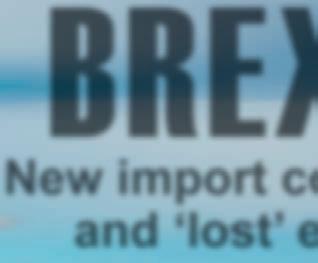
BREXIT
New import controls and ‘lost’ exports


Why they could be Spain’s next seafood speciality
Arctic charr Sapphire Springs gears up for growth


Aviemore Aquaculture UK show preview


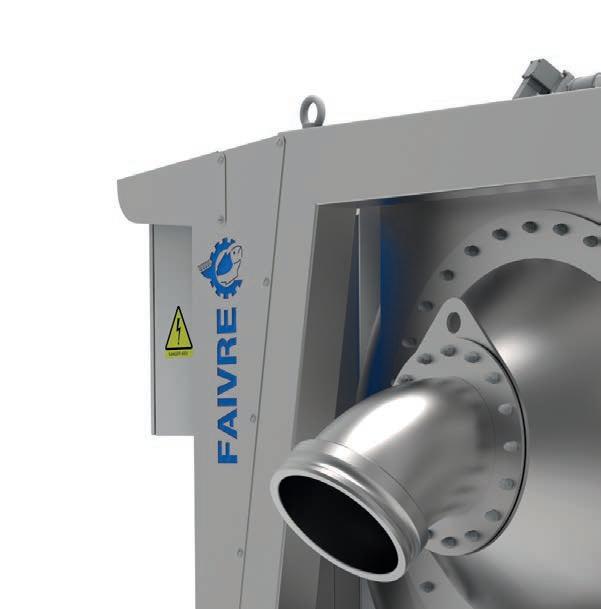



Pescamotion 50 (10‘‘), high speed loading and transfer Fish Pump

Meet us booth # A 11




 High quality fish farming equipment
Designer & Manufacturer since 1958
High quality fish farming equipment
Designer & Manufacturer since 1958













MORE than four years after the UK officially left the European Union, the implications of Brexit continue to reverberate through the economy.
The slogan that helped to sway voters in favour of leaving was “take back control.” In practice, however, that appears to have been adopted by the UK’s European neighbours more readily than by the UK itself. For the seafood trade, it has meant a huge growth in paperwork and inspection protocols when exporting to EU countries, while up until now, the UK has been reluctant to impose such controls for products going the other way.
That all changes this month, however, as Sandy Neil reports in this issue. Physical border inspections are being introduced and it is still unclear how much of an impact that will have on incoming seafood from the EU and countries such as Norway. What is apparent is that the UK industry, while it is not keen on red tape in either direction, wants to see a level playing field operating in this marketplace.
Salmon Scotland argues that the loss in potential trade with the EU, for Scottish salmon alone, is worth £100m annually. Tavish Scott, the industry body’s Chief Executive, explains why in his Fish Farmer column.
Also in this issue, we meet a businessman from Spain who is looking to raise Europe’s first commercially farmed sea cucumbers. While sea cucumbers may not be a fixture on European restaurant menus, they are highly prized by Chinese consumers and their increasing rarity as a wild catch commodity should make them a premium export product.
We also profile Canadian Arctic charr producer Sapphire Springs and explain why Norway’s rule against the export of poorer quality salmon is being contested by processors in the EU.
This month’s issue also features California’s fledgling seaweed industry and a project in Tasmania, funded by salmon farmers, that aims to save an endangered skate.
Meanwhile, we are also previewing Aquaculture UK, the country’s biggest event for the industry, which takes place in Aviemore next month. We hope to see you there!
Best wishes
Robert Outram







SCOTLAND’S fish farmers have succeeded in their bid to strengthen the rules over what is allowed to be called Scottish salmon .
The overnment has agreed to amend the protected geographical indication for Scottish farmed salmon to Scottish salmon . This means that any product described in this way will have to meet strict criteria. status initially part of the single mar et can apply to a wide range of food and drin products. n the case of Scottish farmed salmon this not only covered its geographical origin but also the production process and uality controls involved.

The Scottish salmon industry through Salmon Scotland as ed for the change to prevent unscrupulous traders from passing a product off as Scottish salmon even if for example it had only been processed in Scotland or if it failed to meet the same environmental and food safety standards as the genuine product.
From now on any product described as Scottish salmon must meet the same rules as Scottish farmed salmon .
The labelling decision by the epartment for nvironment Food
and ural ffairs efra means that farm raised salmon from Scotland will now have greater post rexit protection Salmon Scotland said to prevent the ris of food fraud through imports of inferior salmon products which could misleadingly be sold as Scottish salmon .
The new geographical designation will be the coastal region of mainland Scotland estern sles r ney and Shetland sles .
The overnment said that no admissible reasoned statement of opposition had been received. ny appeal against the decision would have to be presented by pril. The update replaces a previous for Scottish
farmed salmon given that wild Scottish salmon is no longer available for sale in supermar ets following decades of population decline.
Salmon Scotland stressed that it remains a re uirement of all seafood products on sale in the to list the production method on pac aging. The change of name does not affect this statutory re uirement so pac aging will continue to ma e clear that salmon is farm raised.
Tavish Scott hief xecutive of Salmon
Scotland said Farm raised Scottish salmon is a globally recognised brand and rightly considered the best in the world so it is vital that we ta e steps to protect our premium product from food fraud. hen consumers tal about Scottish salmon’ they are tal ing about farm raised tlantic salmon from Scotland and this change ma es that clear while boosting legal protection post rexit.
Scotland’s salmon farmers wor hard to rear their fish and this recognition by efra is testament to the commitment of all those in remote communities who continue to meet the growing demand for Scottish salmon at home and abroad.
BAKKAFROST says its Scottish arm is on a steady but positive road to recovery, despite the latest trading update, which shows a year-on-year fall in production for this year’s first quarter.
The Scotland division has reported a harvest of 7,300 tonnes for the January to March period. This compares to 8,100 tonnes a year earlier, when all of that total came from Scotland North.
Scotland South, which produced nothing 12 months ago, turned in 3,300 tonnes this time, while Scotland North produced 4,000 tonnes.
The Faroe Islands total was 14,300 tonnes, up from 11,000 tonnes last year.
Feed sales in Q1 2024 were 27,000 tonnes, up from 22,300 tonnes in Q1 last year,
Bakkafrost said Havsbrún sourced 136,900 tonnes of raw materials during the recent quarter.
Bakkafrost said in its annual report for 2023 that prospects for this year are bright, with increased biomass and larger fish in the water in both the Faroe Islands and Scotland, indicating robust biological health. It added: “Our strategic initiative, ‘One Company’, aimed at integrating our Scottish and Faroese operations, continues to progress effectively.
“In 2023, we streamlined processes and restructured the organisation to enhance efficiency, which included a workforce reduction of 75 employees in Scotland, in addition to the earlier mentioned layoffs in the Faroe Islands due to adjustments in value-added processing in response to tax changes.”
The report said Bakkafrost stood in an advantageous position with an increased biomass comprising a high share of large-sized fish (of which there is a shortage) of almost exclusively superior quality.
The full Q1 report, including financial information, will be published on 6 May.

















50 years of selection, innovation and precision led us here. Solid genetic foundation. High quality. All year round.








Our portfolio of products includes high-performing salmon genetics for sustainable salmon farming.
Benchmark salmon ova are the result of long-term breeding programs and intensive innovation, using the latest genomic technologies to develop traits adapted to face the challenges of net-pen and landbased farming conditions.
With land-based broodstock facilities, we can deliver high-quality, biosecure salmon ova all year round.
We are fully dedicated in supporting our customers in Scotland and Ireland to maximizing the potential of our genetics.
Learn more about our products at bmkgenetics.com


SCOTTISH-based marine support services business Underwater Contracting (UCO), already owner of the world’s largest fleet of Saab Seaeye Falcon ROVs, has added to its pool through the purchase of five new machines. The deal gives UCO a total of 38 Falcon systems.
The company, based in Aberdeen in northeast Scotland, said it has expanded its fleet in response to major new multi-year contract wins across all sectors, which will see it provide a range of services in Europe, North America and the Middle East.

VOLUNTEERS from Scottish salmon farms cleared away more than 23 tonnes of litter from Highlands and Islands beaches last year, as part of efforts to keep the areas they live and work clean. Data compiled from last year’s efforts has been published by industry body Salmon Scotland.
Salmon farmers take part in regular beach cleans throughout the year to ensure beaches and coastlines are free from litter and aquaculture debris. While some of the beach litter was related to aquaculture, the vast majority was not and had either been washed up on the shore or left behind by visitors.
THE impact of data, automation and cutting-edge tech on aquaculture will be among the key themes at the Blue Food Innovation Summit, taking place in London on 21 and 22 May. More than 350 leaders will be
joining from across the globe to forge partnerships and discuss solutions for a biodiverse, stronger and more sustainable blue economy. To find out more or to register, visit www.bluefoodinnovation.com
60-year salmon study helps to

THE most detailed long-term study ever carried out of Atlantic salmon in a Scottish river valley has yielded valuable insights, say researchers at the University of Aberdeen.
The data covers six decades’ worth of data on salmon populations and river conditions in Girnock Burn, Royal Deeside.
Atlantic salmon have long een identified as a threatened species because they need marine and freshwater habitats during their complex life cycle, and both are being affected by climate change.
To gain a greater understanding of this life c cle, fish traps were installed in 1966 in the Girnock Burn in Royal Deeside, between the royal estates of Birkhall and Balmoral, within the Cairngorms National Park.
Now, a research paper led by the University of Aberdeen, has highlighted the insights from long-term monitoring at the site.
Scottish Government and the Leibniz Institute of Freshwater Ecology and Inland Fisheries in Germany is the most detailed long-term study of an Atlantic salmon population in the world.
The study, which has been summarised and published in the journal Hydrological Processes, has revealed quantitative changes in the return rates, distribution, size, growth and age of salmon.
Professor Chris Soulsby of the University of Aberdeen has been involved in the Girnock study for more than 30 years. He said the strong dataset they have been able to capture over six decades provides vital science that can support salmon restoration efforts in Scotland, adding: “This is an internationally important salmon research site and, unusually, it has been accompanied by a wide range of related environmental research, which helps understand why salmon numbers have declined as a result of climate change, which mainly contributes to poor marine survival but also affects freshwater habitats.”


The Girnock, draining mountains and moorland, became of interest to scientists when it was identified as ha ing an important population of spring salmon fish that spend more than one year at sea and return to freshwater early in the year, coinciding with the start of the fishing season.
The work carried out there as a partnership between the University of Aberdeen, the Marine Directorate of
Six decades of ecohydrological research connecting landscapes and riverscapes in the Girnock Burn, Scotland: Atlantic salmon population and habitat dynamics in a changing world (C Soulsby, IA Malcolm, D Tetzlaff) Hydrological Processes, published March 2024.
HOPES for an effective vaccine against sea lice have been boosted with the news of a grant that is helping research into a further stage.
Partners from the University of Stirling’s Institute of Aquaculture, AQUATRECK Animal Health SL and oredun Scientific ha e een awarded almost £50,000 from the Sustainable Aquaculture Innovation Centre, after the initial proof-of-concept phase, which concluded last year, showed promising findings.
The latest stage involves assessing the impact of the novel vaccine technology against adult lice, building on the first part of the research, which looked at larval stages and identified a gut protein required for protection.
The team is using advanced recombinant expression technology for injection vaccination, a technique that involves implanting cells with a DNA vector that contains the required template for a desired protein and then culturing the cells so that they transcribe and translate the protein.
If successful, the technology could be scaled up to make mass antigens available, to
later be applied via salmon feeds as an oral vaccine.The formula has been developed to trigger an immune response and create elevated antibody levels in the bloodstream of fish, helping to impair sea lice development and reproductive capacity following sea lice feeding on the fish. he accine could also reduce the number of parasite offspring.
Dr Sean Monaghan, lead researcher and lecturer at University of Stirling’s Institute of Aquaculture, said: “Finding a vaccine-based solution for treating sea lice would be a huge development for the aquaculture sector globally... we are hoping that this second stage of the project will demonstrate the efficac of the vaccine for protecting Atlantic salmon against adult lice and help to uild the scientific evidence base.”

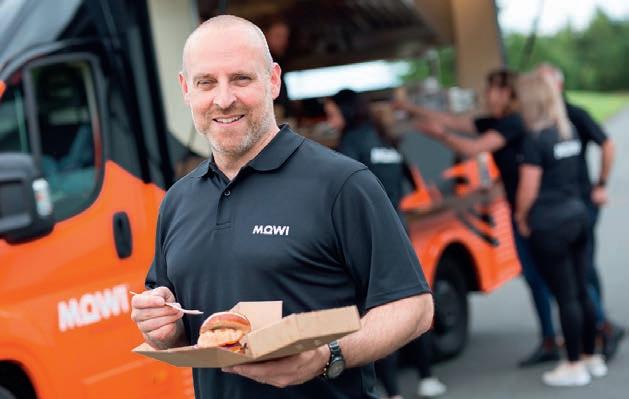
MOWI’S long-time Director of Communications for Scotland, Ireland and Canada, Ian Roberts, is set to join the ranks of ex-Mowi alumni this summer.
The company said that Mowi and Roberts reached mutual agreement to end the position with effect from 1 August 2024.
Roberts (pictured, taking part in Mowi’s Salmon Wagon community initiative) has been with Mowi since 1993, with a number of positions held in salmon production and communications spanning his 31-year career.
He said: “I’ve thoroughly enjoyed the various career opportunities that the company has entrusted to me.
“From leading the salmon aquaculture partnership with the Kitasoo Xai’xais First Nation in British Columbia during the first half of my career, to directing communications in Canada and Scotland over the past 15 years and having the opportunity to work with fabulously smart and caring people, it has all been rewarding for me personally.”
Ben Hadfield, Mowi’s COO Farming (Scotland, Ireland the Faroes and Canada East), said: “Ian’s leadership and confident presence in communications has been a strong asset for Mowi and for the wider salmon farming sector. His confident, passionate approach alongside strong respect from communities where salmon is produced has led to trust and a greater understanding of our business. I wish Ian all the best in his future endeavours and hope that he will remain closely involved in the aquaculture sector in some capacity.”
THE gap between salaries for male and female employees at salmon producer Scottish Sea Farms widened as a result of its acquisition of Grieg’s Shetland assets – but the latest figures show that the company has regained its position on gender parity and closed the pay gap further in several areas.
UK legislation requires that large companies report on their gender pay gap. Last year, the figures showed that the acquisition of Grieg Seafood Shetland, which meant an additional 146 men and 40 women joined the team, had led to a wider gap.
However, the company’s 2023 gender pay gap reporting confirms that Scottish Sea Farms has not only returned to its pre-acquisition position but also made slight advances, aided by ongoing work to benchmark and align pay grades across the integrated team.
Advances achieved include:
• a 3.8% reduction in women’s mean hourly pay gap;
• a 5.4% reduction in women’s median hourly pay gap;
• 1.2% more women in the top pay quartile; and
• 28.6% more women receiving bonus pay.
Fiona McCann (pictured), Head of HR at Scottish Sea Farms, said: “The key takeaway from the latest reporting, as our mean average hourly pay shows, is that female colleagues are paid on a par with their male counterparts – or, as with this snapshot, slightly more.
“What we can’t ignore, however, is that salmon farming was seen as a primarily male

career for many years. As such, we have significantly more men on the team than women, some 82% to 18% in 2023, impacting other measures.
“So while there remains no difference in median bonus pay – in other words, the middleearning male and female received the same bonus – the simple fact men outnumber women in each pay quartile, including those in which bigger bonuses are often paid, contributed to our mean bonus pay gap widening in 2023.”
The single best way to close this and other gender-related pay gaps, says McCann, is to attract and retain more women into the company and sector.
“Our priority has been and always will be to hire the best candidate for the job. We’ve made real progress, with 109 women on our team currently in roles ranging from freshwater technician and fish vet to environmental scientist and supply chain coordinator – but we’d like to see many more.”
BREXIT has cost Scotland up to £100m each year in “lost” salmon exports, according to the industry body, Salmon Scotland.That’s what the organisation’s Chief Executive, Tavish Scott, told MSPs in the Scottish Parliament last month.
He was addressing MSPs on the Constitution, Europe, External Affairs and Culture Committee as part of their inquiry into the EU-UK Trade and Cooperation Agreement – which is up for review after the general election.
Scottish salmon is the UK’s largest food export, but farming companies have faced increased red tape and costs triggered by the departure from the EU in January 2020.
In 2019, there were more than 53,000 tonnes of Scottish salmon exported to the bloc, with the figure falling to 44,000 tonnes in 2023.
Export values to the EU were only down 3% to £356m because strong global demand drove up prices, but if the sector had maintained volumes at 2019 levels, then sales would have been above £430m.
That means there has
been a net “loss” of around £75m or up to £100m had the sector grown at the rate previously expected.
The Brexit impact has been mitigated by huge growth in other markets, particularly Asia and the US.
Overall international sales in 2023 were up from £578m to £581m (up 0.5%), including a 7% increase to the US and 22% to Asia.
However, with salmon increasingly popular in traditionally smaller European markets such as the Netherlands and Spain, smoother trade flow and new markets would open up the possibility of further economic growth – generating greater investment in the Scottish economy and more highskilled Scottish jobs, Salmon Scotland says.
The estimated Brexit impact of lost sales does not include the direct £3m-a-year cost to farming companies in terms of extra administrative costs because of the lack of an e-certification scheme.
See also the Salmon Scotland column on page 30 and more on import controls on page 42.


SCOTTISH Sea Farms has taken delivery of the first batch of “green” (unfertilised) eggs at the new £2m incubation unit at the company’s Barcaldine Hatchery.
The move is part of a strategy aimed at making the company’s operations more self-reliant in terms of ova supply and less dependent on imported eggs.
This batch, which were fertilised on-site in a first for the company, are doing well so far, according to Scottish Sea Farms’ Head of Freshwater Rory Conn.
He said: “The incubation unit is designed to receive eggs immediately post-stripping, giving us greater control in the earliest days of the production cycle.
“We trialled two smaller test batches in Q4 2023 ahead of receiving our first full intake of around three million green eggs either side of Christmas.
“These were fertilised on arrival at the new unit.”
Scottish Sea Farms conducted a series of assessments, from evaluating the success of the fertilisation process within the first 24 hours to checking embryonic development around the 60-day stage.
When the eggs reach the eyed ova stage, they will go through a further quality check to ensure only the viable ones are transferred to incubation trays in the hatcheries.
Conn said: “From the results to date, we know already that the quality of water in the green egg unit has mitigated a number of the issues we had been seeing with our intakes of eyed ova.”
The eggs stay in the incubation unit, which is adjacent to the main Barcaldine Hatchery, for six weeks to five months, depending on requirements, before being moved to one of Scottish Sea Farms’ three hatcheries: Barcaldine itself, Knock on the Isle of Mull or Girlsta in Shetland.
The new facility enables the eggs to be incubated for longer, at lower temperatures, during the most fragile stages of development.
“We have taken the temperature down to below 2°C which, research suggests, results in better outcomes for fish health later on, particularly cardiac health,” said Conn.
He added: “By incubating the eggs over a longer period, we can meet our year-round demand for eyed ova, ensuring security of supply.
“From this initial batch alone, we will be able to put close to 600,000 smolts into one of our marine farms at the required time – around late August next year.
“Without the green egg unit, it simply wouldn’t have been possible to produce smolts from Scottish-sourced ova at this time of year.”
The new unit benefits, Scottish Sea Farms said, from the same purity of water and state-of-the-art recirculating aquaculture system technology as the company’s neighbouring Barcaldine Hatchery.


THE Scottish Government is calling for innovative ideas to help transform the country’s blue economy – with £14m in grant funding on offer this year.
Applications are invited for grants from the Marine Fund Scotland, which is now in its fourth year.
Addressing the Fisheries Management Scotland conference on 28 March, Cabinet Secretary for Rural Affairs, Land Reform and Islands Mairi Gougeon confirmed that m will e made available through the fund in 2024 to 2025 to help deliver Scotland’s Blue Economy Vision, which sets out plans to transform the way the marine environment is used and how Scotland’s
blue resources are managed.
The funding is available to a wide range of eligible individuals, businesses, organisations and communities to deliver projects that contribute to an innovative and sustainable marine economy, support coastal communities and contribute to Scotland’s net zero ambitions.
Last year, a total of 91 projects were awarded funding, with grants ranging from under £1,000 up to £1.6m. These projects included the modernising of seafood processing facilities to reduce energy consumption and improve efficienc har our impro ements such as community clean-ups and marine litter pre ention impro ements to safety training and on-board safety for sea fishers trials of new technolog to protect farmed fish against sea lice and ell fish and marine research and innovation to protect Scotland’s iconic wild salmon.
Gougeon said: “The Marine Fund Scotland supports a wide range of exciting and innovative projects delivering on our Blue Economy Vision.
Congratulations to those organisations and individuals who have already made successful applications – it’s fantastic to see that Scottish Government funding is playing an important role in helping our marine industries to e ol e and flourish. I am looking forward to seeing the types of projects that apply for funding in this fourth year of the fund.
“However, while the fund is critical in delivering on one of our three core government missions – opportunity: building a fair, green and growing econom we no longer ha e sufficient funding to support longer-term investment.
“Marine funding in Scotland continues to be short-changed by the UK Government so, as well as ensuring the full allocation for the Marine Fund Scotland is maintained in future years, we will keep pressing the UK Government to uphold their commitment to replace lost EU funding in full, so that we can continue supporting innovative projects in our marine sectors and coastal communities in the future.”
ANTI-salmon farming activist Don Staniford has lost his appeal against a Sheriff Court order barring him from Mowi’s farm sites in Scotland
Staniford has for many years used covertly filmed video and photography of fish farming sites to back up his argument that finfish aquaculture is damaging to the environment and to the fish being farmed. His typical approach has been to row to the farms by kayak at dawn before staff arrive on site.

Mowi Scotland had sought an interdict under Scottish law to prevent Staniford from trespassing on 47 named farms and their equipment or approaching within 15m of
those sites. In October last year, this was granted by Sheriff Andrew Berry at the sheriffdom of North Strathclyde at Oban. The Sheriff Appeal Court rejected Staniford’s grounds for appeal on 14 March, ruling that the test for interdict had been correctly applied, observing: “An award of perpetual interdict does not require harm to be established. Interdict is available to prevent unlawful conduct. The pursuer has a right of ownership in the structure of the marine farms, extending to the whole of the structure. It is entitled, as of right, to prevent the defender entering upon or interfering with the structures.”
A NEW study aims to use tagged lobsters to help assess the positive impact of offshore shellfish a uaculture on marine ecology.
Scientists mussel farmers and fishers on the Devon and Dorset coast have started the tagging work that will help them assess the impact of offshore a uaculture on the general health of the ocean.
The Ropes to Reefs project – funded through the Fisheries Industry Science Partnership scheme, part of the government’s UK Seafood Fund is loo ing to assess the wider benefits of the ’s first large scale offshore mussel farm located in yme ay.
It is being led by scientists at the University of Plymouth working with a range of partners,
including producers such as ffshore Shellfish Ltd, Scallop Ranch Ltd, Biome Algae Ltd, as well as various local and national fishing and conservation organisations.
Work has begun to tag lobsters living in and around the mussel farm.
This means the project team can gain a better appreciation of their movements and the habitats they favour.
This will be followed up over the coming months with the tagging of thornback ray, blac bream and thic lipped mullet giving researchers a clearer picture of the mussel farm’s impacts on various species that are critically important to the region’s fishing industry.
The Ropes to Reef project builds on more than a decade of research at the university, funded by ffshore Shellfish td.


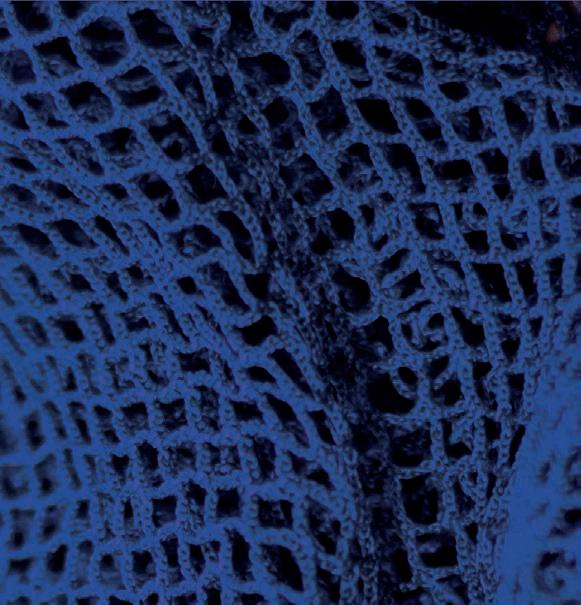


























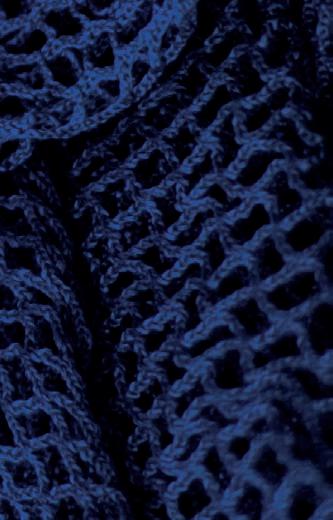



NORWAY’S amazing threeyear record of seafood export growth has finally stopped at least for the time being.
Figures from the Norwegian Seafood ouncil show a fall in the value of sales including salmon both for last month and over the first uarter of 2024.
Norway exported NOK . bn almost bn worth of seafood between January and arch a decrease of N . bn or less compared to the same period last year.

three months of the year.
Seafood ouncil hristian Chramer said: “Thanks to a weak Norwegian rone and high prices there was growth in the export value in anuary and February. n arch however the currency effect decreased while at the same time there has been a drop in volume for a number of species in the first
The result was a decrease in the value of seafood exports in the first uarter.
Fisheries and Oceans Minister ecilie yrseth added Three consecutive years of export records clearly show that Norwegian seafood is in demand around the world.
lthough we are now seeing a slight decline there must be no doubt that the seafood industry is doing well.
t is still one of our largest and most important export industries.
The value of salmon exports during the first three months fell by to N . bn bn . The first uarter volume was down by to tonnes.
The arch salmon figure was N . bn m down by on the same month last year and down by in volume.
Seafood ouncil analyst aul T andahl said The fall in value for salmon is primarily due to reduced production and lower slaughter volume.
The reason is among other things lower sea temperatures compared to the same period last year. ncreased export of fillets at the expense of whole fish also contributes to the drop in volume.
A ROW is brewing over plans for a new post-smolt facility in the north of Norway – which will involve blowing up two small islands to make space for the construction.
The company behind the project is Gaia Salmon, which plans to produce between 8,000 and 10,000 tonnes of post-smolts weighing up to 800 grams annually, once the building is operational.
The site is at the Ross Islands at Træna in Nordland, where there are more than 477 tiny islands.
Gaia Salmon says the area involved covers about 12 to 14 football pitches in area.
The plan is creating no little controversy and has attracted a number of protests although the overall view from the local community is fairly positive, because the project would create many jobs for local people.
However, various national and regional conservation groups are calling for the project to be shelved.
Frode Solbakken of the Nature Conservation Association in Nordland told the broadcaster NRK:“We cannot blow up large parts of our coastal nature because we wantto get rid of
salmon lice on the farmed salmon.”
The local Labour party mayor Trond Vegar Sletten and the Træna municipality, however,are positive about the plans because it will provide up to 50 jobs, leading to more people settling in the area and building new homes. But the mayor admits it was not an easy decision to make.
He told national broadcaster NRK: “After all, we want to be a viable society. We who live here have faith in the future. But then we also have to be able to make these tough decisions on a sound basis.”
He also stressed the importance of Gaia taking steps to ensure that as many of the jobs as possible are actually taken up by local people.
Gaia Salmon general manager Erik Hernes told NRK that the company respected there were different opinions about the plan. He said: “ We are concerned with safeguarding and developing natural diversity at the same time as we develop industry and the local community.
“We collect all sludge in the plant and reuse this for energy for use in the plant.”
In that way, the company hopes to significantly reduce emissions at sea, while at the same time reducing its CO2 footprint by more than 30%. Gaia also says the facility will be a world leader in energy efficiency.
Below: aia Salmon facility
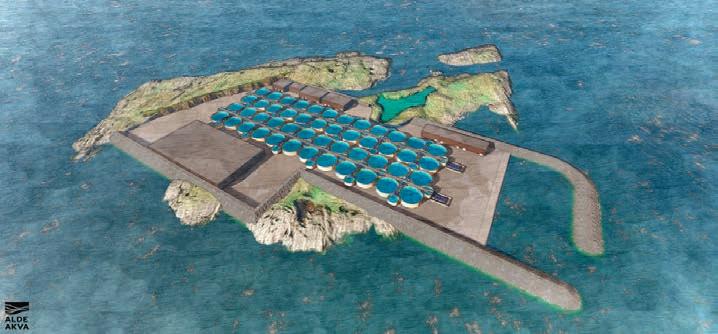
Pioneering a better future
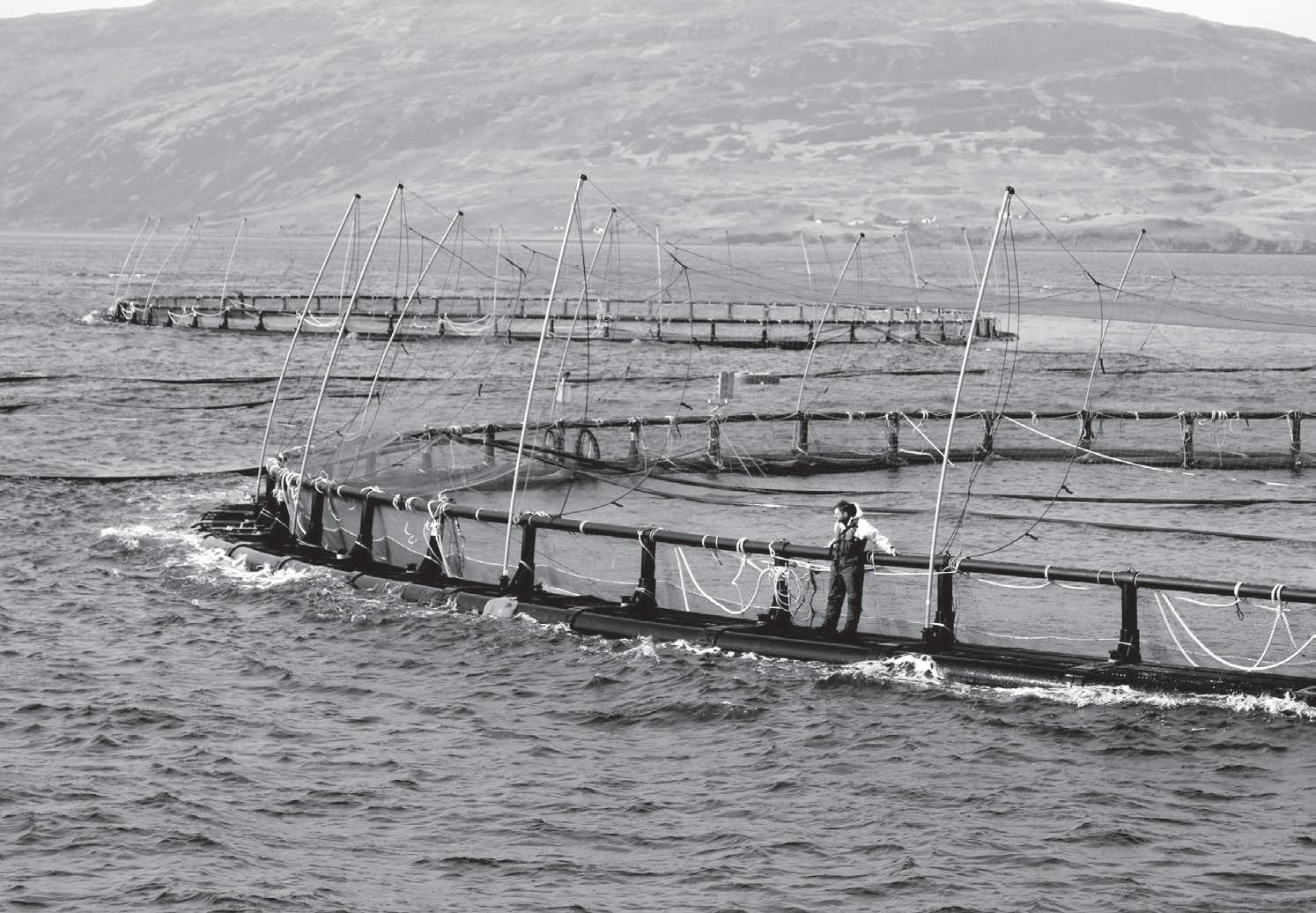
Celebrating 50 years of pioneering plastic pen production
akvagroup.com

FORMER Mowi CEO Alf-Helge Aarskog looks set to join the board of Faroes salmon producer Bakkafrost. The notice for Bakkafrost’s annual general meeting, which is due to take place on 30 April, includes his name on the list of directors submitted for election. Apart from Aarskog, all the others are existing board members up for re-election, including Chairman Rúni Hansen. Aarskog left Mowi
in November 2019 after 10 years with the salmon giant.



A NEW name in the aquaculture industry has made its debut on the Oslo Stock Market. The Torghatten Aqua group, an investment business specialising in aquaculture and aquaculture training, will become the ninth-largest company among some 40 businesses on the Norwegian over the counter (NOTC) list of the Oslo Børs. Øyvind Løvdahl, CEO of Torghatten Aqua, said: “Listing on NOTC was a promise we made to the shareholders when we raised capital via Folkeinvest (a platform for buying shares in unlisted companies) last year.”

KRILL harvesting company Aker
BioMarine has won this year’s nnovation Norway and sfin export award. The company was able to convince the jury that it is possible to achieve success through a “targeted, sustainable and innovative strategy”. The award was announced at last
month’s xport onference held by nnovation Norway and sfin the Norwegian government’s export finance agency at the MUNCH Museum in Oslo. Krill is used as both fish and animal feed. In addition, there is a growing consumer market that sources high-quality proteins from krill.

CERMAQ has become the latest large Norwegian salmon company to be hit by a major biological issue.
The company has been forced to cull fish with wounds in six cages at its facility near Hammerfest. The fish weigh around g on average.
Earlier, the Lerøy Seafood Group reported almost half a million young salmon deaths at its Sjøtroll facility in western Norway.
Cermaq said it has taken the action due to a demanding fish health situation, which appears to have developed over time.
The company has been in engaged in a lengthy period of contact with the Norwegian Food Safety Authority. Cermaq has now decided to remove, stun and euthanise the fish concerned.
Cermaq Regional Director Gunnar Gudmundsson said: “This has been a desperate situation, where we have seen increased mortality in these cages since the beginning of January this year, as a result of ellyfish and a period
of stormy weather, which has subsequently led to a bacterial wound infection.”
He added: “We have had a close dialogue with the Norwegian Food Safety Authority and implemented measures to improve the situation, with increased withdrawal of wea ened and dead fish.
“Despite measures, the situation has not changed and considering the time of year and low sea temperatures, we fear a further deterioration.”
He stressed it was necessary to take such action for the sake of fish welfare.

THE Icelandic Food Agency, MAST, has renewed the operating licence of Arctic Sea Farm, a subsidiary of Arctic Fish, at two key sites. The decision allows for up to 7,800 tonnes of salmon.
The sites are at Patreksfjörður and Tálknafjörður in the Westfjords region of the country.
Arctic Fish, which is majority owned by Mowi, is one of Iceland’s largest salmon farming companies with total licences for up to 29,800 tonnes.
There was some opposition to the plan and MAST has said that individuals and organisations can appeal its decision to the Environmental and Natural Resources Appeals Committee. The appeal deadline is one month from the publication of the notice going out.
Arctic Fish had a difficult year operationally in 2023, following a large escape into Patreksfjörður, which led to MAST requesting an official inquiry.
Local police were called in to investigate the incident but later
decided to take no further action. The company later apologised for the incident, stating it had been working day and night to establish what happened.
Despite the escape problems
Arctic Fish, enjoyed a fairly good year financially, producing an operational EBIT of £2.7m. The company said the financial and biological performance improved somewhat after a challenging third quarter when the escapes took place.
The fourth quarter harvest volume was 2,529 tonnes gutted weight in the fourth quarter, exceeding the guidance volumes.
Harvest volumes for the full year of 11,878 tonnes reached an alltime high for Arctic Fish.


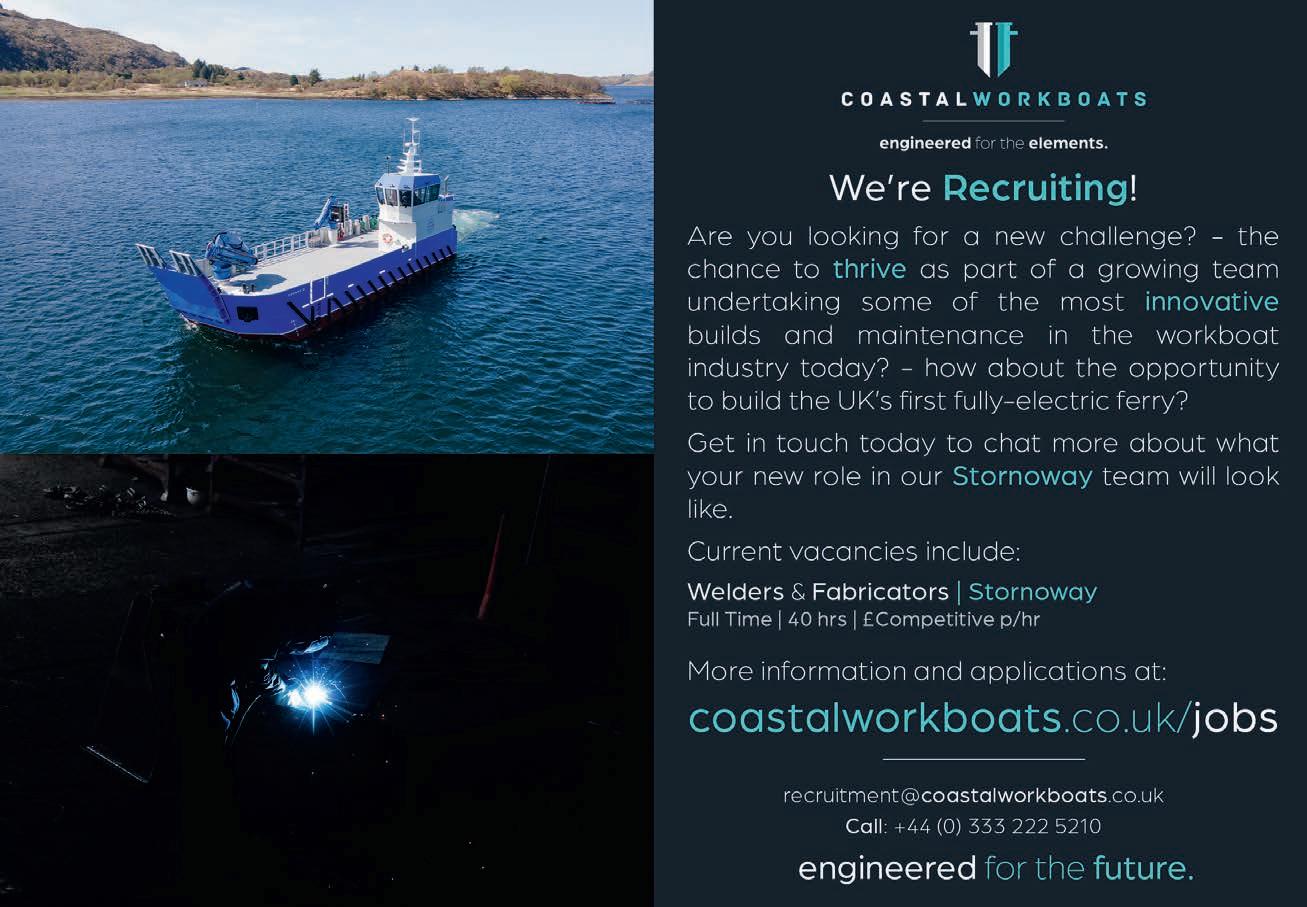

PLANS for a fish farming superyacht, the Ocean Ark, have moved a step closer to reality, with an agreement between assurance and risk management provider DNV and the developers, aimed at securing registration as a French vessel.
The Ocean Ark, a patented advanced self-cleaning trimaran superstructure incorporating fish pens into its design, was developed by Ocean Sovereign according to Marpol, Solas and International Maritime Organization regulations.
The 170m-long vessel is projected to have a biomass capacity of up to 4,000 tonnes. As a mobile platform, its developers believe it will be better able to avoid algal blooms, marine heatwaves and storms.
As part of the collaboration deal, DNV will support Ocean Sovereign with business-critical challenges and innovations, designed to prevent fish escape and reduce the risk of technical failure in operation by delivering:
• classification of the floating structure/vessel and marine systems;
• certification of mooring/ dynamic positioning system;
• certification of aquaculture nets and systems; and
• assessment operation and integrity controls during the design lifetime.
The Ocean Ark is designed to operate in high-energy offshore waters, drifting with the natural current and natural fish shoals. It is designed to ensure sufficient safety for the environment, fish and crew.
Ocean Sovereign said: “The mobile nature of Ocean Ark will help to ensure the health and
welfare of the fish and ensure that the fish are kept in their natural habitat.”
Cross-industry know-how DNV is an independent assurance and risk management provider, operating in more than 100 countries. Its roles include certifying products, verifying claims, creating new assurance models and optimising and decarbonising supply chains.
“Offshore fish production is based on a combination of two well-known concepts: fish farming and offshore technology. Therefore, a cross-industry approach and know-how is needed,” explains Ocean Sovereign General Manager, Zeyd Fassi Fehri. “At Ocean Sovereign, we are happy to join forces with DNV and benefit from their knowledge gained through decades of experience in these two fields that will allow us to safely deploy the vessels. We believe that DNV’s extensive experience in offshore and fish farming will help us to play a key role in the deployment of our vessels under French registration.”
In addition to its high-quality standards and being Europe’s largest market for salmon, France has one of the largest maritime exclusive economic zones.
“As well as sustainability and fish welfare, the inclusion of local communities is embedded into every Ocean Sovereign project. The deployment of the Ocean Ark offers many synergies and growth opportunities for the existing local aquaculture and fishing sector,” said Zeyd Fassi Fehri.
“To seize these opportunities, agreements have been reached with French aquaculture and fishing stakeholders and will be released shortly.”
THE CEO of Norwegian landbased fish farmer Gigante Salmon has left the company after a warning that construction costs for the completion of its site at Rødøy are now expected to be more than 50% higher than the previous estimate.
The news that CEO Helge EW Albertsen has had his contract terminated broke in March. Albertsen will continue to serve as an adviser to the company, while non-executive board member Kjell Lorentsen has been appointed as interim CEO. Lorentsen was formerly CEO before the appointment of Albertsen in 2021. The company said: “The work to recruit a new CEO to the company has been initiated.” Company shares dropped 20% on the
Oslo Stock Exchange after the news. The latest projected cost increase is approximately NOK 350m (around £26m), taking the total investment needed to complete the facility to around NOK 995m (£73m).
The forecast increase is mainly due to longer construction time, including costs for rigging and operation.

The company’s board, in a stock market statement, said the figures are still subject to control, quality assurance and dialogue with suppliers.

The statement went on: “The cost increase will require new capital to the company. This work has been initiated. The plan is that the cost increase will be covered through a combination of equity and debt financing.”
NORWEGIAN super striker Erling Haaland is to become an ambassador for the country’s seafood industry.
The prolific anchester ity forward has signed a deal with the Norwegian Seafood ouncil. He will appear in commercials, promotional posters and digital ads worldwide as part of the collaboration. The deal will last for two-and-a-half years and came into effect on aster onday.
Haaland said: “Seafood has been part of my upbringing and my diet growing up. Norwegian seafood, which I consider to be the best in the world, still has a natural place in my life.
“The Norwegian Seafood ouncil does an important ob of inspiring and building knowledge about tasty and healthy seafood globally and at home in Norway” Haaland, who was actually born in Leeds when his father was involved with the Yorkshire club, has become a footballing sensation since oining anchester ity from the German club Borussia
Dortmund in July 2022. He scored goals in his first season with anchester ity.
hristian hramer of Norway’s Seafood ouncil has called the signing a great deal for Norway’s seafood industry.
He said: “Haaland is recognised as one of the world’s best footballers and is a gigantic profile with unrivalled global visibility.
“The match with Norwegian seafood, which is in demand, bought and en oyed all over the globe, is obvious. Being able to combine two of Norway’s best exports and strongest brands fills us with enormous pride. A separate deal has also been struck with Norway’s two national soccer teams, women’s and men’s.


NORWEGIAN regulators have called a temporary halt to further cod farming applications, particularly those at new locations.
The sector has been growing so fast that the Norwegian Food Safety Authority (Mattilsynet) wants time for everyone to draw breath and examine any biological or related implications. Whether growth resumes will depend on an assessment of the risks to wild cod.
The authority told Fish Farmer: “There has been a temporary delay in the processing of applications for the establishment of localities for cod farming.
“The reason for this is based on the increasing number of applications for cod farming [over] the last years and the lack of knowledge about the risk of the spread of infection between farmed cod facilities and between farmed cod and wild cod populations.
“The Norwegian Institute of Marine Research’s (IMR) risk report from 2022 points out that an increase in biomass linked to already given permits for cod farming will entail a risk of negative impact on populations of wild cod along the coast.
“In recent meetings with the IMR, it was again stressed that there is still a lack of knowledge concerning the spread of diseases, but the IMR has now started several projects to give more concise answers and advice to clarify these emerging aspects.”
The authority pointed out that there had been a significant increase in the number of given cod permits since 2022.
Some of the approved locations had not yet started for various reasons, but it was important to point out that if all the permits had become operational, the risk of infection would probably be higher by now.
It added: “The Norwegian Food Safety Authority will, until the IMR can give us more detailed advice, use precautionary principles as a basis for processing applications for establishment of cod farming.
“In addition, the Food Safety Authority wants to have a dialogue with the Ministry of Trade, Industry and Fisheries, and based on this dialogue, we will get further information on how applications will be handled in the future.
“Therefore, we cannot give a date for when the processing of the applications will start again but we will wor to get clarifications in place as quickly as possible.”





RESISTANCE is growing against a plan to build a huge land-based salmon facility at a former mountain mining site in Norway.
The project, which will trade as World Heritage Salmon, is being opposed by a number of environmental groups, however. The latest to come out against it this week is the national archive organisation, Riksantikvaren.
The company behind the proposed farm is Hofseth, which is planning to use the site on the Sunnylvsfjorden, an abandoned olivine mine, for a flow-through facility producing up to 100,000 tonnes of salmon per year. It would be one of the largest of its type in the world.
It will comprise 15 tunnels housing the fish tanks, utilising flow-through technology, and would benefit from its own smolt facility nearby.
The site, in Møre and Romsdal county, is not far from the Geirangerfjord World Heritage site, northeast of Bergen, designated as an area of exceptional national beauty by the UN agency UNESCO. Riksantikvaren told the broadcaster NRK that it fears discharges into the fjord from the land farm would threaten the natural balance of the area.
Its spokeswoman, the antiquarian Hanna Geiran, said: “The world heritage status hangs particularly high and only the most valuable places in the world are entered on the list.”
She also maintained the release of nitrogen into the fjord would be damaging.
Norway has committed to comply UNESCO’s regulations and Geiran said that it is the Riksantikvaren’s responsibility to see to it that we take care of these values.
She also fears for marine life in the fjord, geological values and consequences for world cultural values, if the farming facility is built.
Hofseth believes that its project will be environmentally friendly and will not have any effect on the area. The county’s planning authority has approved the plan and the Norwegian Directorate of Fisheries has also determined that it will not have an adverse impact on the environment.
FISH farmer iddenf ord has become the first salmon company in the Faroe Islands to achieve the maximum Best Aquaculture Practices (BAP) four star designation following the certification of its freshwater hatchery, Fútaklettur. is a third party certification programme developed by the Global Seafood Alliance S an international not for profit trade association headquartered in the United States, dedicated to advancing environmentally and socially responsible seafood practices through education, advocacy and third-party assurances. s feed is sourced from certified mills operated by Skretting and Havsbrún, Hiddenfjord now has the maximum BAP star designation and use of the four-star logo. The freshwater facility at Fútaklettur was the last link in the chain.
Óli Hansen, Sales Director at Hiddenfjord, said: “In our interactions with business partners, the BAP accreditation emerges as a marker of excellence, epitomising our dedication to premium salmon production,” said “Attaining our fourth star is not merely an accomplishment but a testament to our relentless pursuit of premium quality and sustainability. We look forward to sharing its implications with our customers, ensuring they benefit from our commitment to sustainable salmon farming.”
“It’s been an impressive journey for
Hiddenfjord to certify their whole production chain,” said Iain Shone, Director of Market Development for Europe at GSA. “They committed to four star from the outset and put a huge amount of work into this project. I know the whole team is really proud of their achievement. Well done!”
Hiddenfjord is a family-owned business with an emphasis on high-quality and sustainable fishing practices with roots dating bac to . The Faroese company is the first salmon producer in the world to stop all distribution by air freight, reducing its CO2 emissions for overseas transportation by 94%.

FEWER escaped salmon are getting into Norwegian rivers, according to the latest annual survey.
OURO, the aquaculture industry’s association for dealing with escaped farmed fish, says that fewer of these salmon migrated up the rivers in 2023 than in previous years.
It adds: “This is positive because fewer escaped fish in waterways before spawning reduces the impact on wild salmon.”
OURO saidthe national monitoring programme was assessed in some 195 watercourses.
Of these, OURO selected 38 rivers for fishing. Fishing of escaped farmed salmon was carried out in 20 of these rivers.

The rivers were selected on the basis of historical features of escaped salmon in the watercourse, vulnerability and proportion of escaped fish in 2021, or based on a decision that it may be appropriate to follow the development in the watercourse over time.
In 17 of the investigated rivers, no escaped salmon were observed during the autumn of 2023.
Due to heavy rainfall, high water flow and poor visibility, however, it was difficult to calculate the proportion of escaped fish in the spawning stock in some rivers in western Norway.
In addition to fishing in rivers, OURO has contributed to the collection of escaped fish with fish traps in Trøndelag.
The results from the removal of escaped farmed fish in rivers and seas for the autumn of 2023 show that a total of 226 escaped farmed fish were removed.
For 30 of the 31 rivers in which calculations of the number of escaped fish had been made, the proportion of escaped farmed salmon after harvesting was below 4%.
“Since the start of OURO in 2015, there have not been as few escaped farmed salmon recorded in the rivers as in 2023,” said chairwoman Ingrid Lundamo.

NORWEGIANS are becoming increasingly negative about salmon farming, according to new polling.
The survey was carried out by Norwegian broadcaster NRK public radio and follows a series of reports about large salmon death numbers from various biological issues.
But the industry organisation Seafood Norway believes that views would be different if there were more positive reports about the industry.
NRK said the attitude of Norwegians towards farmed salmon had changed a great deal recently. Some 37% of
those questioned said they were more negative about farmed salmon than before.
Most of those who have changed their minds, which included many older people this time, said that ethical and environmental factors had become the main drivers.
The industry organisation Seafood Norway believes that attitudes would change if there was more positive news about the industry in the general media. People tend to react based on how things are reported, it says.
And Trond Blindheim, an associate professor at the University of Kristiania, told NRK that the farming companies need to get their act together.They had a tough task ahead of them and they needed to restore the industry’s good reputation.
Seafood Norway said it took people’s concerns seriously.
NORWAY is preparing to impose a production tax on foreignowned aquaculture businesses, it has emerged.
The tax, which will also affect employees, will apply to those companies which farm offshore in Norwegian waters on the continental shelf.
Finance Minister Trygve Slagsvold Vedum has submitted his proposals for public and parliamentary consultation.
Vedum said: “We want to ensure that the community gets a rightful share of foreign companies’ value creation in Norwegian areas and therefore make some necessary tax measures to ensure national control.”


•
•
•
Vedum said his plans will, for the moment, apply to those companies which farm offshore.
Vedum has set a deadline of 17 June for comments and he wants the new tax to start next year.
The minister said the country was preparing for growth in offshore fish farming activity on the Norwegian continental shelf.
“We want to ensure that the community gets a rightful share of foreign companies’ value creation in Norwegian areas,” he added.
One of the main criticisms when he unveiled the ground rent tax (also known as the salmon tax) on Norwegian aquaculture businesses, over two years ago, was that it only fell on domestic businesses, while overseas-owned businesses and their executives were exempt.

The Hydrotech Drum Filter Value series focuses on reduced maintenance, increased component quality and simplified operation – all to give your plant maximum filtration performance at a minimum operational cost. Contact
INDIA’S extensive shrimp farming industry has been accused, in a new report, of large-scale human rights violations and unacceptable employment practices.
The report has been published by the international human and labour rights organisation, Corporate Accountability Lab (CAL), which carried out a three-year investigation into India’s multi-billion dollar shrimp aquaculture industry.
The CAL report, Hidden Harvest, says: “Over the past decade, India has emerged as the United States’ leading source of shrimp, the most consumed seafood in the country.
“However, this success is marred by a production process that relies on forced labour, dangerous and abusive working conditions, and environmental destruction to meet demands for ever-lower prices.
“While countries such as Thailand, China and Bangladesh have faced criticism for similar abuses, India, which supplies almost 40% of US shrimp imports, has remained under the radar with little public scrutiny – until now.”
The CAL investigation found that the Indian shrimp workforce is primarily composed of workers from Dalit, Adivasi and fisher communities many of whom are internal migrants and from regions with few employment options.
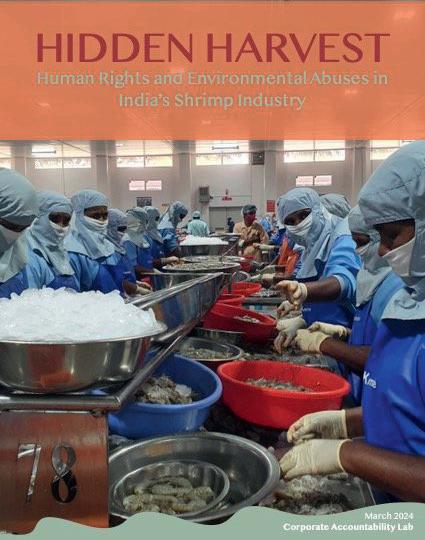
Migrant workers are particularly vulnerable to exploitation, the report says, because they are far from home, may lack social networks and often have few other job opportunities.Through recruiters, companies prey on the vulnerability of those needing work. Recruitment loans tie workers to jobs, keeping them in debt bondage. Most workers in the Indian shrimp industry lack contracts with their employers, resulting in job insecurity and the absence of a formal connection to companies.
CAL says: “These hidden, informal
THE giant Chilean fishing and aquaculture group Camanchaca saw its profits fall last year.
The company has blamed higher costs and weak demand for salmon, particularly during the second quarter of 2023.
The group earnings came out around 5% higher at almost US $762m (£607m), of which US $353.9m (£282m) was from salmon.
The salmon division suffered with smaller Atlantic salmon volumes and lower prices of farmed

species. There was also an increase in feed costs and health incidents.
Camanchaca was one of the founders of Chile’s aquaculture industry. Its main aquaculture production is centred around Atlantic and Coho salmon and rainbow trout.
The fishing division turned in a strong performance, although higher fuel prices took some of the shine off its performance.
Atlantic and coho salmon prices were down. There was also a sharp increase in production costs due to various health issues. The industry also faced higher feed costs. The company’s EBITDA was around 27% down on 2022 at US $90m.
workers are at high risk for forced labour – especially those whose housing is tied to their employment, a common practice across the supply chain.Workers report an exploitative relationship with employers and feeling trapped in abusive jobs with few alternative means to earn a living. Child labour is also prevalent, with young teenage girls working in processing facilities to help support their families.”
Chicago-based CAL says its report challenges the current narrative and issues an urgent call to action. As demand for shrimp continues to grow, so must the pressure on companies and governments to identify and remedy the sector’s pervasive forced labour, abusive conditions and environmental harms, the report argues.
It calls on American retailers and wholesalers to push for changes in the Indian shrimp sector and to promote the implementation of agreements between companies and independent worker organisations.
CAL also says the US and Indian governments should vigorously enforce laws meant to prohibit labour and environmental abuses, reducing the ability of companies to ignore accountability.
COOKE Seafood has abandoned plans to win back leases at its two Washington state trout farms in the US, blaming delays by the state’s administration, which it says make the case futile.

In November 2022, Department of Natural Resources head Hilary Franz ordered that leases for the farms, the last remaining net-pen aquaculture operations in the state, should not be renewed.
The company’s Superior Court motion had sought a reinstatement of Cooke’s leases at the Rich Passage and ope sland steelhead trout fish farms in uget Sound. Since the injunction was issued against DNR in January 2023, Cooke said it has endeavoured without success to obtain public records from DNR that it believes are needed to allow for a fair appeal hearing. Cooke’s statement said: “Based on the number of records that DNR claims are responsive to Cooke’s request, at the rate DNR has produced records to date, it would take another six to seven years for all responsive records to be produced by DNR, which is an untenable and inconceivable situation.”
Above: Hope Island steelhead farmProbably the most sustainable antifouling product for pen nets
► Powerful waterbased antifouling that offers excellent protection against fouling
► Safe for the fish and for the environment
► Protects against UV radiation
► Controlled leaking of the active ingredient
► Free from PFAS chemicals
► Free from microplastics
Slalåmveien 1, NO-1410 Kolbotn, Norway Ph.: +47 66 80 82 15 - post@netkem.no




When excellence in aquaculture is required you can rely on the services from MEST
We are part of the build and fabric of the Faroese salmon industry, constructing and maintaining the farming vessels, facilities and equipment.

We are proud to have supported world class salmon farming in the North Atlantic.
When world class is the demand - You can count on MEST.

Feed from Scotland helped Cooke produce t e st o anic a e sal on in ile
COOKE Aquaculture’s feed mill in Scotland has been playing a key role in helping to produce the company’s first organic salmon in Chile.The organic salmon now being harvested by Cooke Chile is that country’s first organic farm raised Atlantic salmon. Organic salmon will initially be equivalent to 25% of Cooke’s total salmon production in Chile. Organic feed
is not yet available in Chile, so the company provides feed from its affiliated feed mill in nvergordon Scotland, to aid in organic production.
To qualify for organic status, all feed ingredients used during production must also be organic, and fish oil and fishmeal used in the feed must come only from certified sustainable fisheries.

AQUACULTURE tech group
AKVA has entered into a partnership deal, which could help transform the hilean fish farming industry’s power setup. The deal is with two Norwegian companies: Inseanergy, which specialises in turnkey solutions for floating solar power systems
and Kverneland Energi.
The initiative aims at precision farming with minimal emissions, incorporating advanced hybrid battery systems, solar power plants, software and control systems tailored to meet the challenging demands of sustainable aquaculture.


POSEIDON Ocean Systems, the Canadian company behind the Trident sea cage system, has completed a US $20.75m
LAND-based salmon farmer AquaBounty Technologies has reported a year-on-year revenue increase of 23% for the last quarter of 2023, but the period also saw losses growing. AquaBounty has developed a genetically modified strain of salmon.
For Q4, the company recorded revenue of US $553,000 (£440,000) in product revenue, with US $451,000 (£359,000) for the same period in 2022. Net loss in the fourth uarter was up significantly at US $8.42m (£6.7m) compared with US $6.07m (£4.83m) in the fourth quarter of 2022.
For the year ended 31 December 2023, however, product revenue totalled US $2.47m, (£1.97m), a year-on-year decrease of 21% as compared with US $3.14m (£2.5m) in 2022. For the year ended 31 December 2023, net loss increased to US $27.56m (£21.92m), compared with US $22.16m (£17.63) in 2022.
Sylvia Wulf, Board Chair and Chief xecutive fficer of ua ounty explained that the revenue drop was largely down to an interruption

in production at the company’s Albany, Indiana, site early last year. AquaBounty’s business model depends on gearing to full-scale production at its site in Pioneer, Ohio.With faltering production in Indiana and a pause in construction in Ohio, the company has been burning through its cash reserves. As at 31 December 2023, AquaBounty held US $9.2m (£7.32m) in cash and cash equivalents, compared with US $102.6m (£81.61m) 12 months before.
Wulf said: “We announced in February 2024 that we had made the decision to sell our Indiana farm operation... additionally, we engaged Berenson & Company as our investment bank to advise on debt financing secured by our unencumbered assets.”
A-LIST Hollywood actor Leonardo DiCaprio has become the latest celebrity to come out against open net pen fish farming in ritish Columbia – but his stance has sparked a backlash from those indigenous groups who are backing the industry.
The star has criticised the Canadian government for extending the licences of salmon farming companies for up to six years to give them more time to adjust.

(£16.3m) capital-raising exercise. The Series B funding round was led by Ecosystem Integrity Fund and joined by InBC Investment Corp, along with additional investment support from one of Poseidon’s existing shareholders, Export Development Canada.
Poseidon said the funds raised will expand the company’s manufacturing capacity and support growth.
The Oscar-winning actor posted his criticism on Instagram, accusing Ottawa of breaking its promise. He said people should oin the fight against any extension and accused the Canadian government of breaking its promise to end net-pen farming by 2025.
But people in British Columbia are split on the issue, especially among First Nation groups.The Kitasoo Xai’Xais Nation issued a statement condemning DiCaprio’s
comments, saying: “Decisions about our territories should not be made or influenced by external parties, be it the Government of Canada, privileged self-serving CEOs or Hollywood actors… we, the Kitasoo Xai’Xais Nation, are salmon farmers and we will not be governed by external influences who have excluded Coastal First Nations from writing their own narratives and determining their own futures.”
Their criticism is stinging for i aprio whose latest film Killers of the Flower Moon, deals with the plight of indigenous people in the USA.








TRIDENT Seafoods has completed the sale of three key processing plants in Alaska as part of the company’s restructuring exercise, with multiple parties interested in a fourth site. The company announced in December 2023 that it was seeking buyers for the four plants as part of a comprehensive, strategic restructuring initiative.
The sell-off involves Trident’s Alaskan seasonal plants in Petersburg, Ketchikan and False Pass.
interested buyers for its fourth plant in Kodiak. As the largest and most complex plant, with year-round operations supporting multiple species, the complexity of the operations makes this a lengthier due diligence process.
The sale of the plants is underpinned by a desire to secure buyers who share the company’s values, Trident stressed.
“We have been intentional about finding buyers who will take great care of the fleet and employees who will integrate themselves into the communities,” said Joe Bundrant, CEO of Trident Seafoods.
closing as quickly as possible,” said Welbourn. “We are keenly aware of the upcoming salmon season and we are confident that the buyers, with Trident’s support, will be able to communicate with the fleet, employees and tenders in the coming weeks.”
Following the Ketchikan deal, Cora Campbell, President and CEO of Silver Bay Seafoods, said: “We are excited to add this facility to the Silver Bay family and appreciate Trident’s focus on finding the best solution for the community, employees, and fleet. We look forward to operating the Ketchikan facility, along with our other southeast facilities in Sitka and Craig, for the 2024 salmon season.”
Silver Bay Seafoods has been confirmed as the buyer for Ketchikan and EC Phillips & Son, an established family company, has agreed terms for the acquisition of the plant at Petersburg. The buyer for the False Pass plant has not yet been named.
Trident is speaking with multiple
Jeff Welbourn, Senior Vice President of Alaska Operations, said last month: “These are relatively simple, straightforward transactions and we’re simplifying the deals to facilitate
“Trident is committed to Alaska for the long term and finding the best solutions for these plants is important. We care deeply about the fishermen and communities. Their success is our success,” said Bundrant. “Consolidating our operations allows us to focus reinvestments and ensure we’re able to contribute positively to the Alaska seafood sector for many years to come.”
“We are excited to add this facility to the Silver Bay family ”
GRIEG Seafood is answering the call to process more salmon in Norway with a new processing facility near the capital, Oslo.
The NOK 130m (£10m) centre (impression shown here) will be close to Gardermoen, Oslo’s main airport. The development is part of the company’s strategy to increase value creation and process more of its own fish.
Erik Holvik, Grieg’s Chief Commercial Officer, said: “Grieg Seafood aims to take one step closer to the customer and the market.

“With this tailor-made facility, we will make high-quality products from our fish with the most modern equipment available. In addition, we will be able to cut significant amounts of CO2 emissions from the transportation of our products to the world.”
The company said it plans to establish the processing factory in a new and energy-efficient facility at the airport. It will have an annual processing capacity of 10,000 to 12,000
tonnes (HOG equivalent), with an option of increasing the capacity to 20,000 tonnes if needed at a later stage. The project will create up to 60 new jobs.
The location makes it possible to process Grieg Seafood’s salmon from its northern region, Finnmark, as well as its southern region in Norway, Rogaland. It is optimally placed, Grieg said, for smooth logistics to the markets by truck, boat, train or air freight.
Grieg plans to start processing its fish in the new facility during the summer of 2025.
Holvik added: “So far, we have worked with external partners to process some of our fish. We will continue these partnerships. With the new processing facility, we see opportunities for additional partnerships with salmon farmers and customers. It will be an exciting journey.”
Grieg plans to process 25% of its global production volume by 2026.
SCOTTISH Sea Farms’ newly upgraded processing facility in Lerwick now boasts a high-tech data hub that allows managers to see what is happening on the facility floor at a glance.
Dubbed “Mission Control” by the IT and digital team behind the installation, the hub occupies a large space upstairs, with banks of screens showing everything from production throughputs to water consumption to energy usage.
“I wanted an immediate overview, with data that’s relevant, accurate and demonstrates how well the facility is running,” said Head of Processing Operations at Scottish Sea Farms, Donald Buchanan. “Instead of having monthly meetings to review performance against targets, we have dynamic reports and constant monitoring.”

The data hub has been made possible by the in-house expertise of the IT department and, in particular, Shetland-based David Lipcsey and Krystian Lis.
Physically linking the facility hardware to the database involved interfacing equipment such as the Baader gutting machines, Ace Aquatec electric stunner, the robots in the packing area and the utility meters with computer devices called programmable logic controllers (PLCs).
Lis explained: “It’s a matter of taking a signal from the machine, connecting the wires and fitting it into the PLC. The technology drives improvement by analysing the machinery’s performance, with even subtle changes detectable and potential problems addressed before they happen.
“With the Baader, for example, we measure how many fish go in, how many go out, how long the machine is running and how many stops it has on a given day. From this data we can see whether the machine is above or below the target efficiency.”
Although the new system is still a work in progress, it has already made a difference, according to Buchanan.
He said: “We’re getting faster all the time. When we opened the facility, we were processing 15 tonnes an hour, which equates to roughly 100 tonnes per day. Now we’re processing close to 24 tonnes an hour, with our next target being 30 tonnes an hour.”
Key to the project’s success is the “incredibly talented” IT team, Buchanan added.
He said: “If we didn’t have Krystian and David we wouldn’t have been able to do this because it would cost too much money buying an off-theshelf system and I wouldn’t have got what I wanted.”
SEAFOOD Expo Global/Seafood Processing
Global, the largest and most diverse seafood trade event in the world, has announced that its t edi�on i be t e ar est in its istor As o ear Apri t e e po ta in p ace rom to Apri at ira de arce ona ran ia is set to occup net s uare meters o e ibit space a increase o er its pre ious edi�on The event will once again provide an interna�ona p a orm or oba industr supp iers and bu ers to meet in person and conduct business e edi�on i e come more t an e ibi�n companies rom countries and i a e countr and re iona pa i ions e countries suc as A erbai an ra i and ote oire or oast and ne re iona pa i ions rom ra i France, Republic of Korea, Japan and Oman, a e con rmed t eir a endance or t e e ent Amon t e current e ibi�n companies companies i be e ibi�n or t e rst �me in at east t o edi�ons man or t e rst �me e er
“With the expansion into hall one, the event rein orces its posi�on as t e ar est in person

global seafood trade event and enables us to reac a broader ran e o interna�ona sea ood pro essiona s rom across t e supp c ain who are eager to showcase and discuss their atest ad ancements said W nter ourmont ice resident o Sea ood at i ersi ed ommunica�ons or t e t edi�on o t e e ent e e strate ica created ne spaces to en ance a endees e perience on site aci itate meanin u con ersa�ons and pro ide a uni ue p a orm or t e industr to or e ne business partners ips and re a�ons ips ira de arce ona enera ana er onstan Serrallonga commented: “Seafood Expo Global and arce ona a e ormed a success u partners ip it a reat uture e e ent came ere t ree ears a o to ro and it is a read brea in records as t e oba ub or t e sea ood industr ira s eaders ip as a benc mar ins�tu�on or interna�ona e ents a on it its inno a� e and premium enue and a e comin cit suc as arce ona pro ides t e idea en ironment burs�n it opportuni�es or an e ent suc as t is Seafood Expo Global features suppliers from around the world, who will showcase their atest inno a�ons in sea ood: res ro en canned a ue added processed and pac a ed n Sea ood rocessin oba e er aspect of seafood processing and services for t e sea ood industr inc udin pac a in materia and mac iner e uipment and supp ies or re ri era�on and ree in primar and secondar processin e uipment iene contro and sanita�on ua it assurance ser ices a uacu ture e uipment transporta�on co d stora e traceabi it so u�ons and more i be represented in a s one and t ree

NORWAY’S ban on the export of lower-grade production fish constitutes a barrier to free and fair trade, the European Commission has concluded.
Under Norwegian Regulation No. 844 on fish and fish products quality, Norwegian farmed salmon is sorted and marketed in three quality categories: superior, ordinary and production. Salmon is placed in the lowest quality category (production) when the fish has wounds, malformations, treatment errors or similar minor defects. Salmon qualified under this quality category is prohibited by Norwegian law from being exported before these defects are corrected at Norwegian processing plants. In recent months, the proportion of salmon exported as fillets rather than whole fish has grown, thanks to a high level of winter sores and other wounds.
The ban on exporting these fish to be filleted elsewhere suits Norway’s processing sector but has been challenged by Norwegian producers including Mowi and by trade associations in the Netherlands and Denmark, who believe that the opportunity to buy cheaper fish for processing is being denied to them.
The argument could end up as an intergovernmental row if the European Commission sticks to its position.
• See the article on page 46 – “Can you fillet?” – for more.


Scotland was well-represented at the Aquasur trade show in Chile, as Mairi Gougeon reports
IHAVE recently returned from an official visit to Chile, promoting Scotland’s aquaculture sector and exceptional produce on the world stage. In a busy programme, I joined innovative Scottish companies at a major trade fair, made site visits to learn from Chilean aquaculture businesses and undertook intergovernmental engagements with major aquaculture nations.
With more than 22,000 visitors, Aquasur is the largest aquaculture trade fair in the southern hemisphere and it was great to meet some of the Scottish businesses exhibiting. We know from research following Aqua Nor last year the value that these trade events can bring, with three-quarters of companies who joined us in the Scottish Pavilion in Norway expecting to see an increase in turnover after attending the event and most feeling optimistic about new business, customers or markets. I am keen to see what opportunities come from this visit for our innovative Scottish businesses in the valuable Chilean market.
I was pleased to meet directly with my ministerial counterparts, Norwegian State Secretary to Minister of Fisheries and Ocean Policy Even Sagebakken and Undersecretary for Fisheries and Aquaculture Julio Salas Gutiérrez from our hosts Chile. As well as one-to-one engagements, they joined me and representatives from Brazil and Denmark on a panel discussing how innovation can help make the aquaculture sector more sustainable. A highlight was agreeing with Undersecretary Gutiérrez that Scotland and Chile will work towards a Memorandum of Understanding (MoU) on aquaculture. Technical work will soon be underway, with a view to signing a formal agreement by the end of the year. This follows on from an MoU signed with Chile



at COP26 in Glasgow in 2021 on the sustainable management of peatlands and wetlands. Seeing the progress already made in that area in just a few years was an encouraging and fascinating part of my itinerary, and a reminder of how determined action can lead to change and a more sustainable future.
Forging strong relationships with other leading fish farming nations is key to learning and sharing expertise. It also enhances Scotland’s standing on the world stage as an exporter of aquaculture products and services, and as a destination for inward investment.
Being on the ground in Chile also allowed me to see innovation in the sector first hand. This included salmon producers Lago Sofia, who are developing the nation’s first commercial aquaponics farm (using aquaculture water supply to grow plants without soil), and Ventisqueros, who have established Chile’s first salmon farm powered by 100% renewable energy.
I also visited a wellboat utilising new technology developed by Salmo Clinic, which removes medicine residues from water used in treatments before it is released back into the environment.
In Santiago, I was able to hear how
Forging strong relationships with other leading fish farming nations is key to learning and sharing expertise
From the top: Site visit to ago Sofia salmon farm Mairi Gougeon and en Sagebakken or egian State Secretar to Minister of Fisheries and cean Polic Mairi Gougeon mee�ng ulio Gu� rrez ndersecretar for Fisheries and A uaculture, hile

Chilean salmon farmers are being supported by a consultancy to improve their engagement with coastal communities. It’s fascinating to see how these local challenges have direct relevance and resonance for Scottish producers. I hope we’ll be able to bring some of that learning back to Scotland.
I’m pleased to say that we don’t have to wait too long to revisit some of these new connections. Lago Sofia will attend Aquaculture UK in Aviemore this May to explore investment opportunities in Scotland in a visit funded by the Blue Bridge programme, alongside a broader delegation of Chilean aquaculture technology companies.
I’m delighted to be giving Aquaculture UK’s opening keynote. I’ll be talking about our Vision for Sustainable Aquaculture, collaborative actions to streamline aquaculture consenting and how we can work together to face shared challenges.
Aquaculture and its supply chain are worth over £1.8bn to the Scottish economy. The learning and connection from the Chilean visit will be invaluable in the Scottish Government’s continued ambition to grow the sector’s sustainability, diversity, innovation and economic prosperity.
Mairi Gougeon is Cabinet Secretary for Rural Affairs, Land Reform and Islands in the Scottish Government.
Predator Exclusion Nets
Anti Foul Coatings
Ropes - Large Stock All Sizes
Floats, Buoys, Cushion Buoys
Chain & Chain Weights
Tarpaulins
QUALITY NETS FOR FISH FARMING
Tel: 01253 874891
Tel: 01253 874891
e-mail: john@borisnet.co.uk
e-mail: john@borisnets.co.uk
web: www.borisnet.co.uk
web: www.borisnets.co.uk
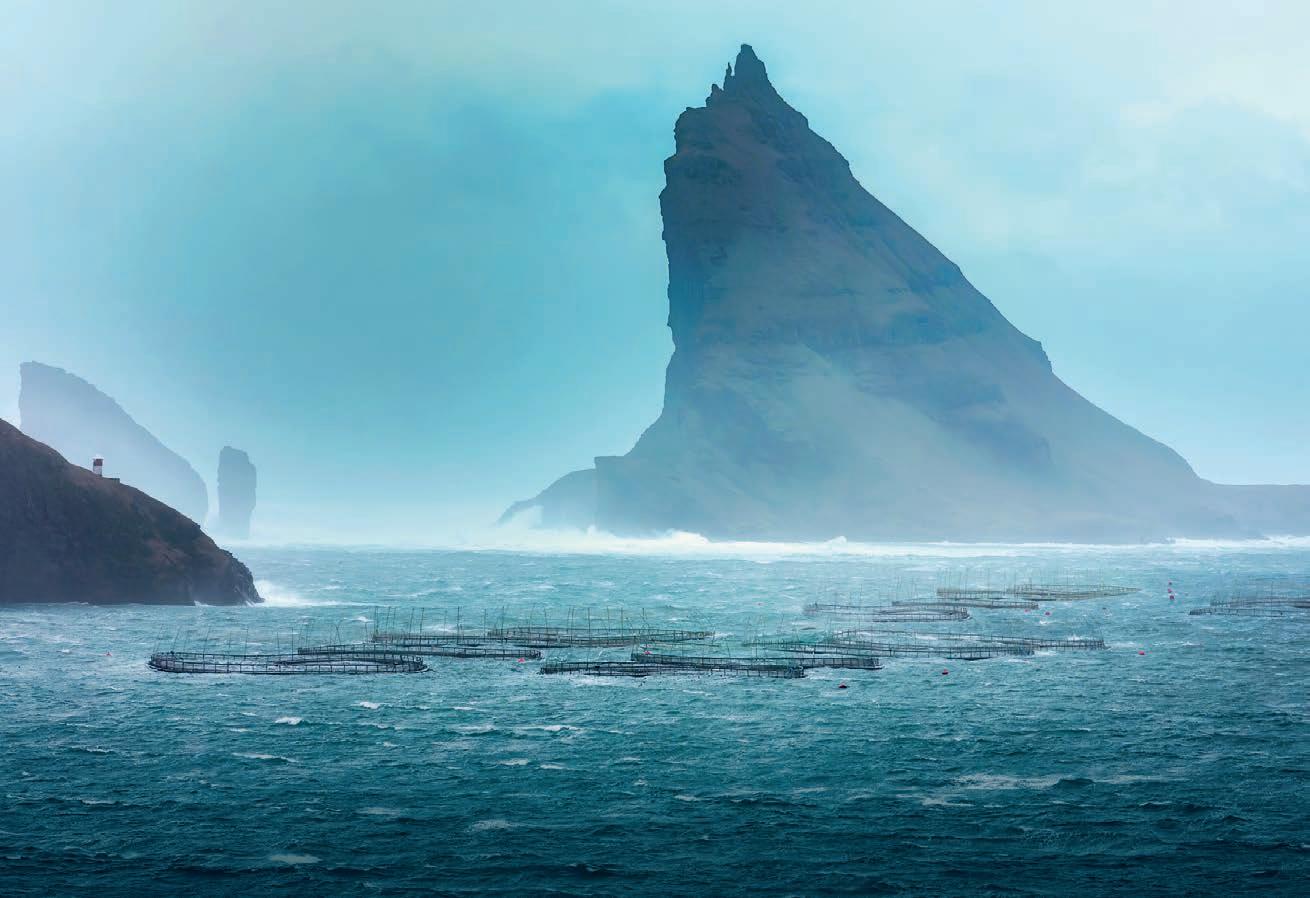
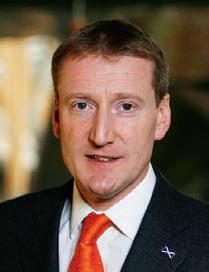

Salmon Scotland Chief
Executive Tavish
Scott says the coming general election is an opportunity to reset the UK’s relationship with the EU and smooth the vital flow of trade
THE Brexit debate that so dominated our politics not so long ago has taken something of a backseat in the past couple of years.
But many challenges created by the UK’s departure from the European Union remain.
This year is a general election year and the party which forms the next UK Government will have an opportunity to review the EUUK Trade and Co-operation Agreement which now governs our relationship with Europe.
And while the Scottish Parliament cannot directly impact that, it is rightly examining what needs done to help Scottish exporters.
At the end of March, I was invited to give evidence to Holyrood’s constitution committee on behalf of the producers and supply chain companies that make up our membership.
There is a headline figure about the impact of Brexit on the salmon industry, which you may have seen [see Sandy Neil’s report on page 42] – up to £100m in “lost” exports.
That is because, in 2019, there were more than 53,000 tonnes of Scottish salmon exported to the bloc, with the figure falling to 44,000 tonnes in 2023.

While strong global demand drove up prices, if the sector had maintained volumes at 2019 levels, then sales would have been above £430m.
So that means there has been a net “loss” of around £75m – or up to £100m had the sector grown at the rate previously expected.
Of course, there are other pressures on exports, which make a precise calculation hard.
So I was grateful to have the opportunity to discuss the situation in detail with MSPs.
I explained to them that the best way to understand this is by setting out the route that salmon takes from harvest on the west coast of Scotland or the islands all the way through the central belt to the Channel tunnel and then to Boulogne-sur-Mer in France.
That tight logistics route was made more challenging by the departure from the EU, both in terms of the time taken for journeys because of the extra paperwork we now have to comply with and in terms of the cost added to the business journey.
The other aspect is that we are competing with our colleagues in Norway, who will



The fundamental issues… are bureaucracy, cost and time







equally say that they can provide product to those marketplaces. We have absorbed the extra costs, because that is what business has to do. But the fundamental issues that our members continue to face are bureaucracy, cost and time.
The coming general election does, however, provide an opportunity to reset the relationship between the UK and the EU. I am supportive of anything that would lead to a better arrangement.
Facilitating improvements to the trade conditions with the EU will improve our international competitiveness and return some of the competitive advantage, reduce costs and increase efficiencies, which will help underpin future development and success of the sector among our coastal and rural communities.
So what needs to happen? We need the UK and EU to create a bespoke and mutually convenient sanitary and phytosanitary agreement, which returns efficiencies to supply chains on both sides of the Short Straits to help consumers and businesses in both territories.
Meanwhile, the lack of a new eCertification and issues with the current outdated system is costing salmon farmers millions of pounds every year.
Improving the certification programme should be an urgent priority for Department for Environment, Food and Rural Affairs officials in Whitehall.
We are still challenged with exporting new, improved technology into the EU now that we are trading as a third country.
The opportunity to reduce packaging, increase efficiencies and make use of domestic transport solutions to the EU would be beneficial for the supply chain to both producers and customers.
In an attempt to progress both UK and EU objectives to reduce emissions, there should be a derogation or agreement on processes and practices to allow product into EU – this would improve quality and reduce environmental and carbon impacts,



and would not necessitate EU regulatory change, which can be cumbersome and length in enacting.
More broadly, Salmon Scotland has written to all the major political parties with a series of manifesto asks.
We want to see a more enlightened approach to the movement of labour into the UK, which recognises the unique challenges our coastal and rural farming communities face, including a change to key worker definitions and a broader public signal that the UK is open to people coming here to work.
We want support for Scottish Salmon as a UK geographical indication and continued consumer protection against the passing off, or mislabelling, of products as seafood where no seafood is present.
And, above all, we want a serious, pragmatic approach to the UK’s relationship with the EU, with a clear focus on the nation’s export businesses, which depend on a positive, professional relationship with France and the other EU countries.
As I told MSPs, Iet there be no shadow of a doubt that I am optimistic about the future, not least because the demand for salmon worldwide is phenomenal – indeed, at times, Scotland nearly cannot keep up with it.
My view of the way things are going to go over the next five to 10 years is that, as long as we can sustainably grow in Scotland and implement some of the reforms that we have been working on with the Scottish Government, the marketplace will continue to be strong.
If we grow, we employ more people, we create more taxation income for the government, we create more local jobs in constituencies the length and breadth of the country, and we also grow our supply chain, which is highly significant now in terms of the money that goes back into the economy and fuels much-needed economic growth.
We are ready to do what we need to do to fulfil the ever-growing market need – and we need government support to remove any trade barriers to that growth.

IWAS rather puzzled by a new report titled What about seafood? The role ofseafood in UK food systems transformation. This was published jointly by the International Institute for Environment and Development (IIED) and the Marine Conservation Society.
Not only was I puzzled by the purpose of this report, but I was even more surprised to find that a report about UK seafood was produced “with the generous support of Irish Aid and Sida Sweden”.
Irish Aid is part of Ireland’s Department of Foreign Affairs, supporting long-term development programmes to bring about change in the lives of people around the world as well as providing humanitarian support to people who need it. Sida is the Swedish International Development Cooperation Agency, which strives to reduce poverty and oppression around the world. Why these organisations are funding a study of UK seafood is a total mystery. Perhaps the UK is a lot worse off than we think!
So what are Irish Aid and Sida Sweden getting for their money?

I am not sure. The report summary states: “This working paper aims to prompt a conversation about the role of seafood in transforming UK food systems and raise the profile of seafood within policy, research and advocacy on the future of food systems in the UK.”
IIED and MCS say that there is a terrestrial bias in the food systems debate that misses the contribution seafood makes to food and nutrition security. I feel that this is a bit rich coming in part from the MCS, given that the public perception is that their main role is to send out messages not to eat this or that fish species. The UK public don’t eat enough fish as it is, yet the MCS continues to advocate through their “fish swaps” that the public should change the fish they like to eat to others they don’t.
Whilst the UK is awash with NGOs telling the public what fish and seafood they should not be eating, the UK now lacks any organisation that promotes fish consumption. It is not surprising that fish hardly features in any debate about the UK’s future foods, especially as consumption of chilled fish continues to be in decline and little, if anything, is being done to reverse this trend. It wouldn’t be surprising if the MCS actually welcomes a downturn in consumption as it would place less pressure on the UK fish stocks that they hope to protect.
According to the report, the UK exports most of what it catches and imports most of what it consumes. This is not news. The
 Above: Fishmonger
Left: Fishmonger sign
Above: Fishmonger
Left: Fishmonger sign
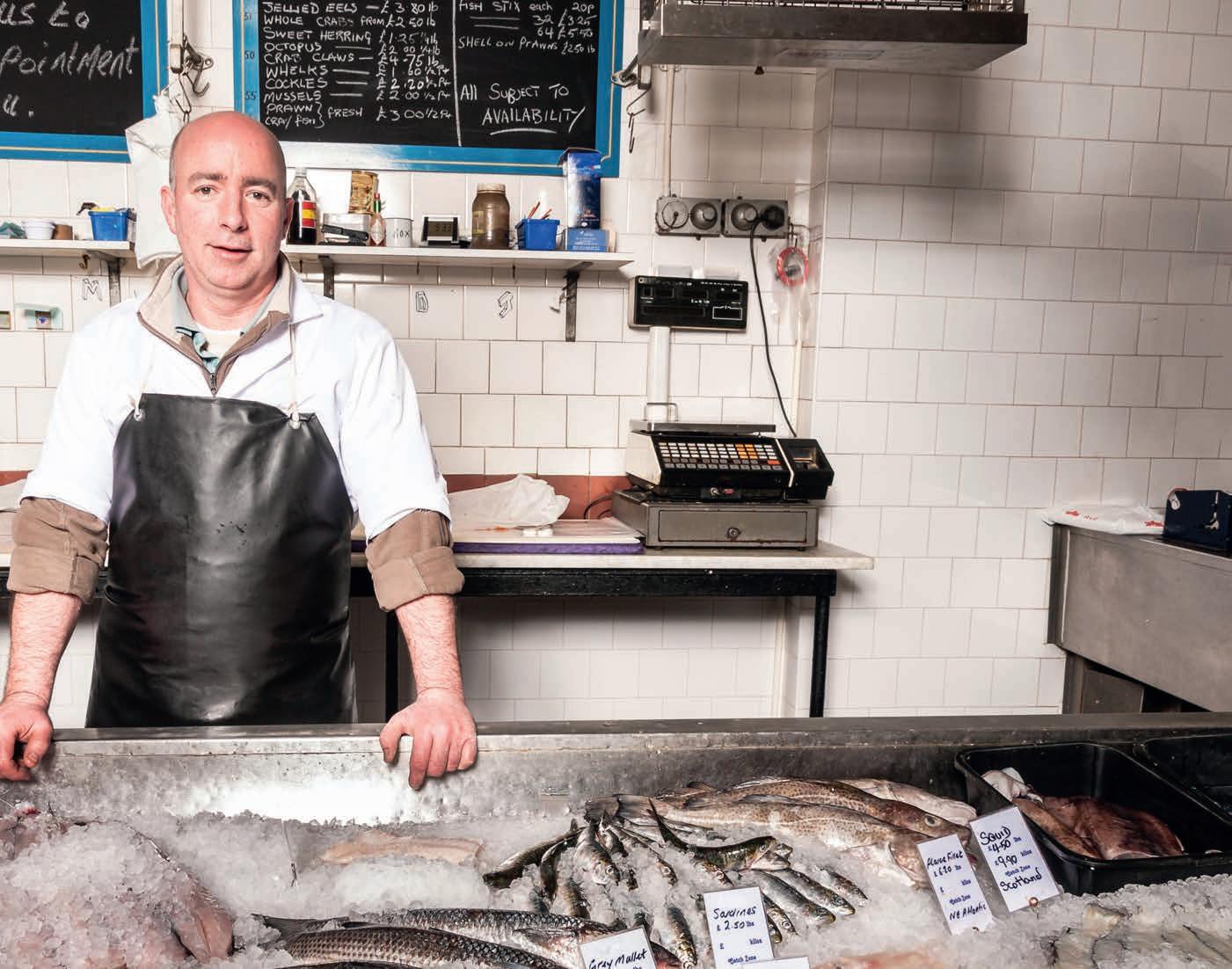
The UK now lacks any organisation that promotes fish consumption ”
UK Government appears reluctant to bring about any change. A project to encourage the public to consume more locally caught fish was rejected for funding by the Seafood Innovation Fund. It is not just the public who have lost the ability to buy and cook local produce, but also those who could help bring about change.
I was having a chat with Fish Farmer’s editor, who said that on a recent visit to a local fishmonger (one of the few left) that he saw “ling” on the slab and thought he would give it a try. He found it really tasty, which it is, but it is not a fish that can be found in many retail outlets.
The head of the National Federation of Fish Fryers, representing fish and chip shop owners, has regularly moaned about the cost of fish to his members and has gone off on various overseas trips to seek alternatives. Yet, there is no reason why fish and chips have to be made from cod or haddock. Ling is a cheap, nutritious and tasty alternative but most of the ling landed by UK fishermen is exported and it will continue to be because there is no organisation coordinating what we land and what we eat. Instead of seeing ling and other such species on the table, the UK imports freshwater catfish from Vietnam as a lower cost white fish alternative to cod and haddock.
The IIED report says that a third of UK fish production comes from aquaculture. They say that much like wild-caught seafood, most of the farmed fish we produce rarely features on the UK’s dinner plates, with 43% of salmon being exported. They then go on to say that understanding these dynamics – production and consumption, demand and supply, culture and economy –is important for shaping the future of seafood.
Clearly IIED fails to understand these dynamics, so it is unclear how they expect others to do so. Salmon may be exported but it is also the most consumed species in the UK. Salmon is a really important part of the seafood sector, yet when it comes to discussing farmed salmon, the report focuses on the views of WildFish, Feedback Global, Open Seas and Compassion in World Farming.
It is not surprising that seafood doesn’t feature in the wider food discussion, when such reports as this one prefer to ignore the benefits of species such as salmon and instead give space to the views of people with their own, negative, agendas.
So, what conclusion does the report reach? They say that we cannot feed the country with two portions of seafood a week through domestic wild capture fisheries. They also say we cannot count on aquaculture to save the day either. In addition, policy goals to increase consumption must be balanced with other commitments such as protecting 30% of the UK’s marine area by 2030. They say that the only way to match these visions with reality is to integrate seafood into the wider food systems debate.
Personally, I am not sure I would be willing to listen to the advice of organisations that are willing to divert funding away from genuine international aid programmes to produce a report about a sector they don’t really understand themselves.

The location’s excellent water quality will be key to the success of what will be Canada’s biggest Arctic charr farm, says the company behind the plan. Sandy Neil reports
THE Prairies, renowned as Canada’s breadbasket, is not the first place you would expect to find a fish farm – let alone one of the largest of its kind in the world. But for an ambitious company near Winnipeg, “The Gateway to the Prairies”, the temperate grasslands provide an “exceptional” site to grow Arctic charr (also known as charr), a popular salmonid on restaurant dinner plates across North America and Europe. This charr will be swimming in pristine cold water from an ancient glacial aquifer that runs beneath the vast Canadian Shield.
Sapphire Springs Inc (SSI), a partnership between seven Manitoba entrepreneurs led by Ken Blair and Chuck LaFlèche, is building a CAN $140m (£82m) fish farm that will produce 5,000 metric tonnes of Arctic charr when it is up and running in 2026/7.
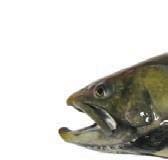


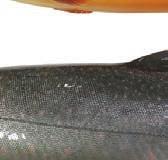



The site at Rockwood, Manitoba, will become the largest landbased aquaculture facility of Arctic charr and boost global supply by a whopping 50%. Its recirculating aquaculture system (RAS) reuses more than 99% of the water, filtering it and treating in multiple stages to bring it back to “a fully pure, crystal-clear state”. “We started with the science,” an SSI spokesperson began. “We


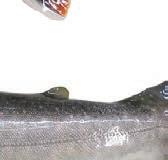


purchased the former site and all its genetic stock from a worldleading Arctic charr research facility, previously operated by the Canadian Department of Fisheries and Ocean. We followed that purchase in 2023 with the acquisition of Icy Waters Inc, which is the global leader in Arctic charr broodstock, selling ova to aquaculture facilities around the globe.”
Icy Waters, based at Whitehorse, Yukon, also grows, harvests and sells their fish to food distributors throughout Canada.
As the spokesperson puts it: “With a solid vision to grow and distribute Arctic charr products to the world markets at scale, [SSI] saw the potential of acquiring Icy Waters’ exceptional broodstock and company brand as a natural next step in their plan to create a truly world-class company.”
Sapphire Springs’ first facility is located on a 140-acre site in the subarctic climate of Manitoba, which possesses “the perfect conditions for Arctic charr to thrive”.


It becomes this perfect water source for growing fish
To explain why, we interviewed Sapphire Springs’ Chief Operating Officer, Doug Hotson.
“It is exceptional site selection,” he said. “One of the reasons we chose Winnipeg, not just that it was the hometown of the entrepreneurs and they wanted to support local and grow local, was this aquifer. The water comes out of an artesian well at 6.5ºC every day of the week. It’s completely pathogen-free. It becomes this perfect water source for growing fish.
“Arctic charr, as evident by its name, is a cold-water fish and 11ºC is just about optimal. With the natural heat the RAS system gives to the water, from the friction of moving it around and a little by-product from pump heat, that water is going to sit between 11ºC and 12ºC without us heating or cooling anything. It will then provide the heating and cooling in the ambient air temperature. It will remove a substantial amount of the energy cost that other facilities produce.
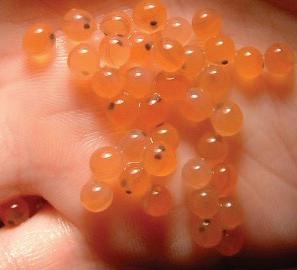





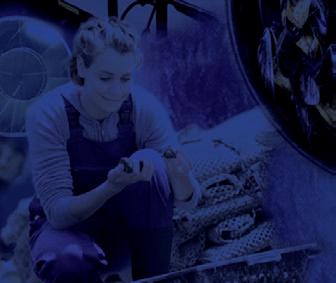

“Unlike the ocean that moves for free by lunar power, we have to pump every litre of water every second of every day. Manitoba has a great green energy programme, so their cost of power relative to the rest of the Canada is attractive for a large power consumption business.
“For fish to have water and oxygen, you have to have pumps moving. If a pump fails, that’s a large risk. It’s a mechanical device: it’s not if it fails, it’s when. With our design, every piece of equipment has got a 100% redundant backup. That





 Opposite from top: How the new farm will look (3D facility rendering); Arc�c charr, SS product construc�on progress
Opposite from top: How the new farm will look (3D facility rendering); Arc�c charr, SS product construc�on progress


automatically becomes ridiculously expensive.
“What we did is, we built modular units. We’re running basically six farms inside of a farm. Every piece of equipment is sized to handle two units so that if one fails, the other unit can handle the capacity. It didn’t require two times everything. We don’t have to panic that we’re going to lose all of our fish if we have a mechanical failure.”
SSI estimates that is possible to grow Arctic charr, generally speaking, at three times the density of salmon and twice as dense as trout. As a species, it therefore lends itself well to a large capital-intensive project like RAS, because you can leverage that capital so much more effectively with higher densities. Rather than growing at 30kg per cubic metre, SSI can grow up to 90kg or 100kg per cubic metre.
A fish can be delivered in North America fresh on truck within 30 hours
“As fish are pulled out of one of the tanks, they travel in the monorail either to the processing plant for harvest or for splits and grades into other facilities. We’ll never touch a fish; from animal welfare and husbandry, it’s the most minimal stress environment that we could design and create.
“The plan is to grow fish in four different cohorts and that will enable us to harvest every single day. Fish will move through in 13-week increments. So we’ll put four periods of fish down every year. You always have leaders that are going to grow a little bit faster than some other fish. The leaders [are] the ones that are going to be, maybe, late 2026. When we hit steady state, that will be into 2027 – 60,000 fish will come out of the water every week. It equates to roughly a truckload of fish every day.
“The first year of steady state, the revenue projection is $88m [£51m]. And then, as some things come online in terms of our sustainability and efficiency, as we sell the garden nutrients coproduct that comes out of the water waste, as well as the offal that gets sold either into compost to become more fertiliser products or into pet food industries, we will eclipse $100m [£58m].
“Our forecast is to have outside construction complete before winter comes to Manitoba. Then we’ll move inside and begin the plumbing retrofit on the inside of the structure, with a goal of having fish swimming in the facility for April next year. It’s an 18to 19-month growth cycle. If everything goes perfectly smoothly, the first commercial harvest will happen in 2026.
“There are only 10,000 roughly metric tons of Arctic charr sold in the world. Right now, Iceland is the largest supplier. We’re building a 5,000 metric ton facility, [which] will make us the largest producer of Arctic charr on the planet. Outside of that, we believe we’re the largest global supplier of ova through the Icy Waters acquisition.
“A fish can be delivered in North America fresh on truck within 30 hours of finished processing. It’s just not possible to be in California from Iceland in 30 hours from processing. It’s going to give us an opportunity to be the freshest product on the marketplace.”
With Arctic charr in high demand for its taste, texture and nutritional profile, SSI expects to begin work on future production facilities almost immediately. “We have already begun planning two additional aquaculture facilities to be located on the east and west coasts of Canada,” it said. “These facilities will greatly expand our production capacity and also allow us to improve shipping times to both coasts of North America as well as to Europe and Asia.”

It’s impossible to prevent disease if you don’t know its cause. With over 90% of aquatic microorganisms unknown to science, targeted diagnostics such as qPCR and metabarcoding often overlook the true cause of infectious diseases.
Our Detect platform is aquaculture’s first truly unbiased pathogen detection tool. Harnessing metagenomics to identify all organisms within a single sample, Detect has the power to resolve total microbiomes, enhancing your diagnostic accuracy and improving livestock welfare.

We will be exhibiting at Aquaculture UK 2024!
Stand: OS65
Total microbiome resolution with no detection bias
Intuitive results to your mobile device
Fast detection with our 72-hour lab processing time
Full support from our expert scientists

Talk to us today

inquiries@esoxbiologics.com
www.esoxbiologics.com





The shellfish world is one full of contrasts, Nicki Holmyard finds




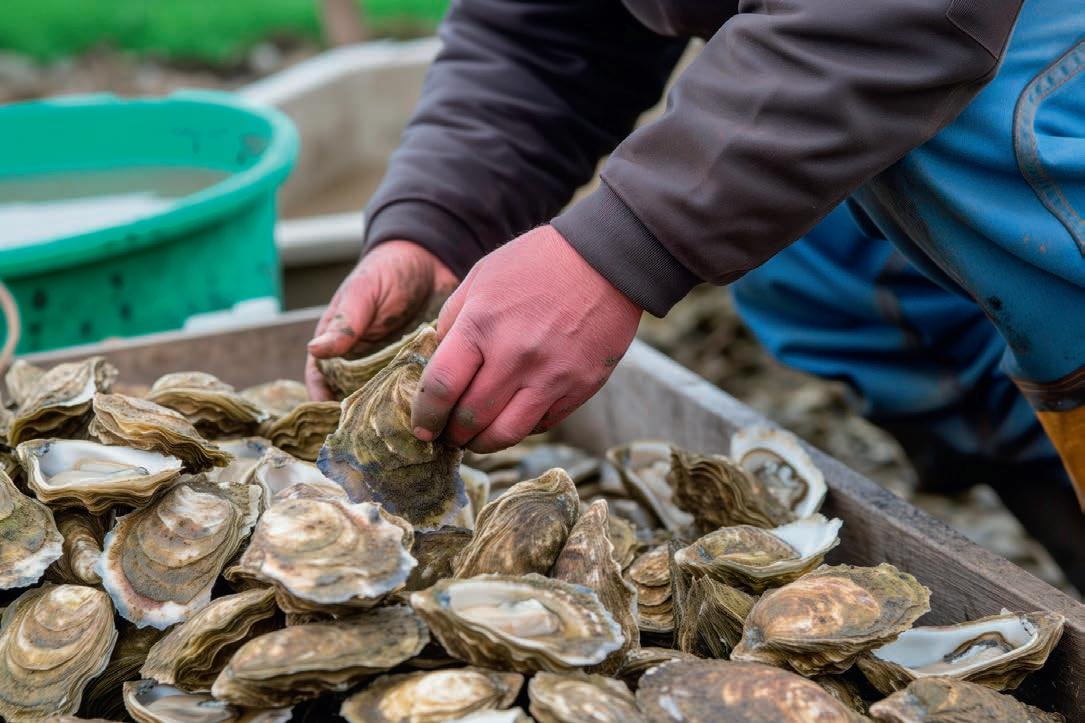
AS we gained plaudits, column inches and airtime in March for the wonderful benefits to the environment, biodiversity, ecosystem services, food security and surrounding fisheries that our offshore mussel farm brings, it struck me that this side of the business is far removed from the daily struggle to stay in existence.
Eleven years of expensive research by the University of Plymouth, during which time we have fully sponsored three PhD students and played a major role in getting the new Ropes to Reefs project off the ground, all provide good news stories. What is largely ignored by the media is the ongoing issues we face in righting the wrongs of Brexit, fighting a political and regulatory system that appears not to care, and battling the water companies to stop them polluting our rivers and seas. It’s an uphill task and it’s exhausting, but bad news stories are rarely welcome!
All strategy documents and national plans point to shellfish aquaculture as a saving grace for future food security, but with no practical back-up and no enabling environment, the sentiments are hollow.
One particularly galling point is that the UK is allowing the import of bivalves from Grade B waters into this country and has implemented legislation to enable that to happen, yet it still has not managed to get trade in the other direction reinstated following


Brexit. This has seen the Welsh mussel industry virtually disappear.
Furthermore, the Fisheries Minister Mark Spencer recently praised the UK’s ability to smooth the path for importers of seafood products through use of electronic certification, while still failing to put a rocket under the Department for Environment, Food and Rural Affairs (Defra) for stalling yet again on the implementation of an electronic certification system for exports.
In another contrast, we are good at growing shellfish such as mussels and oysters in the UK, yet our consumption
Maybe it’s time we stopped being an apologetic nation

levels are miniscule compared to the likes of France, Spain and Italy.
With 26% of adults and 23.4% of children aged 10 to 11 years in England obese and a further 38% overweight, plus a rapidly escalating diabetes crisis in which the number of people affected topped five million in 2024, there has never been a more urgent need to change the national diet.
Farmed shellfish are packed with vitamins, minerals, essential amino acids and micronutrients, all of which are essential for promoting health and wellbeing. They are high in protein and low in calories, making them a good food choice for weight management. They are particularly high in omega-3 fatty acids, which are beneficial for heart health, brain health, mental health and the immune system. Getting more people to eat them is another matter…
Shellfish, like most seafood, is at its best when eaten fresh, but packs of cooked mussels in sauce are not a bad substitute. Sales of these are growing in retail and food service year on year. Canned mussels are also becoming more popular and grace the table of many a restaurant as a starter or part of a tapas meal – often in the tin.
Dr David Willard of Cambridge University believes that the answer to encouraging greater consumption of bivalves lies in including mussel and clam meat in seafood staples that are familiar to the public, such as fish fingers and fish cakes. However, the economics of using rope-grown shellfish as a highly processed ingredient have yet to be fully analysed. And do we really want to see such a high-quality food turned into a commoditised, anonymous ingredient?
Getting back to contrasts, I am always amused by the number of people who wax lyrical on social media channels about the wonderful displays of fresh fish and shellfish



to be found on supermarket counters in Europe and further afield. Back in the UK, most of the major supermarkets have axed their fresh fish counters. Meat and deli counters have suffered the same fate. Those that remain offer the limited choice of species that retailers know will be sold. Instead, shoppers are faced with shelves of pre-packed fish and shellfish, and no expert fishmonger to call on for suggestions or advice. It is no wonder that the seafood category is in decline in the UK.
Recent work undertaken by Michael Steinke at the University of Essex, sponsored by the Shellfish Association of Great Britain and presented at the APPG on Shellfish Aquaculture on 25 March, looks at the latest Defra policy to restrict Pacific oyster (Magallana gigas) aquaculture operations in the UK. This policy has already seen major landowners, including the Duchy of Cornwall, ban the farming of Pacific oysters, asking that they be replaced with native oysters (Ostrea edulis) instead. Oyster farmers have pointed out that this option is neither practical nor economic.
Pacific oysters currently account for more than 95% of oysters grown in the UK and since their introduction in the 1960s, this species has effectively become naturalised. Genetic studies show that some local populations originate from outside the country, particularly the southern North Sea.
Following his research, Steinke argues that restricting the farming of Pacific oysters will not prevent naturalised
spread; it will also suppress important ecological and economic benefits to coastal communities. These include the improvement of water quality and the provision of nature-based and hybridengineering solutions to the coastal problems associated with climate change, such as sea level rise and erosion.
Steinke recommends a reconsideration of the regulatory approach towards the farming of Pacific oysters and the introduction of appropriate mitigation methods to enable Magallana gigas to be granted a legal naturalised status in the United Kingdom.
My final contrast is the way in which other nations seem to waste no time in organising protests and going to court to express dissatisfaction about the way in which environmental issues are handled and the “Polluter Pays Principle” is invoked. French shellfish farmers have been particularly successful in this regard.
Earlier this year, oyster farmers in the Arcachon Basin in France, helped by their local association Adeba, started legal proceedings and a call for compensation against SIBA, the local authority responsible for wastewater treatment in and around the Arcachon Basin. Adeba cited regular overflows from the wastewater network since autumn 2023, resulting in an ongoing epidemic of norovirus and the severe disruption of sales over the Christmas and New Year period in 2023. The organisation is confident of success.
In the UK, there have been a number of norovirus outbreaks and when these occur, oyster farmers are treated as if they have created the pollution and it is their fault. Their farms are shut down, they lose business, they lose customer confidence and they seem to have no redress or possibility of compensation from the actual polluter. Taking the all-powerful water companies to court would require significant funds and considerable patience. Maybe it’s time we stopped being an apologetic nation and took action, but there again, we also need a more accessible justice system. It’s probably simpler to avoid taking up shellfish farming!
• Read more about Ropes to Reefs in our UK News section on page 12.






THE figures are stark and speak for themselves – and should worry not just salmon farmers in Norway, but the industry internationally.
The Norwegian Veterinary Institute last month reported that 105.4 million salmon and trout at all stages of life died prematurely last year from disease, winter sores, jellyfish attacks and climate issues – the highest figure on record.
Norway is not alone with some of these problems. Iceland, Scotland, Chile and Canada have all experienced similar issues over the past year.

For salmon in the sea phase, the mortality figures in 2023, both in number and percentages, are the highest recorded so far, says the Veterinary Institute.

But Norway is the world leader among salmon farming countries and way out in front when it comes to aquaculture health technology. If it cannot solve some of the problems facing the industry, who else can?

The figures will also provide ammunition for the growing number of often uninformed commentators and organisations opposed to fish farming of any kind, ignoring that many of the deaths are down to climate issues, which are also affecting agriculture and life in general.
The mortality figures are divided into two sections. They show that 37.7 million salmon and 2.4 million rainbow trout over three grams died from hatchery production on land in 2023.
Secondly, 62.8 million salmon (16.7%) and 2.5 million rainbow trout (14%) in the marine phase of production.
The report says that overall, it is the same three health issues that stood out again last year:
• damage from lice treatments;
• complex gill disease; and winter sores.
Damage caused by jellyfish is now ranked among the 10 most serious health challenges, which the report says represents a significant change in 2023.
Among serious infectious diseases, in 2023, there was a worrying increase in detections of bacterial kidney disease (BKD) and also four cases of pancreatic disease (PD) north of the endemic PD zone.
Infectious diseases are an extensive problem


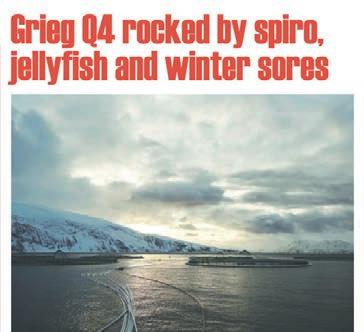
The report points out that infectious diseases are an extensive problem both for the fish’s welfare and for survival in the sea.










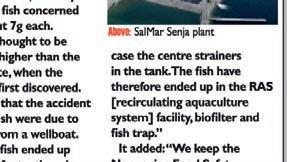


Much is known about how the risk of infection can be reduced, but there is still room for improvement by translating knowledge into action, the Veterinary Institute says.
The five most common subcategories in infectious diseases were:
• winter sores;
• cardiomyopathy syndrome;
• gill disease;
• heart and skeletal muscle inflammation; and
• lice treatments and stressful handling, which can weaken the fish and make it more susceptible to infectious diseases.


Launching the Norwegian Fish Health Report, Edgar Brun, the Institute CEO, said 2023 has been eventful and turbulent, with a lot of negative focus on the industry.
He added: “The global demand for Norwegian salmon, however, remains high and Norway has never had as much income from salmon exports as in 2023. At the same time, the industry has incurred a large expenditure item.
“The biological costs are greater than ever and include costs for health and welfare, various treatments, losses through dead fish and reduced expected production.“
Combatting salmon lice was the major driver of these costs, but the Fish Health Report also documents that the steady state of health and welfare in the industry is still challenging.
More fish have died in the sea phase this year than ever before. Outbreaks of “old” diseases such as BKD show that the infectious agents are still present and the PD virus shows its potential as a free passenger for movement over large geographical areas. In the past year, there have been several episodes of mass die-offs from various causes.
Gill problems, which are complex, can be linked to poor environmental conditions in the operating units, says the report. The extent of emergency slaughter and the use of “blue boats” is increasing. This is slaughtering (on the edge of the cage) of fish that will not withstand ordinary transport to the slaughterhouse and would otherwise, to an unknown extent, have died by themselves and been classified as dead fish, Brun explains.
He adds: “At the same time, we are seeing increased shares of production fish; these are fish that do not meet the superior criteria Norwegian salmon is based on.
“In terms of resources, it makes sense that we manage to take care of as much fish as possible for consumption.
“However, this development can undeniably also be an expression of major camouflaged welfare challenges. It is important to find out the underlying reasons and what condition the fish in question has been in.”
The report insists biosecurity is a prerequisite for sustainability. It includes infection hygiene measures to control the introduction and further spread of disease so safe food can be produced in an economically, environmentally and socially responsible manner.
Many good measures are being taken by individual actors and

SALMON lice are still the biggest parasite challenge and driver of disease in farmed salmon in the sea. The lice levels in 2023 were somewhat lower than in 2022. In 2023, most of the lice removals were drug-free, although there was a 17% decrease in the number of such treatments from the previous year.
The number of thermal treatments decreased by 24%. Mechanical lice removal was the most common removal method in 2023. The number of weeks of medicinal treatment remained at approximately the same level compared with 2022.
in limited regions. But biosecurity in an industry that is contagion-linked from north to south requires cooperation and transparency.
Brun asks: “Are we mature enough to set concrete health and welfare targets for the world’s largest salmon production?”
There are some bright spots in the report. They point towards greener value creation and better biological sustainability through good health and welfare.
Sjømat Norge (Seafood Norway) has published a guide for the aquaculture industry called “Best practice for good biosecurity and better disease control”.
Seafood Norway has set a maturity test for the industry, the report says, by challenging it to show a united will to take the big steps and use the resources necessary to prevent and control disease, and secure the future health of the fish.
The industry has always shown great ability and drive to achieve goals and ambitions, the Veterinary Institute concludes. If the leadership position expresses a willingness to listen, comply and make progress in the implementation of requirements, it will be exciting to follow a forward-leaning aquaculture industry, with Norway at the forefront, showing the way in animal welfare work.





















See us at Aquaculture UK 2024. Stand number D41.

Physical checks on plant and animal products imported from the EU into the UK will start from 30 April. Will the UK’s seafood exporters feel that they have a level playing field at last? Sandy Neil investigates
THE UK left the EU’s Single Market and Customs Union on 31 December 2020, leaving the UK and EU with separate customs and regulatory regimes.
On New Year’s Day 2021, the EU applied its usual third-country regime to goods imported from Great Britain (GB) to the EU to ensure correct taxes (for example, tariffs, VAT and excise duty) are paid, safety and security obligations are fulfilled, and standards in food safety and disease control are met. Businesses in GB exporting to the EU therefore face border checks but the UK repeatedly delayed applying its own thirdcountry regime to goods entering from the EU, leaving GB businesses subject to paperwork and costs, which EU businesses exporting to the UK largely avoid. There has been alarm among some industries, such as the veterinary sector and domestic food producers, that the absence of full controls is making the UK vulnerable to food fraud and animal disease, explains the think tank UK in a Changing Europe. Stricter controls on UK exports to the EU compared to EU imports into the UK has also put British domestic industries and suppliers at a disadvantage. This is because it creates an “uneven playing field” for British traders, such as farmers, as they are subject to expensive and time-consuming
checks on their exports to the EU, while competing businesses in the EU can export to the UK without similar barriers.
Trade has shrunk, recent figures show. “Trade between the EU and the UK had been tariff-free and frictionless,” rued a European Parliament paper in February. “Following the entry into force of the EU-UK Trade Cooperation Agreement (TCA) in 2021 and the withdrawal of the UK from the EU customs union, the trading of goods between the parties has become more burdensome. This has been manifested in trade figures, with UK imports to and exports from the EU both shrinking after Brexit.”
Brexit has cost Scotland up to £100m each year in “lost” salmon exports, Salmon Scotland Chief Executive Tavish Scott told MSPs


on the Constitution, Europe, External Affairs and Culture Committee in March, as part of their inquiry into the TCA.
“Scottish salmon is the UK’s largest food export, but farming companies have faced increased red tape and costs triggered by the departure from the EU in January 2020,” the trade body said. “In 2019, there were more than 53,000 tonnes of Scottish salmon exported to the bloc, with the figure falling to 44,000 tonnes in 2023.
“Export values to the EU were only down 3% to £356m because strong global demand drove up prices, but if the sector had maintained volumes at 2019 levels, then sales would have been above £430m. That means there has been a net ‘loss’ of around £75m or up to £100m had the sector grown at the rate previously expected.
“The Brexit impact of lost sales does not include the direct £3m-a-year cost to farming companies because of the lack of an e-certification scheme.”
This year marks another phase in “the introduction of administrative burdens on trade”, notes the European Parliament, “in the form of additional customs rules and checks when exporting goods, particularly agricultural goods, to the UK, with the Border Target Operating Model (BTOM) being gradually implemented by the UK.
“On 31 January 2024, the fourth anniversary of Brexit, the first phase of the UK BTOM started, after being delayed by the UK Government five times, with the introduction of health certification on imports of certain agri-foods, animals and plants and their products from the EU. The BTOM will be phased in in three steps, with physical checks commencing in April 2024.”

save around £520m per annum under the new model, while the inflationary impacts on food for consumers will be, at most, less than 0.2 percentage points over a three-year period.”
Three potential outcomes of the new border controls have been predicted, lists UK in a Changing Europe. First, food industry bodies say the BTOM will increase in food prices due to the costs to businesses of certification and custom declarations, as well as the rising flat-rate inspection fee (from £20 to £43) on each consignment of food coming from the EU.


from April and could affect the cost in some way, for example, the inspection fee and the border control post charge. It remains to be seen if there will be price increases for consumers.”

What is the BTOM? “The new model will introduce a new global risk-based system of controls,” Baroness Neville-Rolfe, Minister of State at the Cabinet Office, told the London Chamber of Commerce. The categorisation is based on the inherent risk the commodity poses to animal health, food safety and biosecurity, and public health, alongside the risks specific to the country of origin, for example, the prevalence of pests and diseases, and the standard of official health controls.
“For instance, low-risk goods – such as tinned salmon – will not need to have health certificates or routine border checks,” she said. “For high- and medium-risk goods –such as fresh meat and plants for planting – we will need the assurance certificates provide along with proportionate checks on arrival.”
The new regime will have a “negligible impact on food prices”, according to the UK Government.
The government states: “The model will minimise costs for traders and consumers. Government analysis estimates traders will
Second, some expect many EU businesses will stop or reduce their exports to the UK due to the increased time and cost. When the EU implemented their full border controls on goods from GB, many UK businesses reacted in that way – and the UK is a less significant market for EU suppliers than the EU is for UK ones. Trade associations also warn that a lack of vets in the EU (who are needed to sign off consignments) could curtail supplies. The new controls are also likely to be especially challenging for small EU businesses, who may lack the resources to complete the necessary paperwork and face the same flat-rate inspection fee as bigger firms exporting much larger consignments. This could mean goods from many smaller EU producers disappearing from British shelves.
What has been the BTOM’s impact for EU and GB producers so far? “Norway is the top exporter of seafood to the UK, holding an estimated 20% share of seafood imported to the market (2023),” said the Norwegian Seafood Council. “For Norwegian seafood exporters, it is primarily aquaculture products and processed products that are affected when it comes to health certificates, and which end up in the medium-risk category where the new requirement applies. However, with the new risk categories, pelagic fish such as mackerel are also met with a health certificate requirement. The fees will be applicable
On the British side, the move “delivers more certainty and stability to the entire export/import process,” said trade body Seafood Scotland. “However, it will add a layer of complexity and risk that may slow down trade between the UK and the EU. This could have a negative impact on supply chains and extend timescales for end-to-end deliveries. Costs may rise for intermediate processors based in the UK because of the additional red tape required for products arriving from the EU. It also risks disincentivising EU producers supplying the UK market as margins may be squeezed by the additional costs of complying with BTOM requirements.”
Will the BTOM level the playing field? “It’s too early to tell right now,” Seafood Scotland said. “That judgement can only be made when the BTOM has been fully implemented. At that point, if EU exporters face the same demands to get the certification ‘just right’ (everything 100% in order just as UK exporters have to do now) and also have to undergo rigorous physical and documentation checks to send their products to the UK, they are likely to feel the same pressures that UK producers are feeling now. Hopefully, that realisation will prompt both parties to have constructive discussions about minimising these processes.”
It will add a layer of complexity and risk that may slow down trade
Sea cucumbers may not look too appetising to the Western consumer, but their potential in the export market is huge, Robert Outram finds

IN a series of man-made lagoons in the Bahía de Cádiz Natural Park in southern Spain, a species is being farmed that is destined to be consumed on the other side of the world.
Guatizamar, the company operating the farm at San Ramón de Chiclana de la Frontera, near Cádiz, is still at the developmental stage and is raising funds for the investment needed to carry out its first commercial harvest.
Even so, its Chief Executive, Antonio Fernandez-Perez, is confident that Guatizamar has already created a superior product that will find ready buyers. The market? China and the Chinese diaspora, plus Japan. The product? Sea cucumbers.
Perez is also CEO at Sayanes Mar SL, a frozen seafood import and export company based in Vigo, Galicia, Spain’s biggest fishing port. He explains how he came to be farming a seafood species that most Europeans have not even heard of, let alone tasted. “I realised that the Chinese are crazy about sea cucumbers,” he says, “but it was impossible to sell to them in a legal and sustainable way, if not done through aquaculture”
Sea cucumbers don’t have a strong taste, but they are popular in
Asian cuisine as a healthy ingredient – or even for their medicinal properties. They are relatively high in protein and low in fat, and contain a variety of nutrients, especially vitamins B2 (riboflavin) and B3 (niacin). They are also a rich source of chondroitin sulphate, commonly used for arthritis.
In traditional Chinese medicine, sea cucumbers are believed to have anti-cancer and anti-diabetes properties, and a remedy for fatigue, impotence, constipation, frequent urination and joint pain.
Even the sea cucumber’s guts can be dried to make a powder as a medicinal food additive. Creams, tinctures, oils and cosmetics infused with sea cucumber extract, as well as oral sea cucumber supplements, are also popular in China.
Most of the sea cucumbers Chinese consumers want to eat can no longer be legally harvested, however, at least from abroad. More than 70% of the global sea cucumber population is considered to be over-exploited or depleted, with local extinction of some stocks.
Sea cucumbers can be dried and easily transported, however, and there are many illegal channels to get them into China. In Cape Verde, Spain, Morocco and many other countries, illegal harvesting is threatening sea cucumber numbers.
This is a problem not only for the seafood industry but for the ocean environment. Sea cucumbers play an important role in turning organic detritus in the seabed into nutrients that can sustain other forms of life. As Perez puts it: “Sea cucumbers are natural vacuum cleaners of the oceans.”
One way to tackle the problem of over-fishing is, of course, aquaculture. Sea cucumber farming began in China and Japan in the 1980s, mainly centred on the species Apostichopus japonicus Guatizamar estimates there are currently less than three species cultivated on a large scale in different countries including Australia, China, Japan and Madagascar.
Seeing an opportunity, Perez worked with the University of the Algarve to research European species of sea cucumbers to see which would be most suitable to farm in Spain – and which would be attractive for the Asian market. As he explains, there are many species of sea cucumbers, which are all different from each other.
He says: “We were looking for the one which is most ‘good looking’ for the Chinese market.” The species selected was Holothuria arguinensis, native to Portugal, southern Spain, the Canary Islands and Morocco, where it is particularly endangered in Morocco. As well as being appropriate for the region, Holothuria arguinensis was seen as a good candidate for the Chinese market –not only is it quite large, with a comparatively thick body even when dried, but its spikes are seen as attractive by consumers.
They grew the first larvae in 2014, after getting over the first hurdle: bureaucracy. As Perez explains: “Initially, it was forbidden to sell or harvest Holothuria in Spain, as an endangered species. I had to talk to Madrid many times to get permission.”















Guatizamar’s farm is based in a large nature reserve and the water in its ponds, which is regularly replenished by the tides, is of exceptional quality. The use of antibiotics is strictly forbidden in the reserve, but so far pathogens have not proved to be a problem.
Early stage larvae are grown in the hatchery with 120 by 500-litre circular tanks. Then they are moved to larger tanks for the settlement stage.
In the first three weeks, the larvae float, then the juveniles develop suckers or feet, which they use to attach to surfaces. When they have grown larger, they are transferred to a series of outdoor ponds fed by seawater, passed through a biofilter, which does not allow them to escape. In the final stage, the adults are fattened up in a larger pond prior to harvest.
The larvae are fed on microalgae supplied by Acuinuga and in the settlement stage, the juveniles eat algae-based feed including PT Aqua’s AlgaMac.
In the ponds, there are natural nutrients for the sea cucumbers to feed on, but to ensure faster growth this is supplemented by ulva –the seaweed also known as sea lettuce. The Holothuria do not eat the fresh seaweed, but feed on the sediment its detritus creates.
At harvest time, the team simply have to empty the pond and collect the sea cucumbers. As Perez puts it: “You can collect them as if they were strawberries.”
They are gutted, boiled and dried, with the final product only 10% of the sea cucumber’s live weight.
Two key challenges remain, Perez says: first, how to standardise growth and speed it up; and secondly, how to achieve year-round production. As he explains: “Holothuria have gonads only in spring, but we would like to be able to achieve reproduction all year round. We need to adapt the laboratories to allow this.”
A third challenge is raising funds for the next stage. Perez says: “We are talking to investors in the UK and US – we are looking for a partner to help us grow. We have a five- to 10-year advantage over potential competitors and I don’t want that advantage to fade.”
Guatizamar is looking for around 3m (£2.6m) to scale up and build a dedicated processing line.
As a dried product, sea cucumbers for medicinal or culinary use are comparatively cheap to transport, even to China, and Perez believes there are also potential customers in countries such as Malaysia, Singapore and Japan, not to mention the sizeable



Guatizamar’s sea cucumbers have the advantage of being legal and, compared to many farms in Asia, the fact they are grown without antibiotics and in less polluted seas is another selling point.
Don’t expect to find sea cucumber on your paella any time soon, but this new, sustainable seafood export could prove to be a winner.
I realised that the Chinese are crazy about sea cucumbers




 Opposite from top: Holothura arguinensis dried sea cucumbers
This page clockwise from top left: Gua�zamar farm from the air the farm facili�es at Gua�zamar pelagic lar ae area Holothurias thro ing algae into a pond at Gua�zamar
Opposite from top: Holothura arguinensis dried sea cucumbers
This page clockwise from top left: Gua�zamar farm from the air the farm facili�es at Gua�zamar pelagic lar ae area Holothurias thro ing algae into a pond at Gua�zamar






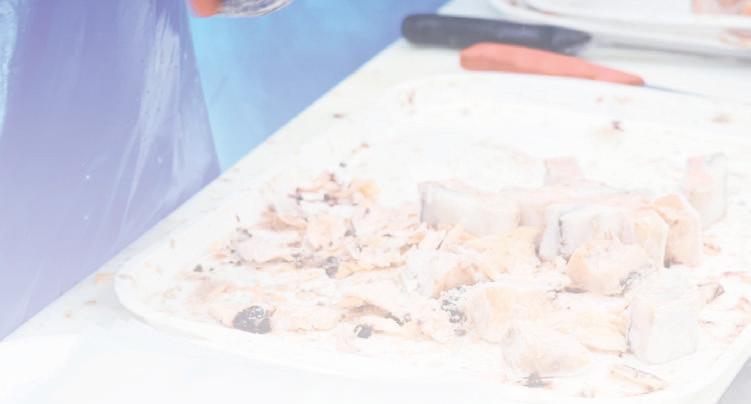







IS Norway heading for a potentially damaging dispute with the European Union (EU) over the sale of production fish?
Commonly known as prodfish, this term is mainly given to salmon that have been damaged by injuries or winter sores.
The Norwegian Food Safety Authority insists that these wounds must be corrected before the fish is exported. It is already investigating a number of companies who it believes are regularly breaking the rules. There have even been calls for the police to become involved.
This rule not only protects Norway’s reputation as an exporter of quality seafood (its ostensible purpose), but it also ensures that more processing is carried out at home rather than in countries such as Poland and Denmark, which are both members of the EU, of course.
Norway divides its salmon into three grades – superior, ordinary and production, the latter being up to 30% cheaper, although once wounds have been removed, the quality of the fillets can be quite good.
Processors outside Norway say an unfair market is being created because they do not have access to this cheaper fish.
The European Commission has officially said the practice is a trade barrier, without going much further on what that could mean for relations.





Norway’s ban on the export of ‘inferior’ quality salmon is being challenged by the countries who want to process it, reports Vince McDonagh
The issue has been knocking around for a while, but in the past couple of years the volume of prodfish has increased, with the Food Safety Authority suggesting the figure is around 37%. The proportion of total sales accounted for by prodfish is especially high in winter, when sores are a problem.
The ban has set alarm bells ringing in Brussels so if the European Commission and the Norwegian authorities dig their heels in over this, it could well lead to a trade impasse.
It is thought that Denmark, probably the second-largest processor of Norwegian salmon, was the first country to raise a complaint, probably because its processing industry has much to lose.
But Dutch fishermen and fishing organisations, which also represent buyers and wholesalers, have also called for an investigation into the restrictions.
“We await the upcoming process but share the enthusiasm of our Danish colleagues that the entire EU now sees Norway’s export ban on farmed salmon as a trade barrier,” says the Dutch Fishing Federation.
The Norwegian industry itself remains divided over the issue with Mowi, Norway’s largest salmon company, calling for an exemption on the grounds there is not enough processing capacity at home. Inge Erlend Næsset, Department Director for Regulations and Control at the Norwegian Food Safety Authority, insists: “Production fish are farmed fish with wounds, deformities and gross processing errors. Such fish must not be sold for human consumption until it has been treated by a domestic business with the necessary equipment. When transporting production fish, the packaging must be clearly marked ‘only for domestic production’.


“This national requirement is to ensure good quality of fish and fish products for the consumer, and contribute to ensuring that Norwegian fish can be sold on markets all over the world.”
He adds: “The fact that some people choose to break the regulations also creates different competitive conditions for the business players.”
This has led to complaints that some companies will be able to break the rules while others stick to them.
The European Commission ruling has officially




registered the Norwegian approach as “unfair competition” so the wheels are in motion for a protracted dispute.

No-one wants an escalation, not least the Norwegian seafood industry, which classes Europe as its most important market. But the potential is there for this to go further.
The issue will be raised at bilateral meetings this year between Norway and the European Commission, but unless one side backs down it is difficult to see a quick resolution.
Much will depend on how far the European Commission will go to ensure its rules are kept, but it is not an organisation known for compromise with smaller nations.
Brussels vs Oslo?
Although it has yet to capture public attention, the issue is now beginning to create headlines in Norway, where attitudes










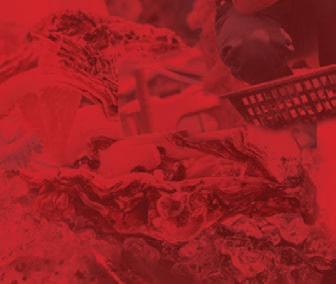

to Europe can be as divided as they are in Britain.
The national employer organisation, Seafood Companies (Sjomatbedriftene), is urging the Norwegian authorities to reject Mowi’s call for an exemption. Its CEO, Robert H Eriksson, has said the issue is not about protectionism, but the reputation of Norwegian salmon in the market.
He added: “What we are witnessing now is that more fish of poor quality end up on the market. When you consider this in the context of the challenges and negative publicity that have circulated in the media over the past six months, it does not contribute to building increased trust in our industry, neither here at home nor abroad.”
Seafood Companies argues that the exemption “will make it easier to turn a blind eye to the regulations.” Consequently, Eriksson expects that the department is aware of this and does not facilitate the “cheating to take place.”
It is going to be months, possibly longer, before the dispute is sorted out, but at the moment Norwegian authorities and the European Commission are like two dogs fighting over a bone. One will almost certainly have to bend but with Norway clearly having more to lose.
The entire EU now sees Norway’s export ban on farmed salmon as a trade barrier ”
























More wild fish should be eaten, not fed to salmon, a team of scientists has concluded, but not everyone agrees



CONSUMERS would get a better mix of nutrients if they ate more of the wild fish species that are typically used for salmon feed.
That’s the message from a study by scientists from four leading UK universities, who analysed the nutrient content of wild caught fish such as mackerel, anchovies and herring, and compared it to the nutrients in a typical farmed salmon fillet.
Oily fish contain essential nutrients including calcium, B12 and omega-3 but some of these are lost from our diets when we just eat salmon, the researchers say. They found that farmed salmon production leads to an overall loss of essential dietary nutrients and argue that eating more wild “feed” species directly could benefit our health while reducing aquaculture’s demand for finite marine resources.
flow of nutrients from the edible species of wild fish used as feed, to the farmed salmon they were fed to. They found a decrease in six out of nine nutrients in the salmon fillet – calcium, iodine, iron, omega-3, vitamin B12 and vitamin A – but increased levels of selenium and zinc.
Most wild “feed” fish met dietary nutrient recommendations at smaller portion sizes than farmed Atlantic salmon, including omega-3 fatty acids, which are known to reduce the risk of cardiovascular disease and stroke.


The researchers analysed the

“What we’re seeing is that most species of wild fish used as feed have a similar or greater density and range of micronutrients than farmed salmon fillets,” said lead author Dr David Willer from the Zoology Department at the University of Cambridge.
people should consider eating a greater and wider variety of wild fish species like sardines, mackerel and anchovies to get more essential nutrients straight to their plate.”
In the UK, 71% of adults have insufficient vitamin D in winter. Teenage girls and women often have deficiencies of iodine, selenium and iron. Yet while 24% of adults ate salmon weekly, only 5.4% ate mackerel, 1% anchovies and just 0.4% herring.
“Making a few small changes to our diet around the type of fish that we eat can go a long way to changing some of these deficiencies and increasing the health of our population and planet,” said Willer.
The researchers concluded that consuming one-third of current food-grade wild feed fish directly would be the most efficient way of maximising nutrients from the sea.
“Whilst still enjoying eating salmon and supporting sustainable growth in the sector,

“Marine fisheries are important local and global food systems, but large catches are being diverted towards farm feeds. Prioritising nutritious seafood for people can help improve both diets and ocean sustainability,” said senior author Dr James Robinson from Lancaster University.

This approach could help to address global nutrient deficiencies, say the team of scientists from the University of Cambridge, Lancaster University, the University of Stirling and the University of Aberdeen.
The study was published today in the journal, Nature Food. The scientists calculated the balance of nutrients in edible portions of whole wild fish, used within pelleted salmon feed in Norway, compared to the farmed salmon fillets.
They focused on nine nutrients that are essential in human diets and concentrated in seafood – iodine, calcium, iron, vitamin B12, vitamin A, omega-3 (EPA and DHA), vitamin D, zinc and selenium.
The wild fish studied included Pacific and Peruvian anchoveta, and Atlantic herring, mackerel, sprat and blue whiting – which are all marketed and consumed as seafood.
They found that these six feed species contained a greater or similar concentration of nutrients as the farmed salmon fillets. Quantities of calcium were more than five times higher in wild feed fish fillets than salmon fillets, iodine was four times higher and iron, omega-3, vitamin B12 and vitamin A were more than 1.5 times higher.
Wild feed species and salmon had comparable quantities of vitamin D.
Zinc and selenium were found to be higher in salmon than the wild feed species – the researchers say these extra quantities are due to other salmon feed ingredients and are a real mark of progress in the salmon sector.
Eat or feed?
“Farmed salmon is an excellent source of nutrition and is one of the best converters of feed of any farmed animal, but for the industry to grow it needs to become better at retaining key nutrients that it is fed. This can be done through more strategic use of feed ingredients, including from fishery byproducts and sustainably-sourced, industrial-grade fish such as sand eels”, said Dr Richard Newton of the Institute of Aquaculture at University of Stirling, whose team also included Professor Dave Little, Dr Wesley Malcorps and Björn Kok.
He added: “It was interesting to see that we’re effectively wasting around 80% of the calcium and iodine from the feed fish – especially when we consider that women and teenage girls are often not getting enough of these nutrients”.
Prioritising nutritious seafood for people can help improve both diets and ocean sustainability
Willer said: “These numbers have been underacknowledged by the aquaculture industry’s standard model of quoting Fish In: Fish Out (FIFO) ratios rather than looking at nutrients.”
The researchers would like to see a nutrient retention metric adopted by the fishing and aquaculture industries. They believe that, if combined with the current FIFO ratio, the industry could become more efficient and reduce the burden on fish stocks that also provide seafood. The team are building a standardised and robust vehicle for integrating the nutrient retention metric into industry practice.
“We’d like to see the industry expand but not at a cost to our oceans,” said Willer. “We’d also like to see a greater variety of affordable, convenient and appealing products made of wild ‘feed’ fish and fish and salmon byproducts for direct human consumption.”
Trade body Salmon Scotland does not accept, however, that the solution proposed is workable given consumer preferences. Dr Iain Berrill, Head of Technical at the organisation, said: “Public health advice is that we should all be eating oily fish, like salmon, more often. There is nothing stopping people from eating other oily wildcaught fish such as mackerel, anchovies or herring, but as this study makes clear most people don’t choose to do so. By comparison, farm-raised salmon is the UK’s most popular fish and demand at home and abroad continues to grow.
“Our sector uses only a tiny fraction of the fish meal and oil that’s produced, and we only use marine ingredients derived from wild fish that are responsibly sourced from managed fisheries.
“Scottish salmon is an efficient converter of feed with a feed conversion rate of around 1:1.1, meaning it takes just over 1kg of feed to produce 1kg of food.
“Alternative marine ingredients, including trimmings from other species, reduce our use of fish meal and oil from wild sources to produce millions of healthy, nutrition meals every year.”
Could an increased focus on using forage fish for human consumption put undue pressure on fish stocks?
Willer said: “I don’t think this is a particular danger as they are not consumed directly very much. Most of the species in the article are quite well-managed and we do not advocate catching more, just better distribution that retains nutrition better. Ideally more processing byproducts would be maintained within the food and feed supply chain, for which there is a lot of potential, and could make up for any redirection from marine ingredients.”
The research was funded by the Scottish Government’s Rural and Environmental Science and Analytical Services Division, a Royal Society University Research Fellowship, a Leverhulme Trust Early Career Fellowship, a Henslow Fellowship at Murray Edwards College and the University of Cambridge.



 Opposite from top: Fish feed; Dr David Willer
Above: Vitamin B12
Opposite from top: Fish feed; Dr David Willer
Above: Vitamin B12
A project aimed at restoring an oxygen-depleted lagoon could help one of Australia’s most endangered fish species – and it might win more public support for fish farming in Tasmania
SCIENTISTS working on a project to restore oxygen levels in Macquarie Harbour, Tasmania, say the first stage has proved to be a success.
The Macquarie Harbour Oxygenation Project (MHOP) aims to tackle the problem of low dissolved oxygen levels in the harbour, a large indented lagoon, roughly 33km long by 9km wide and with a 276km2 surface area, which is estimated to be six times the size of Sydney Harbour. A narrow entrance linking the lagoon to the open sea means water circulation is limited. This body of water typically has low levels of oxygen, but in recent years the problem has become more acute, threatening not only the farmed salmon there but also an endangered wild fish species, the Maugean skate.
Environmental campaigners blamed overstocking by fish farms for the falling oxygen levels, but an extensive study by marine scientists concluded that Macquarie Harbour has an intrinsic problem. It is stratified into distinct layers of water with different characteristics, with a top layer relatively rich in oxygen, a deeper layer which is more depleted and a middle layer which is even more oxygen-poor.
To try and remediate the lagoon, MHOP was set by the Tasmanian salmon aquaculture industry in partnership with Tasmania’s Institute of Marine and Antarctic Science (IMAS) and the Australian Government’s Fisheries Research and Development Corporation.



Following a successful fit-out, the MHOP research team and salmon companies have moored an oxygenation barge in place. In initial trials, the barge has been drawing water from the sea at depth. Highly concentrated micro and nano bubbles of oxygen are then injected into that water, before releasing it back into the deeper water sections of the harbour, elevating dissolved oxygen levels through passive diffusion and natural mixing.
Dr Jeff Ross, Associate Professor at IMAS said: “Installation of the scientific monitoring and sensor operations over the past two weeks have been productive. We have a live sensor array and live deck and underwater cameras operating, and despite some initial teething issues with pump operations, which we have now overcome, the oxygenation looked good on camera with no evidence of too much vertical movement of the plume or bubbles.
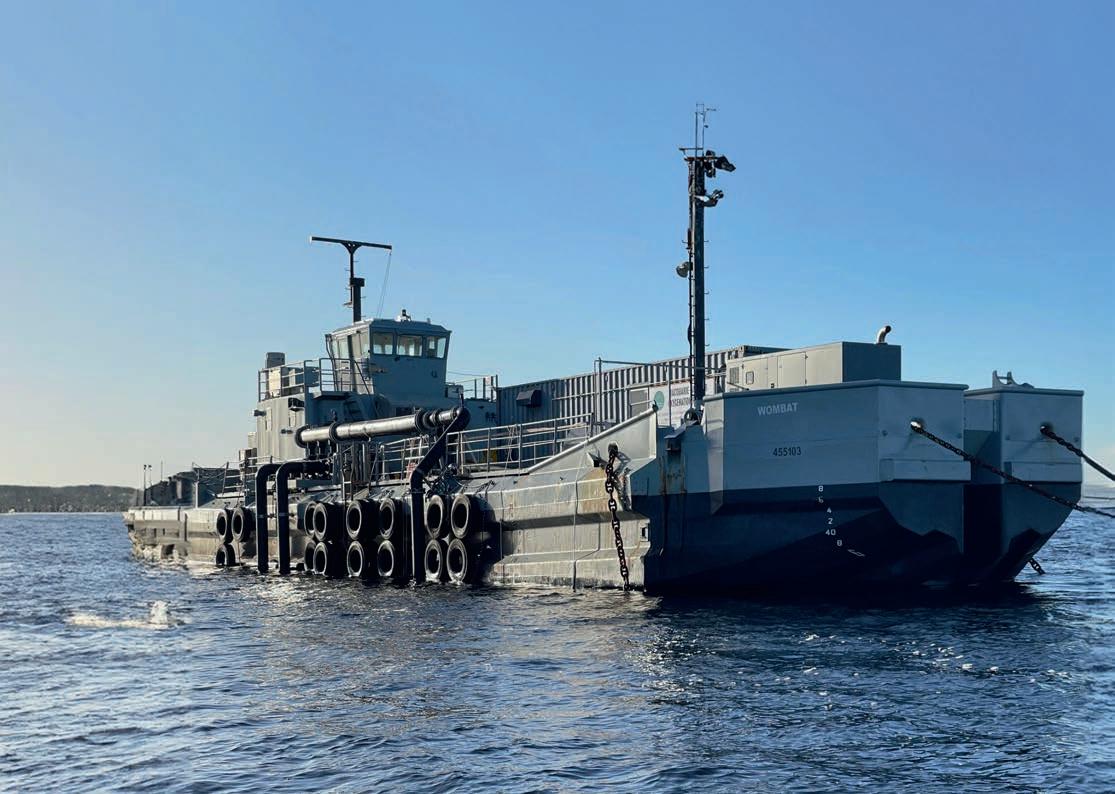


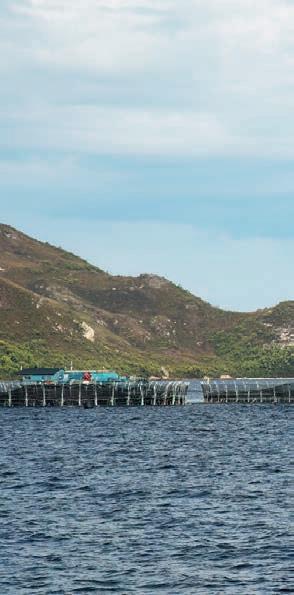
We are the one industry that is showing leadershipLeft: The Macquarie arbour gena�on Project vessel in opera�on Top : Salmon farm, Macquarie Harbour Opposite: Endangered Maugean skate

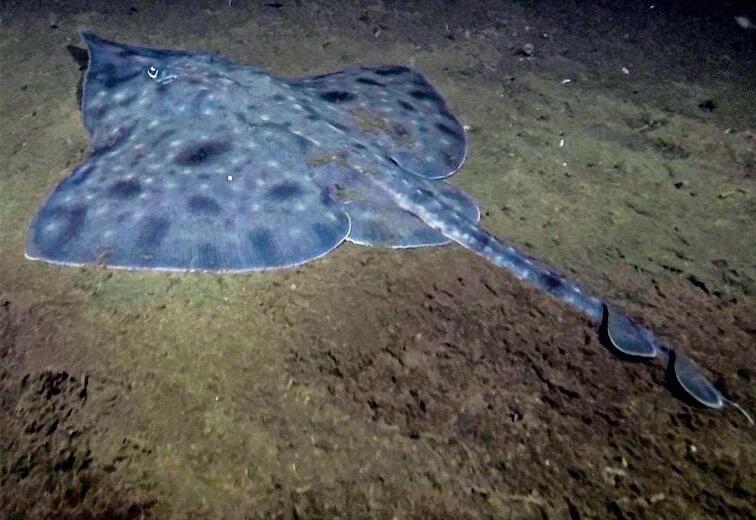
well. We will now increase this to 720kg/day over the weekend, take a breather before the next trial so we can process and digest the environmental and performance data, and we then expect to increase both the oxygen dosage and duration progressively over the coming trials.”
Salmon Tasmania CEO Luke Martin said: “We are the one industry that is showing leadership in responding to the threats to the skate amongst a myriad of inputs into the harbour. We are proud of the teams of scientists and operational crews who are leading the charge.
“The project will cost upward of AUS $7m [£3.6m] over the next two years and represents the industry’s major contribution to the Maugean Skate Conservation Recovery Plan. We stand up for a responsible and science-led aquaculture industry that is so critical to Tasmania’s economy and hundreds of Tasmanian families.
“Our objective is to test whether the MHOP could form part of a long-term strategy to improve the Macquarie Harbour environment for the skate, while responding to the challenge of warming waters and other climatic factors.
“At a minimum, we aim to offset the total oxygen drawdown of our own salmon aquaculture activities in the harbour and further reduce the impact of our operations on the environment.
“Whilst initial trials will use diesel to run the equipment, 100% of diesel used will be offset through carbon initiatives and once proven, we will be seeking a long-term renewable energy source.”
Martin added: “With farmed salmon being one of the world’s most carbon-friendly proteins, the importance of the success of our industry should not be understated.”










































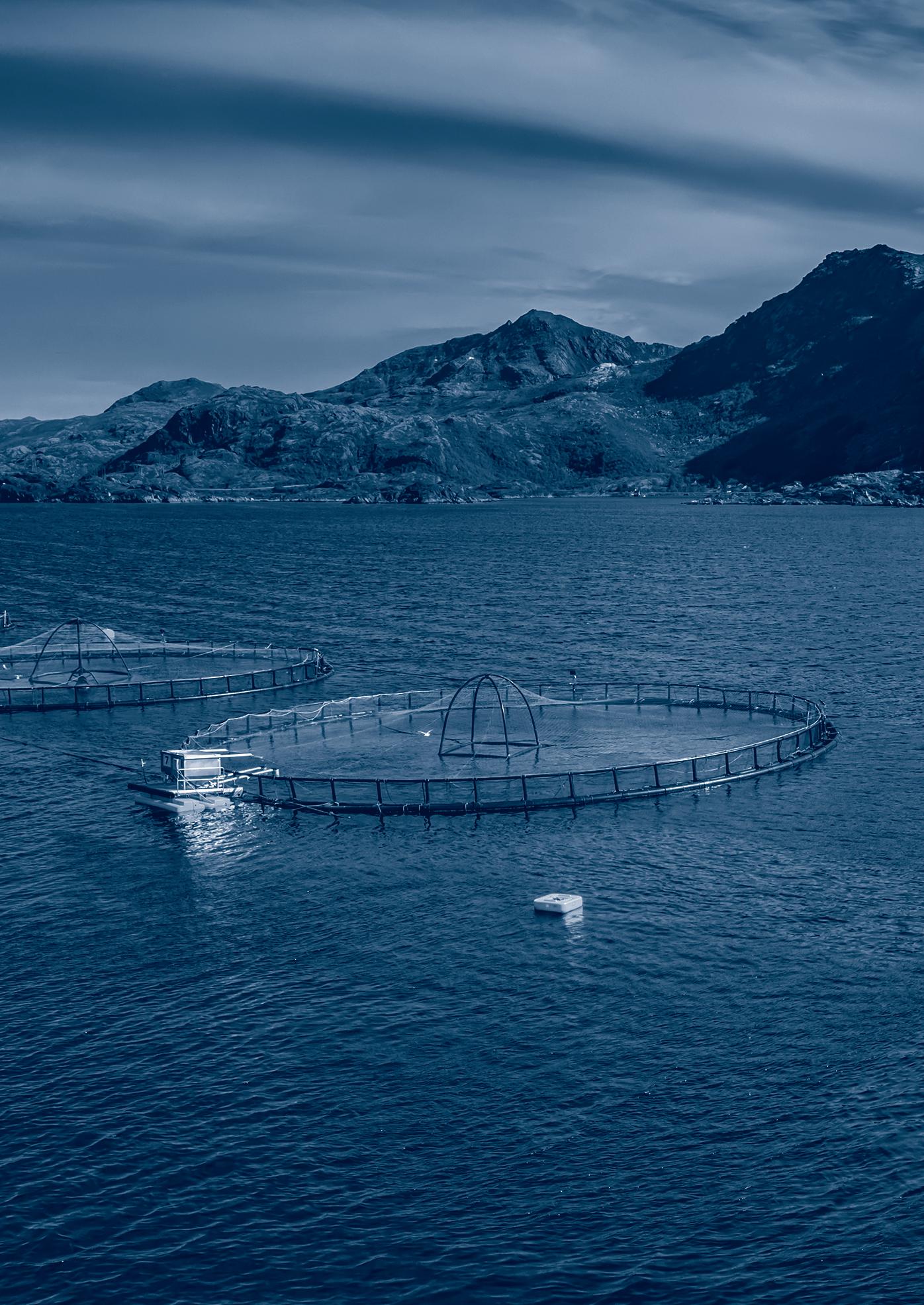



GETTING a licence to become a kelp farmer in California seems like a great idea. But before you check your bank account, find a location for the farm and search for a catchy name; you need patience.

tool for extraordinary places. Both seaweed generally and kelp in particular are nutritious marine plants. Kelp contains more calcium and has a higher iodine content than most other seaweeds.

According to the California Department of Fish and Wildlife, to grow kelp, farmers must:
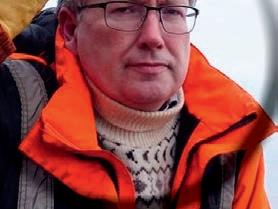
• register with the Department of Fish and Wildlife;
• obtain a state water bottom lease;
• complete an environmental review; and
• acquire permits for farming on the lease.
The process can take at least three and a half years and potentially up to a decade. “There is a lot of interest in obtaining licences, but few with the stamina to get through permitting as it currently is set up,” says Randy Lovell, State Aquaculture Coordinator at the California Department of Fish and Wildlife. “Land-based seaweed culture can also be challenging due to the shortage of seawater intakes.”
Kelp is an important part of the ecosystem and kelp aquaculture can be an effective
Lovell has a clearer definition: “Macroalgae comes in three groups: brown, green and red algae. All of them may technically be referred to as seaweed. The browns are often lumped together and called kelp. All kelps are seaweed, but not all seaweeds are kelp.”
Seaweed is in the algae family and kelp is essentially the largest subgroup of seaweed. Algae is a group of aquatic organisms that are mainly photosynthetic and nucleus bearing. In other words, they’re not your average plant: they lack stems, roots and other common plant characteristics. The beauty of algae is that it absorbs the atmosphere’s carbon dioxide and produces approximately 50% of oxygen here on earth.
One operation that has secured permits to operate an experimental kelp farm in federal waters off Santa Barbara, is Faroesbased Ocean Rainforest.
“Ocean Rainforest began in 2010,





when we combined our knowledge of this unique ocean environment with our strong entrepreneurial spirit to cultivate seaweed,” says CEO Olavur Gregersen. “We started growing and harvesting the same species of wild seaweeds that formed part of our ancestors’ diets over a thousand years ago, because we wanted to have a positive impact on people and the environment.”
Gregersen adds: “The inbuilt focus on research and innovation enabled us to develop world-class cultivation methods, making us Europe’s leading seaweed cultivator and a pioneer in our industry. Our small team shares the same values of passion, teamwork and

pioneering, and through a diverse set of skills and years of combined experience, we continue to explore the potential of this versatile sea plant and meet growing market demand.”
Why is kelp so important to aquaculture? California Sea Grant – a collaboration between the National Oceanic and Atmospheric Administration, the State of California and universities across the state – has some answers.
People began collecting and eating seaweeds in the Americas more than 14,000 years ago, though in modern times, these species have become associated with Asian cuisines. Seaweed cultivation is a more recent phenomenon: as late as the 1950s, nearly all the world’s supply of seaweed was wild-collected. In the 1960s, large-scale commercial production kicked off in Asia, where the industry grew rapidly. Gordon Drysdale, Chief Chef at popular Scoma’s restaurant on San Francisco’s Fisherman’s Wharf, believes seaweed has potential to play a bigger part in Western cuisine – if consumers could be enticed to try it.
“I’m disappointed that we don’t have as adventurous a clientele as I would like. I think the idea of a salad made with various seaweeds would be interesting and appropriate,” he says.
Drysdale adds: “The seaweed in our oyster plates is rockweed, referred to colloquially as lobster weed. It is common along the coast of Maine and is used to pack lobsters shipped from the East Coast. It is not really edible, at least not raw.
“However! I am excited about the myriad uses that are showing up not just as food sources (kombu, nori, dulse, etc), but most recently I shared with my wife my desire for a sweater I saw online made from seaweed.”
There are dozens of edible seaweeds out there, although they are much more present in, for instance, Japan and Korea than the States. Americans –and Europeans – are probably most familiar with nori, the sheets of toasted seaweed used in sushi restaurants.






Panel facilitator Lauren Linsmayer said her organisation, California Ocean Science Trust, is not necessarily advocating for people to start a kelp farm, however.
She explains: “My role was to facilitate the conversation. Our organisation’s role is to examine the science needs and knowledge gaps for the state in support of state policy and regulation development. The goal of the panel was to share with the audience the state of seaweed cultivation in California and information about the growing interest in seaweed farming.”
The panel consisted of seaweed aquaculture experts and practitioners representing industry, state government and local authorities: Randy Lovell (California Department of Fish and Wildlife), Natalie Arroyo (Humboldt County), Leslie Booher (Sunken Seaweed), Paula Sylvia (Port of San Diego) and Eliza Harrison (Ocean Rainforest).
Overall, the panel discussion illuminated growing interest in seaweed farming and different market opportunities, contrasted the perspective and experience of a small-scale nearshore farm (Sunken Seaweed) compared to a larger-scale offshore farm (Ocean Rainforest).



Among the seaweed-based brands being marketed to US consumers is the Gimme brand of seaweed snacks and sheets, featuring flavours such as sea salt and avocado oil, toasted sesame and wasabi. A panel at the recent Seaweed Festival in San Diego, on starting a seaweed farm in California, drew a large and interested crowd. According to one of the panellists and organisers of the event, the seaweed farming panel tends to be one of the most popular events.





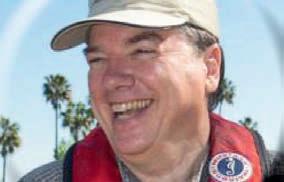

The panel covered a range of topics regarding seaweed farming in California, including reasons why people are interested in farming seaweed, on-the-ground experience in the Port of San Diego and Humboldt Bay, important factors to consider when deciding where to site a seaweed farm and some of the key operational and business planning needs.
Panellists discussed some of the reasons why people are interested in seaweed farming. There are many potential applications of cultivating seaweed, including for human consumption, medicines and cosmetics, feedstock for animals to reduce methane emissions and as a biofuel source.
“There’s a growing body of science showing that farming seaweed can be net beneficial to the environment and lead to restorative, regenerative and conservation outcomes when done responsibly,” Linsmayer said. “We need to ensure that science is serving as a guidepost for the seaweed farming industry and that seaweed farming is being done responsibly within a scienceinformed state regulatory framework.”
Farming seaweed can be net beneficial to the environment and lead to restorative, regenerative and conservation outcomesOpposite from top: Wild kelp bed, California; Gimme sea salt and avocado oil snack; Olavur Gregersen; Ocean Rainforest kelp, Faroes This page from top: Seaweed Fes� al, San iego Ocean Rainforest, California; Randy Lovell; Lauren Linsmayer





Bring confidence to your net cleaning job, with the most reliable pump on the market.
NLB’s high-pressure water jet pumps are proven reliable for offshore and onshore net cleaning. Engineered specifically for the aquaculture market, they withstand the harsh conditions of open seas, foul weather, and salt corrosion, all while delivering the same performance and durability NLB has been recognized for since 1971. Our units also offer a compatible interface with the industry’s leading head cleaning systems.
NLB will go the extra mile to make the switch easy for you. Let’s discuss your options at AquacultureUK!


Staying competitive in the dynamic fish farming industry requires a comprehensive approach to cover a multitude of inspections. Here to help is ARV-i, a state-of-the-art underwater robot designed by Boxfish Robotics (NZ) and SubC3D (Norway). This single system is engineered to address various operational tasks, enhancing sustainable and responsible aquaculture.
• Biomass Calculation: ARV-i’s AI and stereovision technology supports real-time fish population analysis, adhering to Norway’s rigorous fish farming standards.
• Net Monitoring Capability: prevent environmental impact with ARV-i’s inspection capabilities, allowing to identify issues promptly.




• Asset Monitoring: ARV-i’s proactive asset monitoring alerts you to necessary maintenance requirements, enhancing safety and reducing maintenance costs.
• Environmental Control Capability: ARV-i allows monitoring of various parameters like temperature, oxygen, and more, enabling data-driven farm management and sustainable practices.
ARV-i is designed with the steadfast reliability that fish farmers depend on. Built on a field-proven, renowned ROV (remotely operated vehicle) platform, it operates autonomously without the need for cables, simplifying usage while upholding the highquality standards vital to aquaculture. You can obtain immediate, accurate reports and easily analyse data, ensuring your operation remains at the forefront of efficiency and sustainability.
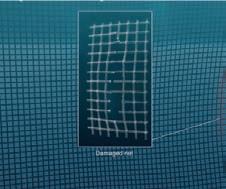

Experience ARV-i for a trusted advancement in your aquaculture operations. Contact us for more information on how ARV-i can enhance your farm’s productivity:
T: +64 9 600 1910 E: info@boxfishrobotics.com
www.boxfishrobotics.com/arv-i
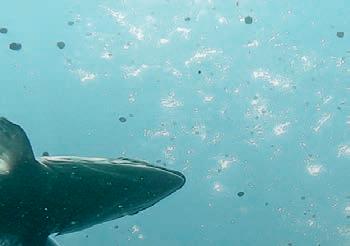
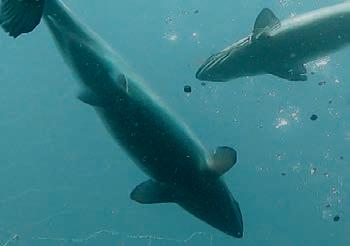



SmartCare Calm is a new feed developed with today’s production methods and challenges in mind. Our documentation has shown it to have a positive effect on feed intake, growth, and pigmentation. This makes the fish better prepared for handling operations, allowing it to return quicker to normal feeding behaviour.
Visit our stand to learn more at Aquaculture UK: D10


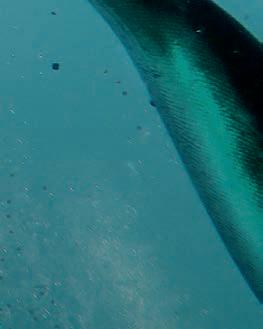



The Center for Aquaculture Technologies Canada has launched a tenacibaculosis model to assist farms in combating growing disease challenges
In 2023, the Norwegian salmon industry experienced the loss of 62.7 million Atlantic salmon before they reached market size, marking an increase in mortality by 6 million salmon from the previous year. The largest contributors to this increased mortality were health issues arising from a variety of infectious diseases, among them tenacibaculosis. Outbreaks of tenacibaculosis have notably risen over the past decade and present a growing challenge to the salmon industry. Tenacibaculosis presents a major economic and welfare concern to salmon farmers. Afflicted fish develop ulcerative lesions that, if not initially fatal, are at risk of developing complex secondary infections. These infections may be difficult to treat and aid the spread of further disease within a pen. The value of surviving fish is also reduced, as tenacibaculosis results in poor weight gain and damages fillet quality.
This disease predominantly affects smolts newly transferred to sea cages. Outbreaks are triggered by a variety of factors, but environmental stressors are of high concern as climate change drives record high ocean temperatures. Thermal stress delivers a double whammy for farmers, weakening the immune system of salmon while simultaneously creating an environment for many pathogenic bacteria to thrive in.
To tackle this concern, increasing biosecurity and improving water quality is important, though preventative treatment presents the simplest and most effective longterm solution for farmers in







reducing the incidence of tenacibaculosis. No commercially available salmonid vaccines are currently available, however, and with growing demand from consumers for antibiotic-free animal products, the current antibiotic treatments are not a reliable or longterm solution.
The Center for Aquaculture Technologies Canada (CATC) recognised a gap in the industry tackling this challenge and has commited to remaining at the forefront of challenge model development. The threat of infectious disease, both novel and native, is increasing alongside rising ocean tempatures, and staying ahead of these changes in the market has been a priority of CATC since inception.
Given the escalating concern surrounding tenacibaculosis, CATC saw it as imperative for the salmon industry to prioritise the development of sustainable, efficient strategies for outbreak prevention and control, which led to the development of the Tenacibaculosis Challenge Model. CATC’s Tenacibaculosis Challenge Model is reliable and consistent, which is essential


caused b Tenacibaculosis
Opposite (top): Atlan�c salmon ith gill lesion caused b Tenacibaculosis
Opposite (below): Atlan�c salmon ith ulcera� e skin lesions caused b Tenacibaculosis
Above: Atlan�c salmon ith mouth erosion






for developing effective management strategies, such as vaccines, feed additives, or identifying genetically resistant strains.



This represents a breakthrough for the sustainability and profitability of salmon operations ”
“Over the past years, tenacibaculosis has emerged as one of the most severe bacterial infections affecting various farmed fish species across different geographical regions. For instance, the emergence of disease caused by T. maritimum, along with new Tenacibaculum species, now poses a significant threat to the global salmon farming sector,” states Dr. Fabio Zanuzzo, Head of Aquatic Animal Health at CATC. “Our unique Tenacibaculosis Challenge Model offers the salmon industry a powerful and distinctive resource for developing effective strategies to address this evolving and complex disease. This represents a breakthrough for the sustainability and profitability of salmon operations.”
CATC’s robust model supports the industry in assessing the efficacy of various treatments, whether administered before, during, or after infection with Tenacibaculum maritimum Providing customization and flexibility, combined with the reliability of this challenge model, CATC’s Tenacibaculosis Challenge Model allows for studies to simulate acute and chronic infections, offering a framework for analysing a range of clinical signs and mortality.
Tenacibaculosis remains a distinct challenge to aquaculture, posing a threat to the health and economic viability of the industry. However, with this innovative service offering from CATC’s Aquatic Animal Health & Laboratory Technologies divisions, aquaculture facilities can mitigate the risks associated with tenacibaculosis outbreaks through continued product development in the line of vaccines and feed additives poised to tackle this problem.
Continuous research, cooperation and innovation within the aquaculture sector is crucial for the industry to succeed faced with the continuous threats and changes in the market, and The Center for Aquaculture Technologies Canada continues to be committed to the sustainability and success of aquaculture globally.


This year’s edition of the UK’s leading aquaculture trade show promises to be bigger and better than ever

THIS May will see the return of Aquaculture UK, which is once more being held in Aviemore in the Scottish Highlands.
With huge interest being demonstrated by exhibitors and registrants, this show looks set to retain its position as the UK’s leading aquaculture gathering.
On Tuesday 14 May, Scotland’s Rural Affairs Minister Mairi Gougeon (pictured above at Aquaculture UK 2022) will open the show and will head an exciting line-up of speakers.
The Keynote Theatre programme, now published, runs alongside the two-day exhibition on 14 and 15 May and is free to attend. Gougeon will update delegates on progress in regulatory reform following Professor Russel Griggs’ independent review of aquaculture consenting, published two years ago.
And she will outline ongoing work to support innovation in the sector as part of the Scottish Government’s ambitions for the industry, as highlighted in the Vision for Sustainable Aquaculture to 2045.
The minister will also address a Women in Scottish Aquaculture networking session, which will focus on professional training and improving communication skills.
Other conference keynote speakers include Kevin Quillien of Glasgow-based space tech firm Krucial who, along with risk management consultant and aquaculture veteran Jason Scott, will explore how digitisation can help mitigate the risks of fish farming.



Cheri Arvonio, Event Director at show organiser Diversified Communications, said: “We look forward to welcoming a wide range of aquaculture experts over the two days.
“With Scotland’s Cabinet Secretary for Rural Affairs and Islands Mairi Gougeon opening the conference, we expect full houses to hear about all the developments in the sector since we last met here two years ago.”
Arvonio added that this year’s show is set to feature more exhibitors than ever, with 230 signed up from 20 countries. Inside space had already sold out before the end of March.
There will be three new national pavilions this year, with Ireland, Canada and Chile represented for the first time at Aquaculture UK.
New this year is the Innovation Theatre, which will feature more, but shorter, presentations compared with the Keynote Theatre.
And US data experts Scoot Science will lead a panel of farm and health managers from Scotland and Canada, including Scottish Sea Farms’ Innes Weir and Bakkafrost
Scotland’s Kimberley McKinnell, to discuss new environmental challenges and how tech can improve fish survival.
The Sustainable Aquaculture Innovation Centre (SAIC) celebrates its 10th anniversary this year and will mark the milestone with

We expect full houses to hear about all the developments in the sector
From the top: Mairi Gougeon MSP at Aquaculture UK 2022; Cheri Arvonio; Kimberley McKinnell

We’re delighted to be exhibiting again at Aquaculture UK in Aviemore from 14 to 15 May, and very much look forward to seeing you there.
• Temperature-controlled and ambient road haulage and freight shipping
• Cargo handling and storage
• Pallet distribution
info@northwardsltd.co.uk northwardsltd.co.uk

presentations from project partners covering a decade of impactful research and development. There will also be an update on how SAIC, under new funding arrangements, will continue to drive research to meet key sector problems.
From Chile, innovative enterprises – from nano bubble pioneers to biotechnology frontrunners – will examine technology trends in Chilean aquaculture, with representatives of cutting-edge suppliers both at the conference and exhibiting in the Chile pavilion.
Canadian expertise has its own platform, with the return to this year’s conference of the Center for Aquaculture Technologies (CAT), delving into the possibilities that gene editing (GE) brings to improved productivity and environmental sustainability in aquaculture.
CAT speakers Alan Tinch and Alejandro Gutiérrez will focus on the development of resilient species, and will also look at the current regulatory landscape for GE in aquaculture, particularly in the UK and Europe.
The adoption of alternative feed ingredients by salmon farmers is a hot topic sector-wide and will be in Aviemore too, when Ian Carr, Global Business Development Director of algal oil innovator Veramaris, chairs a panel of novel feed advocates and asks: “What will it take to drive the use of alternative ingredients in Scotland?”
And some of the most familiar challenges in land-based aquaculture will be tackled by Xylem Water Solutions engineer Asbjørn Husby and Business Development Director Ronny Haugland, who are spearheading advances in semi-closed and closed containment, RAS and optimal energy consumption.
Aquaculture UK also provides an opportunity to recognise excellence within the sector. On Tuesday evening, industry body Salmon Scotland will announce the winner of the Early Career Innovators Competition from Young Aquaculture Society (YAS), held in collaboration with the University of Stirling’s Institute of Aquaculture and Diversified Communications.
The initiative comes less than six months after YAS was founded by Salmon Scotland’s Technical and Standards Manager Andrew Richardson, who is president of the society. He said: “Early career professionals entering the field inherently bring fresh perspectives, making them well-positioned to generate impactful ideas.
“It’s exciting for us to introduce such a prize at this early stage of our organisation’s journey. We are grateful to the Institute of Aquaculture and Aquaculture UK for sharing our mission.”
On Wednesday night, 15 May, the Aquaculture Awards will be presented at a gala dinner to be held at the Macdonald Resort, Aviemore. This year, the awards include 13 separate categories and this year saw a high number of entries.
Awards will be announced for:
• Rising Star
• Collaboration
• Innovation
• Sustainability
• Community Initiative
• Farmer of the Year
• Animal Welfare
• Aquaculture Supplier of the Year
• Best New Start-Up
• Unsung Hero
• Producer of the Year






There will also be a Judges’ Special Recognition award, to be announced on the night, and an award for Outstanding Contribution, which will be based on votes cast by those in the industry.
Aquaculture UK, which is free to attend, will be held at the Macdonald Resort in Aviemore, Scotland, on 14 and 15 May 2024. Show opening times are 14 May, 9:30am to 6pm (including social event) and 15 May from 9:30am to 4pm. For the full conference programme, visit aquacultureuk.com
Your fish feed specialist

Working together to Translate science into sustainable farming



Alltech Coppens awarded EcoVadis golden medal for sustainability e orts
Find out more at: alltechcoppens.com/sustainability

Aquaculture industry companies and suppliers are looking forward to the sector’s biggest trade show in the UK
AS the UK’s leading trade show for the fish farming industry, Aquaculture UK is keenly anticipated by the organisations taking part – even more so because it only takes place once every two years.
Fish Farmer asked some of the organisations that will be represented in Aviemore about their expectations for the event and why they see it as important to be there.
Benedikte Ramun is Head of Marketing with the Sustainable Aquaculture Centre (SAIC). She says: “Ever since SAIC was formed a decade ago, we have supported Aquaculture UK. Nothing beats getting together in person to exchange ideas, learn about shared challenges, explore potential solutions and network with fellow professionals across the sector.
“We will proudly be celebrating ‘Ten Years of Innovation with Impact’ in the conference tent, where business and academic partners will help us showcase some of our important work over the years. We will also be updating the sector on how SAIC will be driving R&D to help improve fish health and welfare into the future. And there will be a rich programme on our stand for SAIC Consortium members to present their innovative products and services.”
Panaferd, which produces naturally sourced, organic astaxanthin, will be in Aviemore. Arkadiusz Borowiec, the company’s Sales Manager Europe, says: “It is important to be represented at Aquaculture UK because it gives an opportunity to get in touch with different stakeholders and have direct contact with Scottish aquaculture experts.


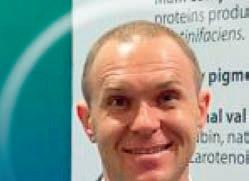

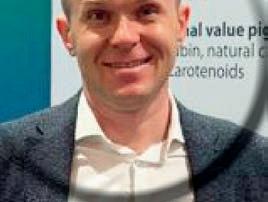
“It is a great platform for networking and hear from not only customers (feed companies) but other parties like farmers, processors, distributors and retailers. It is great to see a full market spectrum under one roof.”
He looks forward to talking about Panaferd’s “sustainable and natural solution”, and how it can enhance fish welfare.
The major fish farming companies in Scotland and throughout
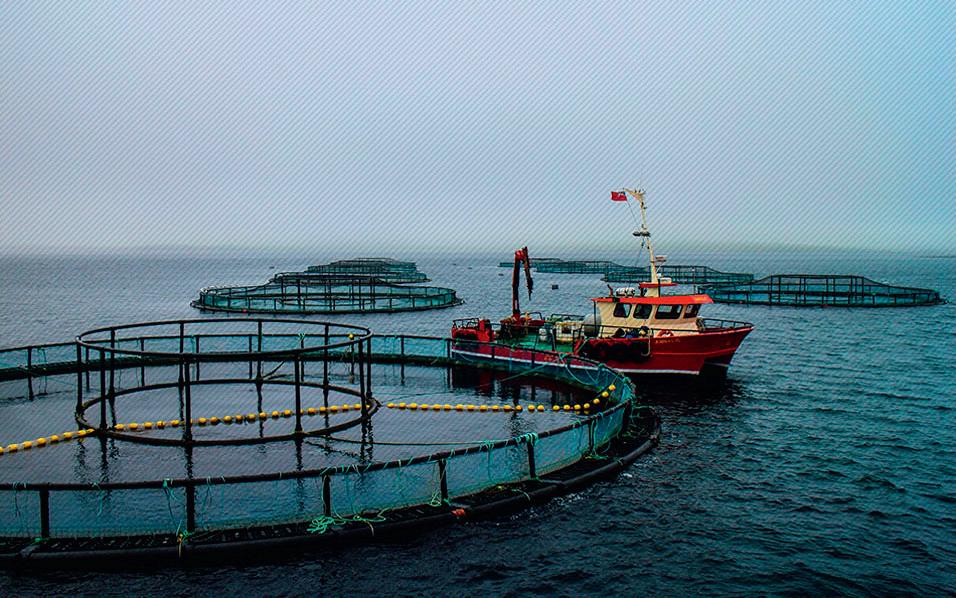
the UK will be at Aquaculture UK, too. As Murray Spooner, Communications Manager at Cooke Aquaculture Scotland, puts it: “It is important for the aquaculture community to come together in person to share innovative ideas and highlight the latest developments in the industry. We look forward to strengthening our relationships with our customers and suppliers at Aquaculture UK.”
Simone Boiocchi, Marketing Manager with Italian marine crane specialist HS. Marine, says: “It’s crucial for us to be represented at Aquaculture UK because it’s a way to meet key stakeholders in the aquaculture industry. This event brings together industry leaders and practitioners, providing an important opportunity to showcase our cranes, learn about emerging trends in the aquaculture sector and consolidate our presence as a key player in the UK sector.”
Boiocchi will be stressing the company’s commitment to developing solutions that are specifically made to face all types of marine conditions, as well as ongoing customer service.
He says: “We have high expectations for Aviemore as a place for networking, knowledge exchange and business development. We look forward to showcasing our products and services to
It’s crucial for us to be represented at Aquaculture UK
From


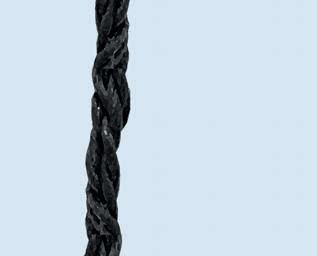



Seamix is a specially formulated simulated sea water mix for the aquaculture industry. This simple to use, DEFRA approved formula is ideal for creating clean seawater free of bacteria and perfect for shellfish purification, holding tanks, aquaculture operations and equipment testing. Just add tap water!
PDV, Sea & Rock Salts
Sodium Bicarbonate
Calcium Chloride
Peacock Salt, North Harbour, Ayr, KA8 8AE
Magnesium Chloride
Hydrated Lime and more.
T 01292 292000 F 01292 292001
E info@peacocksalt.co.uk



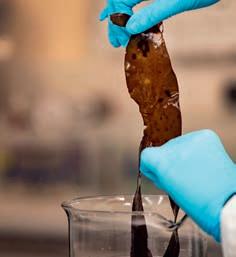
HIGHLANDS AND ISLANDS
FOOD AND DRINK AWARDS
INNOVATION SUPPORT
FOOD AND DRINK TECHHUB
HIE BUSINESS SUPPORT
TECHNOLOGY PLACEMENT PROGRAMME

A3 SCOTLAND 2024 CONFERENCE
ADVICE AND FUNDING
Come visit us at stand D16 at Aquaculture UK to find out about upcoming events that are relevant to your business, and how we can help you.


























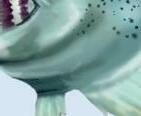



























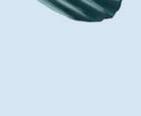






















































Find out more: hie.co.uk / a3scotland.com SEA








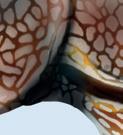























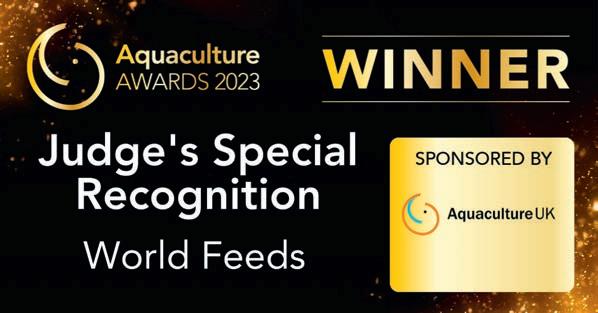











a diverse audience of potential customers, aiming to generate interest and awareness about our valuable offerings, which represent significant opportunities in the aquaculture sector.”
AquaGen, a research-oriented breeding and genetics company, has been through a structural evolution and the show will provide an opportunity to explain what that means for the company.
Keith Drynan, Managing Director of Aquagen Scotland, says: “Our key messages will be around the power of genetics – what has been and can yet be achieved. We have opportunities in the UK to address some of the challenges in production by obtaining and utilising data on gill health amongst populations we have at sea. We’ll also be discussing how we have tackled the relative isolation of the populations between UK and Norway, and how we might influence this in the coming years.”
He adds: “As ever, I’m sure the show will be well laid out and run, and provide a forum to speak with clients old and new. I only hope we also see the fine weather we have experienced around the past few events!”
“Our key message will be that fish health monitoring, as opposed to diagnostics alone, brings additional real-time information into production decisionmaking, well in advance of those decisions being made, meaning that they are better ones.”
Also at the event, pump specialist NLB Corporation will be showcasing its leading water jet technology. Jordan Smietana, Marketing Manager, says: “It’s critical for us to participate in Aquaculture UK to showcase our high-pressure net cleaning pumps, offering unparalleled durability for on-shore and off-shore cleaning needs.







Another big name in the field of breeding and genetics is Benchmark, which will, as usual, be exhibiting in Aviemore. Birgitte Sørheim, Marketing Director Salmon, says: “The UK industry is important to Benchmark… [Aquaculture UK] is a good occasion to introduce new products and services as well as new members of our staff to the industry.
“Our key message is that we are supporting the industry with products and solutions to improve their productivity, animal welfare and sustainability. We see ourselves as a responsible collaborator, who are continuously innovating to help the industry to improve their operations and to reduce their footprint.
“At this year’s event, we have several new products and services to promote. Benchmark Genetics is launching a new product portfolio better adapted to the customers’ demand for improved growth or enhanced robustness. These products are branded as SalmoBoost and SalmoRobust.
“We are also promoting our new offering of cost-effective genotyping services targeting a wider range of aquaculture species and applications. Benchmark Animal Health is presenting the next generation of water purification systems, CleanTreat Integrated for wellboats along with MMC First Process. We believe this solution will increase efficiency, sustainability and profitability of the salmon industry.”
Chris Mitchell is Business Development Manager with Wellfish Tech, a spin-out from the University of the West of Scotland, which has developed an innovative approach to assessing fish health through, among other things, blood sampling.
He says: “As a growing start-up business with a novel and complex offering within the fish health and welfare sector, it is vital for us to become and remain highly visible in the marketplace.

“Our primary message is on the technological advancements NLB has made in tackling key challenges in aquaculture, including saltwater erosion, noise reduction, emissions and maintenance efficiency.
“At Aviemore, we anticipate networking with companies seeking immediate and futurefocused solutions in the aquaculture industry.”
PME Power Systems Group, the UK and Ireland importer for MAN marine engines, will be exhibiting at Aquaculture UK for the first time this year.

Marketing Manager Jade Chalk says: “PME has been watching the growth of Aquaculture UK as a forum for boat builders, skippers and fleet managers to explore emerging technological advances specific to their industry.
“We will be representing three major propulsion and generator options: MAN, Northern Lights and Lugger Engines. With a focus on reduction of tail pipe emissions, existing vessel life extension and new builds, we will be delighted to discuss the latest Tier 111, hybrid and Euro Stage V technology.”
PME Group have chosen to invest this year in exhibiting at Aquaculture UK, Chalk says, because the company believes its suite of products will be of real interest to visitors.
She adds: “We hope to take away contacts who would like to explore in-depth options


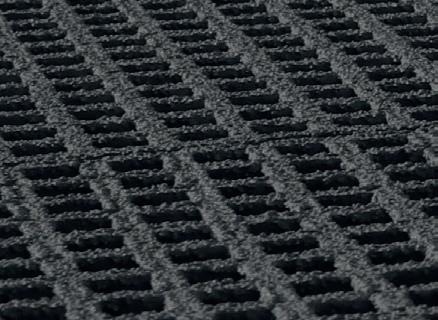





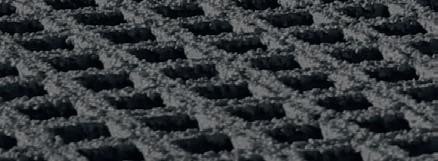














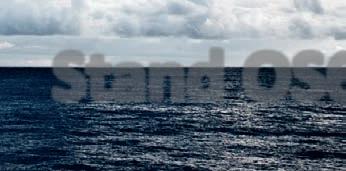













available for upcoming projects, whether they are new vessel builds or repowers.”
and providing specialist air solutions designed and built to provide maximum durability in challenging aquaculture environments to ensure maximum process reliability and minimise the risk of downtime.
Tritonia Scientific provides underwater surveying through the use of remote sensing techniques and scuba diving. It also produces detailed models of seabed features and submarine infrastructure using georeferenced 3D photogrammetry.
Tritonia has recently been incorporated into the Ocean Ecology Group, which provides a wide range of marine surveying and consultancy services across several different industries. This, the company says, has greatly increased the range of services Tritonia and Ocean Ecology can now collectively offer.





Also talking about technology will be Kerr Compressor Engineers, which will be exhibiting a range of KAESER air products and solutions, specifically designed and built to provide maximum durability in aquaculture environments.

Cameron Kerr, Director of Kerr Compressor Engineers, and Adrian Feiler, Business Development Manager Aquaculture at KAESER KOMPRESSOREN, told Fish Farmer: “As an experienced supplier to the Scottish aquaculture community, we provide specialist air solutions for onshore and offshore applications throughout Scotland. As the UK’s leading trade show and largest meeting place for aquaculture professionals, Aquaculture UK is the ideal event to meet with key decision-makers from across the industry, including existing and potential new customers. Our prominent stand positions, both inside (C11) and outside (OS76), allow us the opportunity to exhibit, demonstrate and discuss KAESER’s latest specialised products, innovative technology and the professional services we provide 24/7 – 365 days a year.
“As a biannual show with a large in-person exhibition and simultaneous conference programme, Aquaculture UK draws visitors and suppliers from all over the UK and around the world. This provides a valuable opportunity for our specialist engineers and supplier partners’ product managers to network and discuss the latest technology and innovative new products.” They will be underlining the commitment of Kerr Compressor Engineers and KAESER KOMPRESSOREN to continue developing


Kate MacKichan, Aquaculture Lead at Tritonia, says: “We see Aquaculture UK 2024 as an unmissable opportunity to get the word out about this new relationship and to make known the opportunities this opens up for both companies to provide increased value to the sector. The UK’s largest trade fair [for aquaculture] is the ideal forum to get the message across.”
In particular, she will be talking about underwater 3D georeferenced photogrammetry and its potential for use in seabed compliance monitoring. This is likely to be of particular value in hard-substrate sites which cannot be directly sampled (in other words, using a grab). The challenge is to develop appropriate metrics to be used in compliance assessment.
Another focus will be the analysis of eDNA, which is rapidly becoming a viable option for environmental and compliance monitoring. eDNA data is currently accepted by SEPA during compliance monitoring surveys. Although this is currently limited to a narrow substrate range, the analysis has the potential to complement and/or reduce the need for labour-intensive traditional taxonomic approaches. eDNA can also be used as an effective diagnostic tool, investigating community structure in the surrounding water column or sediment, and assisting in the detection of pathogens and viruses.
She adds: “We know from experience that this will be a busy and rewarding event. There will be plenty of interaction with visitors, including both existing and potential customers, with the opportunity to discuss, explain and demonstrate the services we can offer to interested parties.
“Additionally, we will have the opportunity to look around and see what other exhibitors are doing – keeping abreast of new developments in aquaculture, forging new business connections and building on existing relationships.”




With depots across the country, we offer a national supply of marine gas oil and HVO to both storage tanks and direct to vessels. We are attending Aquaculture
E: enquiries@oilfast.co.uk
W: oilfast.co.uk


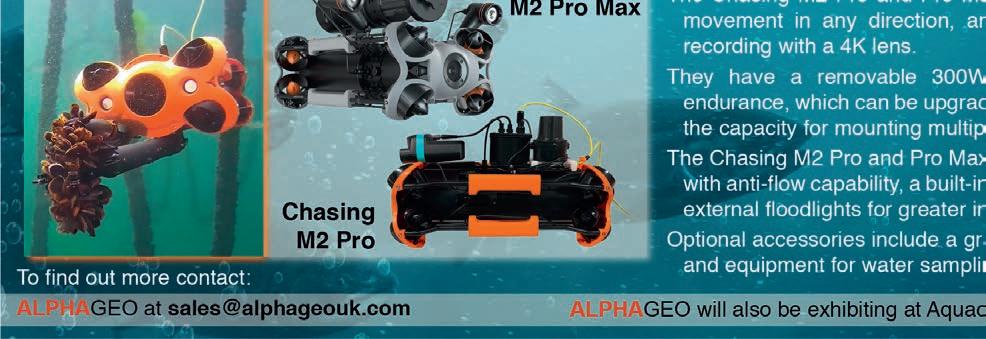





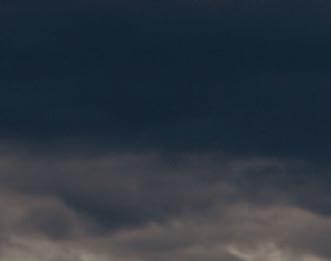










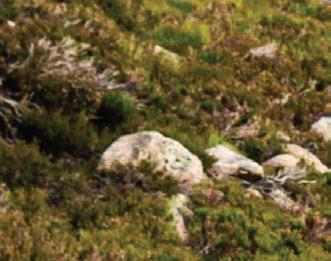


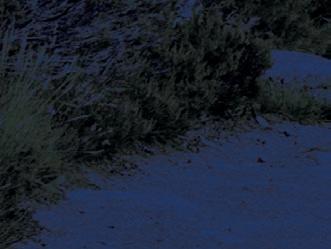

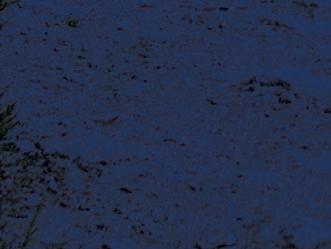



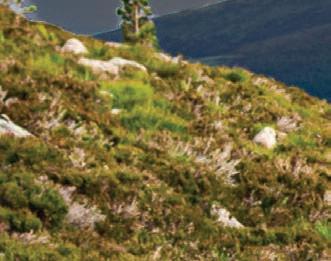




















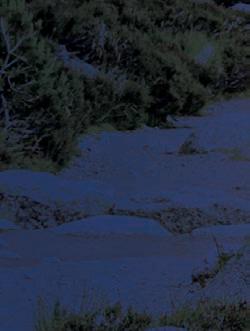


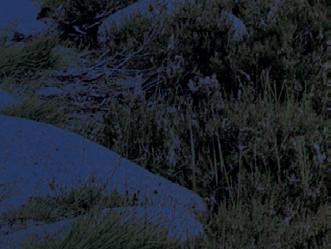













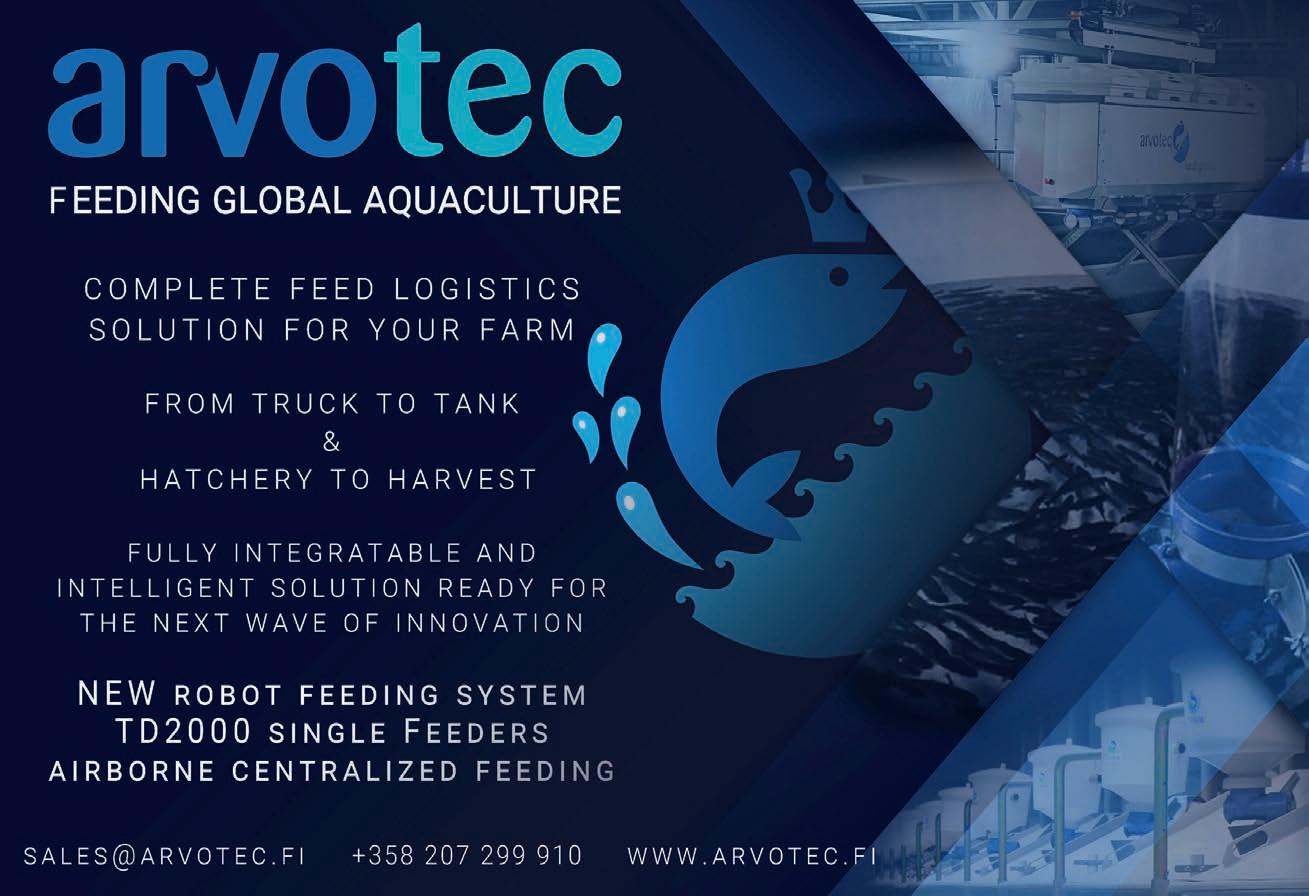

In aquaculture, fish and shrimp are constantly exposed to pathogen pressures, environmental fluctuations and other production stressors, negatively impacting survival and productivity.
At dsm-firmenich, we offer solutions to protect aquatic animals, reducing the risk of health and welfare challenges throughout the production cycle.
We bring progress to life Learn
OTAQ introduces LPAS to combat harmful algae blooms: a game-changer in aquaculture monitoring


Within the aquaculture industry there are increasingly frequent reports of Harmful Algal Blooms (HABS) being responsible for devastating fish kill events, in some cases with a single event wiping out an entire farm’s stock. In order to mitigate this, farms have been forced to perform routine, daily monitoring to provide them with the greatest amount of time to react and reduce damaging effects.
Current strategies are not without their challenges, however. Monitoring of algae is a very time-consuming process, taking up valuable time of team members which could be spent on other vital duties. Furthermore, the identification of microscopic algae can be incredibly difficult, even for trained experts. Team members performing algal monitoring duties are typically not trained microbiologists, so misidentifications, errors, and biases are often introduced in the monitoring process, reducing its efficacy.
Lastly, as HABs are a challenge typically being tackled alone, by individual farms or companies, there is little standardisation across the industry with regard to monitoring techniques and target harmful
Since 2021, OTAQ have been working on the development of LPAS (Live Plankton Analysis System), an automated algal identification system that incorporates artificial intelligence to identify and quantify complex groups of microscopic algae that are harmful to aquaculture. OTAQ has been working closely with Canadian machine learning and algae specialists Blue Lion to develop the technology, with support from the Sustainable Aquaculture Innovation Centre (SAIC), CENSIS – Scotland’s Innovation Centre for sensing, imaging and Internet of Things (IoT) technologies – and the University of Aberdeen.
In order to develop LPAS ready for launch into marine farm environment use, OTAQ undertook a comprehensive global image collection program incorporating multiple collection microscope systems spread around the globe in key salmon farming sites. With over 20 aquaculture market collaborators including industry bodies, academia and farmers in Scotland, Ireland, Chile, Norway, Canada, Australia and New Zealand, over 80,000 live images have been gathered to capture necessary volumes of representative data on target harmful algae. The AI model within the LPAS has been trained using these images to ensure accurate and consistent identification and quantification.
Continuing from this image collection program for the AI training, OTAQ also undertook a comprehensive Beta testing phase, building 20 LPAS Beta units and deploying them at live collaborator sites during peak algae seasons to gather


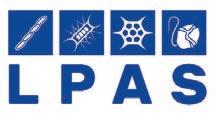


extensive testing results and feedback on the product and AI performance.
Based on insights gathered from the close collaboration with industry stakeholders, LPAS has been purposely designed from the ground up for deployment and utilisation within marine farm environments. With careful consideration of current industry practices and environmental factors, LPAS provides a practical on-site solution that very easily integrates with existing farm infrastructure and testing procedures.
This innovative system not only streamlines on-site operations, reducing time commitments for team members, but also enhances the accuracy and confidence in identifying and quantifying harmful algal species. Furthermore, LPAS provides a means of standardising the monitoring of a global risk across the aquaculture industry.
Now ready for market, LPAS offers a comprehensive array of features and benefits tailored to meet the needs of marine farmers:
• Automatic, accurate detection of 15 target harmful algae groups, with ongoing training to expand this list based on collected phytoplankton images.
• As well as identification, LPAS provides counts and calculations of the concentration of each of these groups. All results are captured and logged within the LPAS analysis and user interface software.
• The LPAS software records and presents the collected phytoplankton results for analysis and comparison with historical trends.

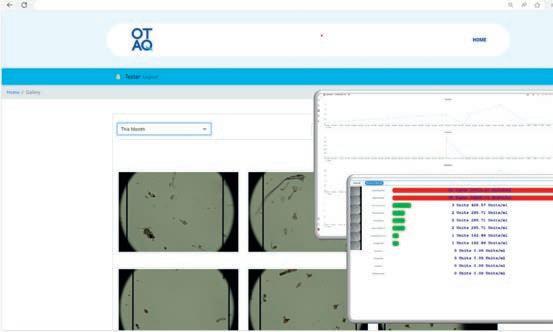



• Customisable alert thresholds, enabling each user to set their own alert thresholds based on the concentrations of particular algal groups and whether an acceptable level has been exceeded.
• High-resolution images of the collected water samples are recorded and clearly presented for both AI and manual analysis.
• Integrated phytoplankton identification guide and measurement tools assist the operator with the identification of all phytoplankton, including algae groups not currently in the AI model.
• Secure access to the results, history and images, both locally and via a cloud portal.
Conclusion: LPAS - transforming aquaculture safety OTAQ believes LPAS provides an extremely valuable tool for farmers to combat the rising threat of Harmful Algae Blooms. By integrating specialized AI technology to automate the identification and quantification of harmful algae and streamline monitoring processes, LPAS saves time, enhances accuracy and frequency, and will assist in standardising practices across the industry. LPAS marks a significant advancement in safeguarding aquaculture against devastating HAB events.
LPAS has been shortlisted for the coveted Aquaculture Award for Innovation at the Aquaculture Awards 2024 event on 15 May in Aviemore, Scotland.
For more detailed information on LPAS, please contact OTAQ at info@otaq.com
LPAS provides an extremely valuable tool for farmers to combat the rising threat of Harmful Algae Blooms
Maintaining the integrity of nets is essential for a fish farm – but can be expensive. Fortunately, there is an answer to the dilemma
Containment of stock is a key aspect of husbandry operations, of vital importance for the fish farmer from an economic and regulatory position. Avoiding issues created by escaped fish is beneficial to all. No farmer wants to lose their fish, for any reason.
Small holes in fish farm nets can appear where predators have tried to gain access, or the net has snagged on a piece of equipment during operations. Until repaired, the holes can develop to form a weak part in the net, risking more attacks and further damage by predators or they can get bigger, allowing fish to escape.
Identified during routine containment checks by ROV or during net washing, these holes are recorded, and urgent repairs planned. Historically this has meant calling out a dive team at short notice to carry out repairs. That’s a time consuming and expensive process that can face delays due to factors such as availability of dive teams or the time taken to travel to remote sites.
Underwater Contracting (UCO), a leading provider of underwater services to the aquaculture market, has developed a unique ROV (remotely operated vehicle)-deployed system which can make immediate repairs to these small holes, removing the cost and inconvenience of having to call out a dive team at short notice.
The need for a more efficient solution to emergency repairs was identified during subsea operations carried out by UCO’s Foover, its flagship mort recovery tool used at fish farm sites worldwide. In response to this need, UCO developed NetFix, an innovative and cost-effective solution to help in carrying out urgent repairs.
Deployed using a frame attached to an ROV, the UCO NetFix repair system places plastic patches over small holes in cage netting. Held firmly in position by expanding pegs, the patches remain in place until the hole is permanently repaired by a scheduled dive team visit or when the nets are lifted to the surface.
Farm operatives who have access to an onsite inspection ROV can use NetFix to carry out immediate repairs, ensuring containment of all stock. The simplicity of the system allows it to be used with most























of the commonly used ROVs available on the market, to repair small holes quickly and effectively.
The semi-permanent repair is compatible with on-going net washing activity as the patch sits flush with the inside of the net. The patches and plugs, which are easily removed by a diver, can be re-used or recycled. Using NetFix’s subsea technology also brings enhanced safety features by significantly reducing the length of time personnel spend underwater and the safety risks associated with this subsea repair.
Headquartered in Aberdeen, Scotland, UCO’s equipment and services, are used across the UK, Ireland and Eastern Canada. NetFix is also available in Norway through ROV Partners AS based in Flekkefjord, Southern Norway - https://rovpartner.no/ and in Greece through well-known farm supplier Aquavet - https://aquavet.gr/?lang=en
UCO is exhibiting at Aquaculture UK, Aviemore, Scotland on 14th – 15th May 2024. To find out more, visit stand E36.
www.underwatercontracting.com
Tel: 01224 872861
UCO developed NetFix, an innovative and costeffective solutionTop: UCO technician, Tre or ith e i system ready to deploy Above: Pivot ROV in opera�on ith e i s stem Left: s e i system on an ROV




Scotland’s leading manufacturer of top quality and reliable slings.
• Webbing Slings
• Round Slings
• Ratchet Straps
• One stop Lifting Shop
• Bespoke Scottish Manufacturing
AWL trusted for over 30 years Lifting and securing your goods
info@aberdeenwebltd.com



Advanced aquaculture technology is enhancing biosecurity and fish welfare, writes Iain Brown, Industry Sales Engineer, Xylem UK and Ireland
Leading aquaculture experts from Xylem will deliver a keynote address at Aquaculture UK, taking place at Aviemore, Scotland, 14-15 May 2024. The presentation “Optimised energy consumption in land-based aquaculture - sustainability put to life!”, will be given by Asbjørn Husby, Senior Engineer Aquaculture & Water Treatment, and Ronny Haugland, Business Development Director, on day two.
With biological and microbial threats to fish farming on the increase, choosing the right solution to manage risk is vital. The latest treatment technology from Xylem can help fish farmers maintain stable conditions, with options for remote monitoring and control to provide data in real-time, allowing a rapid response when needed.
Many fish farmers are opting for a more sustainable approach with long-lasting chemical-free solutions like UV disinfection systems, which support vital eco-systems and prevent transmission of pathogenic parasites, bacteria, fungi and viruses. Bespoke solutions available to the industry can optimise performance, lower environmental impact and safeguard a cleaner, healthier and more productive future for the aquaculture industry. Xylem is leading innovation in this area. Last year, Xylem completed its acquisition of Evoqua Water Technologies, a leader in mission-critical water treatment solutions and services. Evoqua has been working alongside the aquaculture industry for many years and offers a range of advanced aquaculture solutions strengthening Xylem’s
application and solutions in the market.
In 2020, Xylem established a Norwaybased Aquaculture Centre of Excellence that brings together a focused team of experts with decades of experience in delivering complex aquaculture projects to support European aquaculture customers produce healthy and robust fish stocks.
Additionally, Xylem has participated in several research programmes for the characterisation of emerging fish pathogens and their biophysical properties. It is currently partners in three different projects which speakers will highlight during their presentation at Aquaculture UK.
The presentation will also highlight a case study from a fish process facility in Norway, which deployed Evoqua technology that is applicable in the UK:
Background
Around the world, there have been instances where food processing facilities and smoke houses have been shut down by government agencies due to listeria-infected products. Listeriosis is a serious infection caused by eating contaminated food which can be fatal for those with weakened immune systems. The causal agent is Listeria monocytogenes, and the food industry relies on sodium hypochlorite (bleach), peracetic acid and other chemicals to ensure food-contact surfaces and equipment are disinfected.
Customer Profile
A fish process facility in Norway detected Listeria monocytogenes. This prompted them to contact Trond Storebø of Naustor Technology, Evoqua’s partner in Norway. Trond has been installing Evoqua ozone generators onboard industrial fishing vessels for the past 15 years. This experience means they are very familiar with the industry’s requirements.
Challenge
There is increasing evidence of the emergence of chemicalresistant strains of many bacteria, including Listeria, Aeromonas and Bacillus cereus. Alternative biocides are, of course, available but most are less easy to handle and may raise health and safety concerns. There is one alternative that has been around for many years but, until recently, has been lightly used in the food processing industry: ozone. Ozone is a powerful disinfectant and an environmentally sustainable alternative that leaves no chemical by-products.

Trond Storebø. Managing Director in Naustor Technology, said: “Before the customer started using the mobile ozone system, they used chemicals for sanitisation, but could not get rid of the bacteria. Since the introduction of ozone, they have not detected listeria at all within the plant, process machinery or the final product.”
Within three weeks, Naustor had acquired an Evoqua PC Series ozone disinfection system. The PC Series is a trolleymounted unit that can provide ozonated water instantaneously anywhere in the food processing factory. The ozone is produced inside the onboard generator from ambient air and electricity, constituting a 100% autonomous solution able to facilitate plug & play applications. The stainless-steel PC Series incorporates an on-board oil-free air compressor, pump and off-gas destructor, making it completely safe for operators. The technology also gives the user the ability to adjust the ozone output which means greater flexibility and a broader range of application uses. Ozone acts more quickly than chlorine-based chemicals – at a concentration of 2.5 mg/l disinfection is almost instantaneous – and it destroys the extracellular polysaccharides that form adherent biofilms.




The use of ozone has made the products safer, enhances the shelf-life for fresh produce and protects the company’s brand. Employees also noticed reduced smells in the factory because ozone also removes the slippery fish-film from the floor. This has provided a better working environment for everyone. In addition, the use of ozone is a practical application since it is produced safely on site and allows the company the possibility to produce their own disinfectant.
Xylem is a sponsor of Aquaculture UK, 2024. The keynote “Optimised energy consumption in land-based aquaculture - sustainability put to life”’, by Asbjørn Husby and Ronny Haugland, will take place on 15 May 2024 at 1pm in the Keynote Theatre, Aviemore. For more information visit xylem.com/uk
Opposite: Ozone technolog in fish farming process
This page from top: Evoqua P Series portable ozone s stem lem and Evoqua
Since the introduction of ozone, they have not detected listeria at all within the plant
Because they are designed with long life and suitability for marine use in mind, HS.MARINE cranes represent a lower cost of ownership
The growth of HS.MARINE continues in 2024. The Italian manufacturer of marine cranes has been rewarded by the market for the reliability of its production and the low cost of ownership.
Stefano Forni, co-founder of the company and Managing Director, explains: “In 2023, we had a growth of 60%, the same increasing percentage that we also estimate for the current year. It is a goal that rewards the efforts that HS.MARINE has put in place over time.
“It was thanks to the preparation of the structures that we started years ago, and to the intensive training that we have been implementing for the last four years, that we have been able to achieve this result. But without highly specialised workers attentive to every detail in both production and processing,” continues Forni, “It would not have been possible to record a growth like the one we are experiencing.”
Among the interventions implemented, a special mention must go to the expansion of the spare parts stock, which has almost doubled to. This has reduced waiting times linked to deliveries from suppliers and further speeded up the service.
Careful strategic planning is also very important for HS.MARINE, which has allowed the Viadana company to meet the new challenges of the market and increase its customer base.
Forni underlines: “We always try to anticipate the market and its requests. One of our strengths is to be very flexible and we know that ‘quality always pays back’. Of course flexibility and quality are the result of the knowledge and the quality of HS.MARINE people.
“The market sought us out because it appreciates and recognises the quality of our product, its reliability and the resulting low cost of ownership. It is certainly no coincidence that in a context of significant turnover growth, we have managed to improve the company’s efficiency and further increase quality by introducing new procedures both for suppliers and for ourselves”.

All crane designs have been specially developed and improved for operation in the marine environment


Among the company’s advantages of HS.MARINE, is its highly specialised technical office, completely focused on the marine sector.
As Forni puts it: “Observing the lifespan of the cranes on the marine market and the costs of the service at sea, HS.MARINE understood that reliability and safety were the main differences between a marine design and a so called ‘marinised’ design.
“So HS.MARINE decided to develop a specific design for the application and to focus on quality solutions and on the quality of the components. All crane designs have been specially developed and improved for operation in the marine environment with a particular attention to fish farming activity.
“All structures have been designed to take up heavy lateral forces and to have flexibility, but a low value of deflection under load. All parts have been designed and protected for easy maintenance.




“Each crane component, and each crane part, has been selected and designed for long life. I repeat: ours are not former marinised truck cranes. Ours are cranes specially designed for fish farming.”
Forni says: “At first they may seem more expensive, perhaps we have a premium price, but at the end we are the cheapest solution because, unlike other cranes, ours are designed to last and therefore we have the lowest cost of ownership on the market”.
And looking at the fish farming sector, he concludes: “It is one of the sectors where we have grown the most and for which we expect growth, of our market share, by least 100% in the next year.”
Images: Three HS. Marine cranes

Tritonia Scientific provide underwater surveying through the use of remote sensing techniques (multibeam, sidescan and ROV – remotely operated vehicle – visual surveys), complemented by scientific and commercial diving capabilities. Renowned for our expertise in Providing Underwater ClarityTM, we can also produce detailed models of seabed features and submarine infrastructure using georeferenced 3D photogrammetry, based on high quality visual survey footage.
Tritonia were recently acquired by Ocean Ecology, who provide a wide range of marine surveying and consultancy services across several different industries. This has greatly increased the range of services Tritonia and Ocean Ecology can now collectively offer to the aquaculture sector, with the ability to support operations from the earliest stages of site scoping through development and permitting to compliance, environmental monitoring, and fish health and welfare.
Besides our work in aquaculture and other marine industries, Tritonia are continually working in collaboration with both academic and regulatory partners on a number of research and development projects. Underwater 3D georeferenced photogrammetry is an innovative technique with the potential to be used in seabed compliance monitoring. The unparalleled accuracy of positioning allows the same area of seabed to be surveyed and modelled repeatedly (e.g. at the same point in successive production cycles, or at different points within the same cycle). Changes to the seabed, such as an increase in effluent accumulation or decrease in epifaunal abundance diversity, can therefore be monitored and measured over time. This is likely to be of particular value in hard-substrate sites which cannot be directly sampled (i.e. using a grab). The


challenge is to develop appropriate metrics to be used in compliance assessment.
Photogrammetry modelling is also an invaluable tool in assessing the condition and integrity of submarine infrastructure such as piers, pontoons, moorings and anchors.
With offices situated at Dunstaffnage near Oban, we are ideally positioned to support the diverse requirements of companies operating in the west of Scotland – although our dynamic team will happily travel to wherever their services are required, with recent aquaculture projects completed in the Outer Hebrides and Northern Isles as well as closer to home.
Come and visit us at Aquaculture UK, stand E3 this May to see how we and the wider Ocean Ecology group of companies can support your next aquaculture project.
Top: Tritonia are working to develop a regulatory standard for hard substrates beneath fish farms using ROV based 3D photogrammetry
Above: ROV deployment: collec�ng isual survey data from a sea loch to create 3D photogrammetry models
Below: Ocean Ecology o er a ide range of laboratory services for the aquaculture sector
Photogrammetry modelling is also an invaluable tool
• Same source of color as wild salmon
• Natural antioxidants
• All natural color free of synthetic additives

We invite you to attend our Natural Product Presentation
Tuesday, April 23rd | Wednesday, April 24th 3:00 pm | Booth No. 3FF805
Cocktail with naturally

Unst Inshore Services Ltd are exhibiting the 100% electric Fluggaboat again at Aquaculture UK 2024. We will also have a representative from Evoy, who make the propulsion system. He is there to help us on our stand and answer any questions you may have.
At the last Aquaculture UK exhibition we did not have the boat trialled and so could not guarantee its performance. We now know what the boat can do, and we have also been able to code the boat to MCA Cat 5, so the boat is fully compliant with WB3 and ready to go.
The top speed is 30 knots, but the most economical speed is 25 knots. A slower speed will enhance the range a little, but at 25 knots the range is 15 nm. The touch screen dash panel gives a good indication of the battery’s state of charge, and use, speed and available range are constantly updated. Motor rpm and Kw are also displayed.
The boat is a viable unit and is no different to that which farms expect as far as performance and handling is concerned. In heavy use the range can be enhanced by top ups at a feed barge or shore base through the day if this is necessary, but an overnight charge should see the boat operate through the next day without issue.
We are still building our standard top quality boats with petrol or diesel engines, if that is what is needed, including both cabin or open boats to the customer’s requirement and coding to suit.




Aquaculture offers a range of routes for progression through the industry
AQUACULTURE is a significant industry in Scotland, given its extensive coastline and rich marine resources. Careers in aquaculture in Scotland encompass a wide range of roles, from farm management and fish health to research and development.
Careers in aquaculture in Scotland can involve a variety of roles.
1. Fish farm management: This involves overseeing the day-today operations of fish farms, including monitoring water quality, feeding, harvesting and managing staff. Fish farm managers need a combination of practical farming skills, aquaculture knowledge and managerial abilities.
2. Fish health and welfare: Ensuring the health and welfare of farmed fish is crucial in aquaculture. Careers in fish health involve monitoring and preventing diseases, implementing biosecurity measures, and developing strategies to improve fish welfare.
3. Research and development: Scotland is home to several research institutions and universities conducting cutting-edge research in aquaculture. Opportunities exist for researchers to investigate areas such as breeding programmes, nutrition, disease management and sustainable farming practices.
4. Engineering and technology: Aquaculture facilities require specialised equipment and technology for operations such as water circulation, feeding systems and monitoring. Engineers and technicians play a vital role in designing, installing and maintaining these systems.
5. Environmental management: Sustainable aquaculture practices are essential to minimise the industry’s environmental impact. Careers in environmental management involve assessing and mitigating the ecological effects of aquaculture operations, including waste management, habitat restoration and monitoring biodiversity.
6. Aquatic veterinary medicine: Veterinarians specialising in aquatic animals play a critical role in ensuring the health and welfare of farmed fish. They diagnose and treat diseases, develop






vaccination programmes, and advise on biosecurity measures.
7. Regulatory and compliance: Regulatory bodies such as the Scottish Environment Protection Agency and the Scottish Government oversee aquaculture operations to ensure compliance with environmental regulations, licensing requirements and animal welfare standards. Careers in regulatory affairs involve monitoring and enforcing these regulations.
Careers in aquaculture in Scotland offer diverse routes
8. Supply chain and marketing: Aquaculture products need to be efficiently marketed and distributed to consumers. Careers in supply chain management and marketing involve coordinating the production, processing, distribution and promotion of aquaculture products both domestically and internationally.
9. Education and training: With the growing importance of aquaculture, there is a demand for skilled professionals. Careers in education and training include teaching aquaculture courses at universities or vocational schools, conducting workshops and providing technical assistance to industry professionals.
10. Consultancy: Aquaculture consultants provide expertise and advice to fish farmers, government agencies and industry stakeholders on various aspects of aquaculture, including business planning, site selection, production optimisation, and sustainability practices.
This page from top: Bakkafrost barge with farm workers; Mowi’s salmon wagon raising money for good causes
Overall, careers in aquaculture in Scotland offer diverse routes for individuals interested in marine science, biology, engineering, business and environmental management. With the industry’s continued growth and emphasis on sustainability, there are prospects for both entry-level positions and career advancement in this dynamic field.
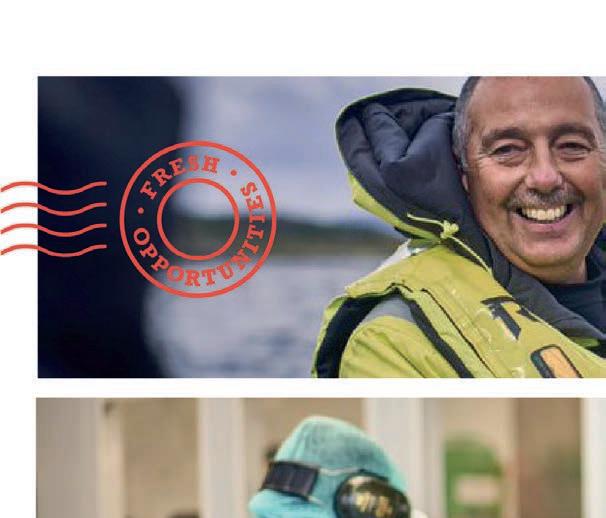











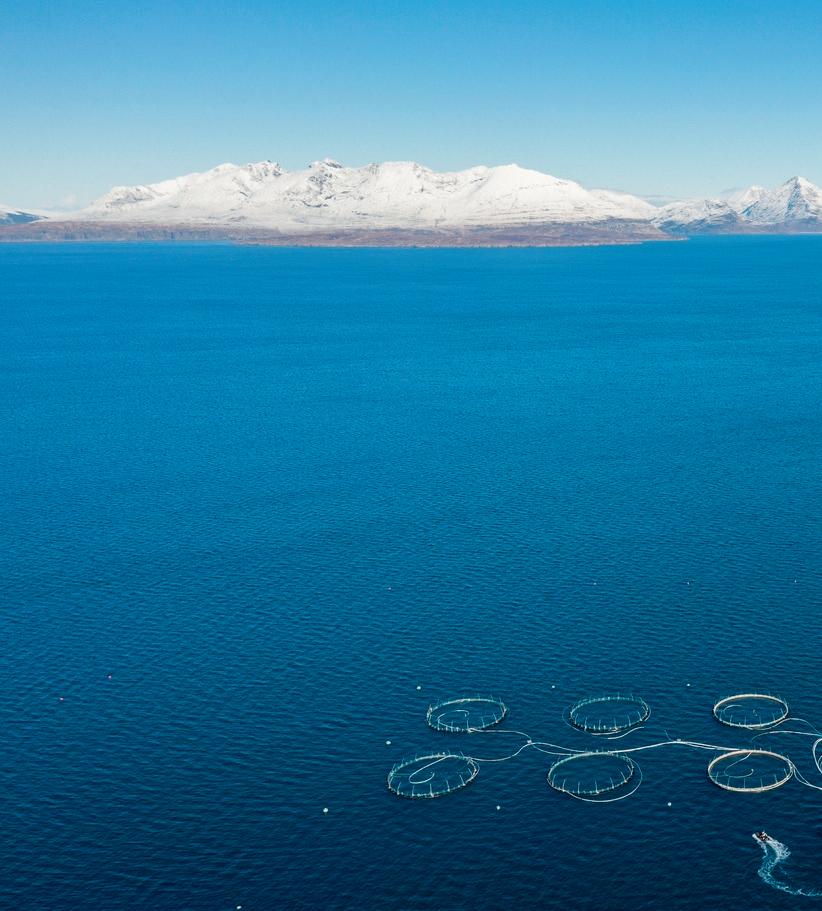
We want to hear from people who are as passionate about the planet and our products as we are.
Whether you are just leaving school, or are finishing college or university. Whether you are looking for your first job or have experience behind you. Whether you want to work in an office, on a farm, in a processing site or on a boat. Whether you want to commit full-time or prefer part-time hours.
When you take your first step with Mowi Scotland, you’re taking a step in your right direction.







Scan to discover your next career opportunity

Dura Composites designed and supplied a challenging set of two GRP (glass reinforced polymer) access structures for Barcaldine Hatchery –one at the Vacuum Waste and the other at the On-Growing RAS – each addressing critical safety and access needs for sensor maintenance and cleaning.
The access structures were required to maintain adequate headroom, using top-mounted structural support to ensure unimpeded access for personnel below.
Central overhead up-and-over supports were tailored to the project’s unique specifications. The results were two safe and reliable GRP chemically-resistant platforms with guaranteed longevity and anti-slip, non-corrosive and non-conductive properties.
Learn more at www.duracomposites.com/project/barcaldinehatchery-argyll-uk/
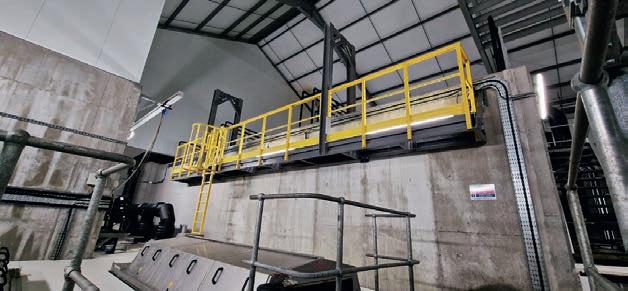
BIO-UV Group has entered into an exclusive partnership agreement with USheadquartered Pinnacle Ozone Solutions to leverage the company’s QuadBlock Ozone water treatment products in Europe, the Middle East, Africa and Asia.
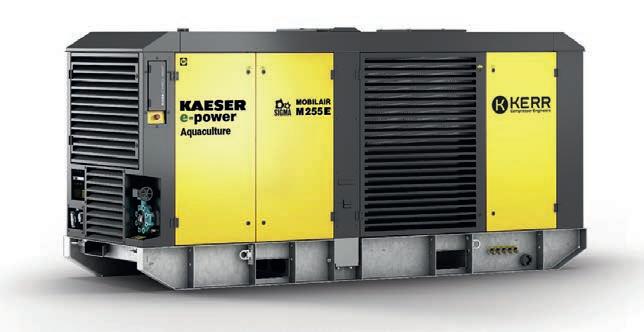
The latest KERR - KAESER MOBILAIR M250E and M255E stationary e-power portable compressors feature emissions-free, whisper-quiet electric drive, making them the perfect choice for use in aquaculture environments and low-emission or noise-protection zones.
MOBILAIR e-power compressors are perfectly equipped for onshore and offshore applications, no matter how challenging. These portable electric powerhouses are incredibly durable, compact and energy efficient, featuring flow rates up to 24.7m³/min (885cfm) and working pressures up to 15 bar (215 psi).
Across the KAESER MOBILAIR e-power range, these innovative compressors are highly versatile, simple to handle and exceptionally maintenance-free, saving time and costs.
www.kerrcompressors.co.uk
Pinnacle is one of the largest suppliers of ozone technology in the North American markets. Pinnacle’s patented advanced ozone technology will increase BIO-UV Group’s ozone productcapacity to 30kg/h and more, which will open a much larger market opportunity worldwide.
Pinnacle will support BIO-UV Group’s strategy to establish its range of water treatment solutions across North America.
Meet BIO-UV Group at Aquaculture UK – visit booth C61. www.bio-uv.com/en


Maxi-Mil trials show that enhancing moisture retention improves mill efficiency and feed usage, reducing process waste, promoting pellet quality and generating fewer fines. Rising costs have made achieving efficiency in feed production crucial. Optimal inclusion, penetration and retention of moisture within aquafeed formulations enables the efficient use of expensive ingredients to make higher-quality feed, saving hundreds of thousands in inventory loss and energy consumption. Anitox is partnering with leading food producers to produce safer food efficiently.
Learn about how Maxi-Mil helps aquafeed producers meet their productivity and quality goals by visiting www.anitox.com/aqua-case-study
In May, all roads lead to Aquaculture UK 2024, where leading aquaculture supplier RS Aqua has been shortlisted for two prestigious awards: Supplier of the Year and the Collaboration Award (the latter in conjunction with Innovasea, Scottish Sea Farms and UKRI). At the conference, attendees will get an opportunity to explore the full range of Innovasea Aquaculture products, including a real-time showcase of the all-in-one farm management system. They can also expect to receive a keynote presentation on RS Aqua’s Real Time Environmental Monitoring Systems at 11am on 14 May 2024 from Dr Ryan Mowat, Director of Innovation (pictured). www.rsaqua.co.uk

Macduff Ship Design is looking forward to delivery of a number of newbuild projects over the coming months, including an innovative 18.5m battery electric hybrid service catamaran, two mussel harvest vessels and a 21m landing craft.
Alongside these vessels, which are nearing completion, are several new design contracts for a range of aquaculture new-build projects, including a 14.95m ensilage vessel, 14.95m service catamaran, 18.5m landing-craft, 18.5m catamaran service vessel and 25m landing-craft.
Meanwhile, the company continues to develop its survey services, including Marine and Coastguard Agency workboat code surveys through the Society of Consulting Marine Engineers and Ship Surveyors. www.macduffshipdesign.com





It’s been full charge ahead for Coastal Workboats after signing a new 10-year lease agreement with Stornoway Port Authority for their marine engineering workshop at the start of the year. The months that followed have seen an ongoing roll-out of a recruitment drive to grow the company’s local team on the ground, a vast procurement exercise to kit out the new workshops and commencing the build of the UK’s first fully electric workboat. All this while the next batch of Coastal Workboats’ renowned Damen LUV2208s nears completion – with stock vessels offering immediate availability.
Get in touch today via sales@coastalworkboats.co.uk to chat further. www.coastalworkboats.co.uk


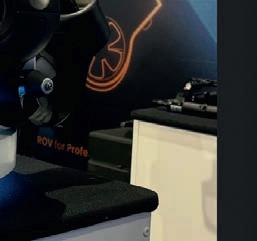
Marine services business AlphaGeo UK will be at Aquaculture UK this May, promoting the versatile range of remotely operated vehicles (ROVs) from China’s Chasing Innovation Tech Company, including the Chasing M2 Pro and Pro Max. They will also be talking about the company’s latest model, the Chasing X. Built for the toughest environments, this underwater ROV promotes omnidirectional flow resistance intelligent adjustment. The Chasing X will achieve a forward speed of four knots and lateral speed of two knots, with a maximum depth rating of 350 metres, to meet the demands of high-load operations in harsh environments.










































































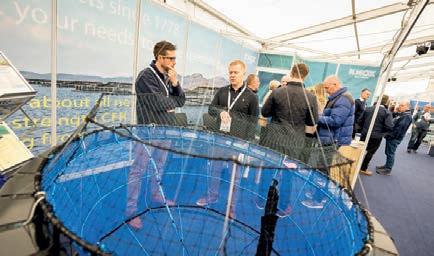

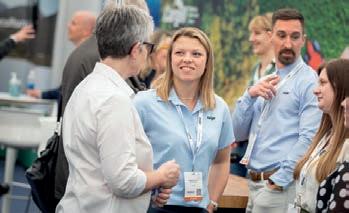

MAY 24

www.aquacultureuk.com
Aviemore, United Kingdom
May 14-15, 2024
Aviemore will once again be the venue for this biennial trade fair and conference. It is undoubtedly the most important aquaculture exhibition held in the British Isles. The show has a tremendous following and with increased investment for 2024 it promises to reach even further across the broader aquaculture markets in both the UK and Europe.
www.bluefoodinnovation.com
London, United Kingdom
May 21-22, 2024
Building Blue Resilience: Navigating Food Security, Biodiversity and Sustainability
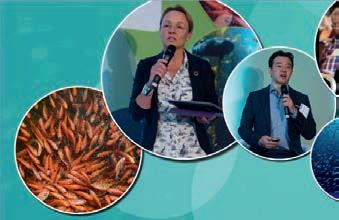
JUNE 24
www.seawork.com
Southampton, United Kingdom
June 11-13, 2024
www.seagriculture.eu
Tórshavn, Faroe Islands
June 18-20, 2024
Venue: The Nordic House
Leading conference for the seaweed sector in Europe.
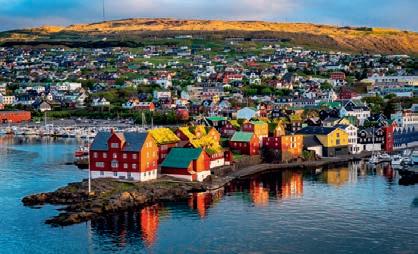
JULY 24
www.was.org
Surabaya, Indonesia
NEW DATES July 2-5, 2024
Aquaculture – Driving the Blue Economy is the theme of the conference at the Grand City next year.
AUGUST 24
www.aquaeas.org - www.was.org

Europe’s largest on-water commercial marine and workboat exhibition.

Copenhagen, Denmark
August 26-30, 2024
Aquaculture conference and exhibition organised by the European and World Aquaculture Society.

SEPTEMBER 24
www.seagriculture-usa.com
Ketchikan, Alaska
September 11-12, 2024
Leading conference for the seaweed sector in the US.
LATIN AMERICAN & CARIBBEAN AQUACULTURE 2024
www.was.org
Medellin, Colombia
September 24-27, 2024
NOVEMBER 24
AFRAQ 2024
www.was.org
Hammamet, Tunisia
November 19-22, 2024
DECEMBER 24
ALGAEUROPE 2024
www.algaeurope.org
Athens, Greece
December 10-13, 2024
Venue: Grandior Hotel Prague Conference on science, technology and business in the Algae Biomass sector.
www.was.org
New Orleans, Louisiana USA
March 6-10, 2025
APRIL 25
WORLD AQUACULTURE 2025 CHINA
www.was.org
Qingdao, China
April 24-27, 2025
MAY 25
AQUAFUTURE SPAIN 2025
Website coming soon
Vigo, Spain
May 20-22, 2025
Venue: Ifevi Fairgrounds
An international meeting space for the Spanish aquaculture industry.
JUNE 25
WORLD AQUACULTURE SAFARI 2025
www.was.org
Entebbe, Uganda
June 23-26, 2025
IADMIT that my mind might not be quite on the job at the moment. Coming back from Sicily by car has been quite an experience. Palermo driving is enough to terrify the most sanguine of people and I have seen enough of the world to know. However, we made it.
Now I move on to my son’s wedding at which I am, as usual in such cases, expected to give a speech. Though I am known for talking a lot, I actually hate giving talks and speeches, but I’ll just have to grit my teeth and get through it.
Because of the wedding, I have been much more active on the internet and have used Facebook, which is something I have done little of over the last few years. I am always interested in anything fish-related and get hooked on looking at any new item of interest on fish or fish farming.
Having done this a few times, I suddenly noticed that I was being targeted by the wild fish mob, as several ads appeared and suggested that I was a suitable candidate for their interest. How much would I like to give to their cause? Erm, I don’t think there is a figure low enough! However, I was drawn in as they are clever, thought-through and well-targeted.
I don’t suppose you would be awfully surprised to discover that I wasn’t suckered. So of course I deleted the ad. I was somewhat perturbed by the speed with which the next one from a different but similar organisation came up. This met a similar fate but it shows how coordinated and sophisticated their campaigns are becoming.
I had not encountered quite this level of thoughtfulness from these organisations. Then it occurred to me that it was inevitable. Though there are much fewer young people fishing these days, there are enough for someone to have thought of social media. Add that to the wealth of those who own salmon fishing assets and you have the recipe for a campaign.
However, their targeting must be rather difficult. The salmon fishing fraternity is dwindling and fishing is not perceived terribly well these days, especially since catch and return, a practice that is hard to justify on any grounds.
For many years, the wild salmonid lobby has been saved by the coarse anglers, who are a huge sector of the population in comparison. Not only that but they tend to vote within metropolitan areas, so they are less likely to be attacked by government. I wonder if either faction acknowledges the role of the other?
So the wild salmon campaign has a small sector to aim at. The difficulty for the wild lobby is that they don’t have many folk on their side, just a lot of wealthy ones with spare funds and good connections.
The following day, I was utterly delighted to be hit by a campaign from a fish farm company. I will not name it but it was short with a strong message and as well-targeted as the wild lobby’s messages, if not better. This is a strong contrast to the way things used to be and as we have a huge potential audience, we could perhaps be a bit more daring.
As you all know, I am not associated with any of the fish
A campaign to challenge the myths… would be hugely beneficial
farming organisations any more, so I don’t know if this has already been thought of. However, a campaign to challenge the myths around salmon farming would be hugely beneficial. People like Martin Jaffa find it hard to access the huge audience we have, yet he has continuously challenged the myths with sound, researched logic. The problem is that he isn’t getting to the people who would listen (I am assuming that the wild lobby is too stubborn and the government too blinkered).
Too often, I hear people who are mildly interested in our industry quoting myths like “dyed salmon”, when these myths are so easily debunked. In this world where trend beats logic, we need to be bold and brave, and use the best weapons we have to talk directly to the people who eat our product. If we do not, then we will find that idiots will be suggesting that – to suggest just one example – fish farts are causing more CO2 emissions than cars and planes.















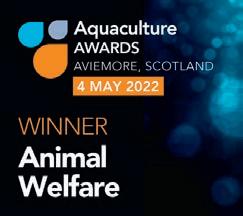



































































Pioneering a brighter future for PD control is in our DNA

www.elancoaquaglobal.com